- Home
- Camino Inglés
- Day Two Camino Teresiano
Jump to Camino Teresiano Stages
Day Two on the Camino Teresiano, Gotarrendura to Fontiveros, 25.3 Kilometers (15.7 Miles)
Day two on the Camino Teresiano is a walk through open fields, more small towns, and finally into the town where the famous mystic, St. John of the Cross (San Juan de la Cruz) was born, Fontiveros. The town celebrates his life, a contemporary mystic of St. Teresa of Ávila. He helped her reform the Carmelite order in the 16th century. He became the vicar and confessor for the reformed Carmelite nuns.
San Juan de la Cruz is also an exalted mystic poet who reveled in and wrote about the mystic Love of God. If you wish to read a short biography of Juan of Yepes, his birth name, click here.
"Contemplation is nothing else but a secret, peaceful, and loving infusion of God, which, if admitted, will set the soul on fire with the Spirit of love." ~ St John of the Cross
The open fields encountered on day two were to be typical of the Caminos Teresianos, as we walked across the high northern sub-plateau of Castillo y León, or more commonly known as the Meseta!
Maps and Stats of Day Two on the Camino Teresiano
Our day was long and hot, but not strenuous otherwise, as the terrain on day two is essentially flat. We learned quickly that we needed to leave early in the morning, and hopefully be done before 2:00 p.m. in the afternoon, before the heat of the day.
However, I did not want to leave before daybreak, as I dislike walking in the dark, and then I would have no photos for this guide! Daybreak was about 8:00 a.m. in late September, and we were easily able to finish this stage by 2:30.
Here is our interactive Google map, with the few services available placed on it. There are cafés in El Oso, Narros de Saldueña (open after noon) and Collado de Contreras, and a small tienda in Narros de Saldueña for food. Please check on current schedules before you count on anything, and it is always a good idea to carry sufficient food for your journey!
There are three pilgrim accommodations in Fontiveros, at the end of this stage. The first is a new municipal Albergue "El Descanso del Peregrinos," next to the public swimming pool. You may make reservations, and collect the keys at the Mesón Juan de Yepes (Mª José) restaurant, +34 625.033.544. This albergue is extremely basic, with cots, a bathroom, microwave and small refrigerator. Click on the link to see it. Click on the link to see it.
The next accommodation in Fontiveros, is the Casa Rural La Fonte (+34 636 03 79 55) It is possible that you will have to rent the entire home for seven, however, call ahead to see. Also available is the Posada Espacio San Juan de la Cruz (+34 920 24 53 20), a few steps north of the Casa Rural La Fonte.
It would be prudent to call ahead and make a reservation in advance, because many pilgrims, non-walking, visit the town of Fontiveros, the birthplace of the icon, St. John of the Cross, so do not be disappointed by not making reservations.
There is a public fountain in every town along the way, the greatest distance between them, six kilometers. Carrying large amounts of water is unnecessary.
As stated above, there is less than 50 meters elevation gain in any one climb, so enjoy this easy day!
Caminos Teresianos EBook
Our downloadable Caminos Teresianos Guide in PDF Format contains all the valuable information from our web pages, for comfortable reading offline and without ads on your personal device. Don't carry a heavy guide book to increase your pack weight. Use our digital guides on your next Camino instead!
Our eBook guides are packed with frequently updated information, because a digital format is more nimble than hard-copy publishing. Our eBook Guide is unique because we also entertain and immerse you with our story! Click here for more info or BUY NOW!
Jump to Camino Teresiano Stages
Photo-Rich Travelogue for Day Two on the Camino Teresiano
We left the albergue in Gotarrendura at daybreak, walking on the street out front and straight on at the first intersection. After about 100 meters, we turned left onto the Calle Mayor, toward the center of town. Here is the glorious eastern view across the fields that presented itself to us.
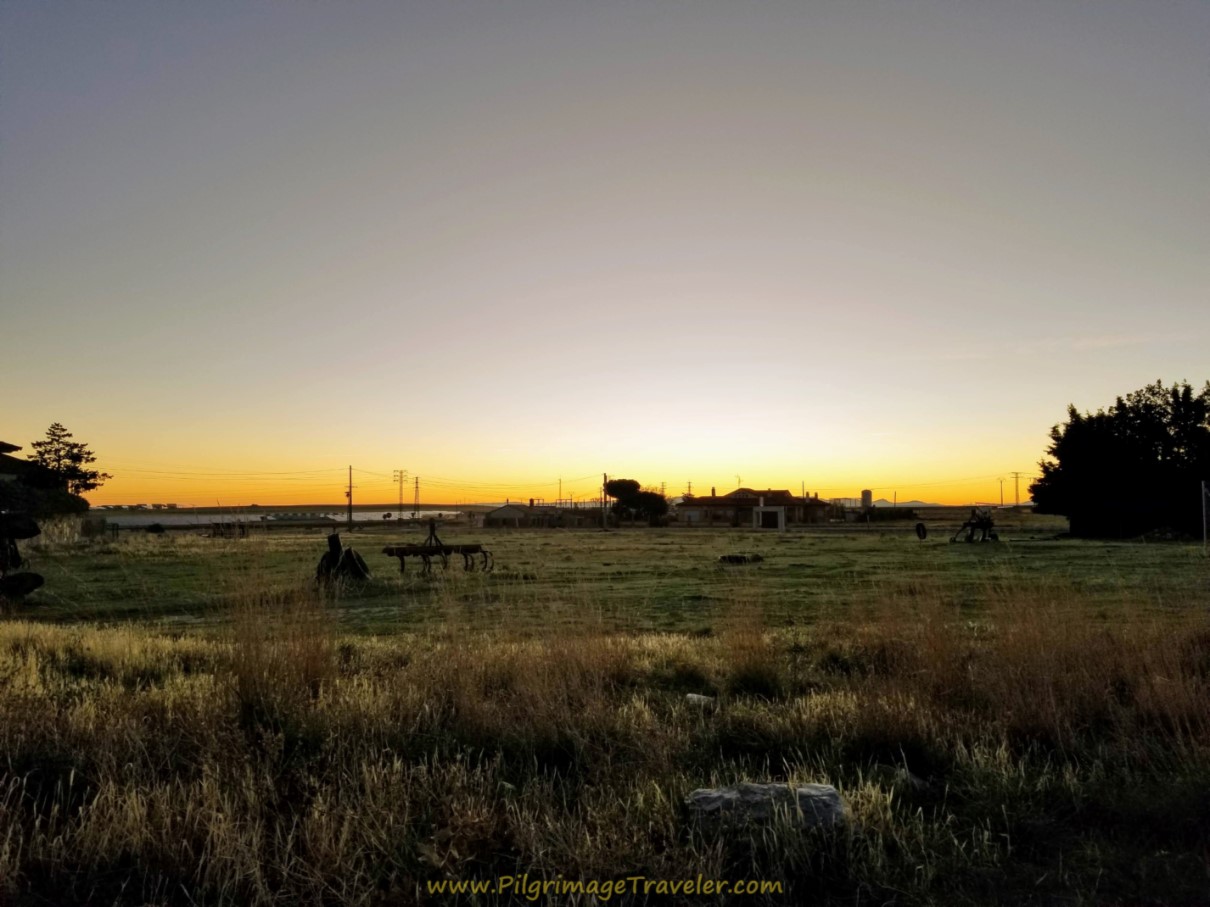 Leaving Gotarrendura at Daybreak
Leaving Gotarrendura at DaybreakIn about 150 meters you come to the main plaza, where you pass the town hall, shown below, with the flags. The town was fast asleep.
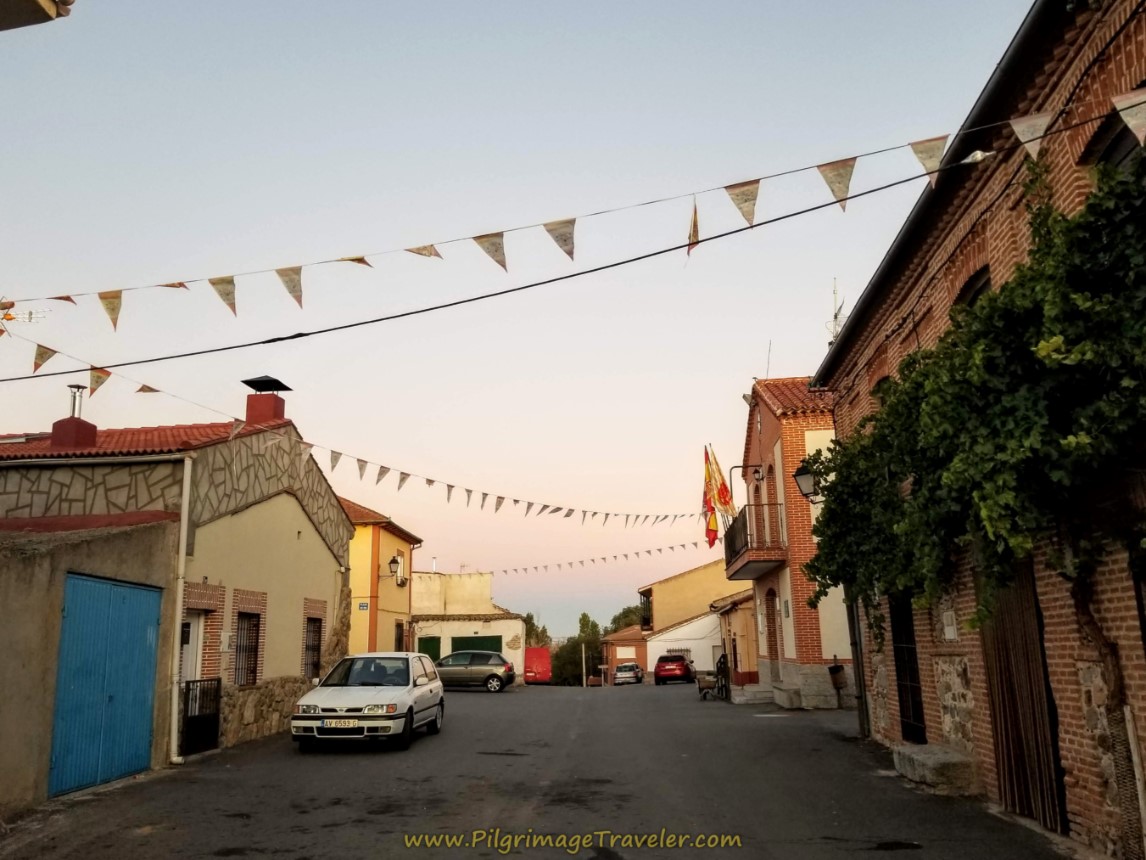 Main Square in Gotarrendura
Main Square in GotarrenduraJust after the town hall, turn right towards the Palomar de Santa Teresa. After only 40 meters, the Ruta Teresiana takes a left in front of the Palomar and onto the Calle Bajada del Oso.
In less than 100 meters, you come to the edge of town, and turn right and then left immediately onto the Camino del Oso, shown below. This is the Road to the next town of El Oso. The morning sky was glowing!
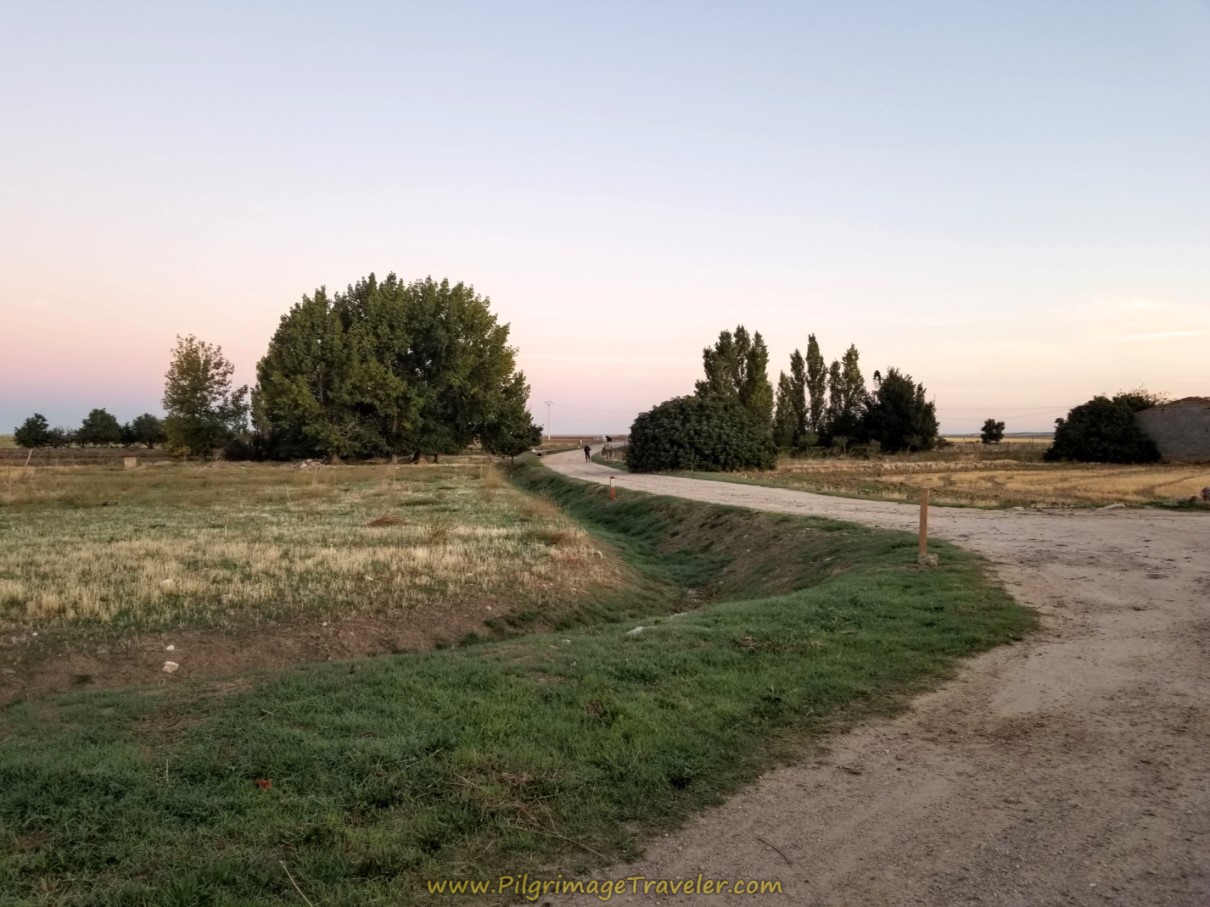 Turn Onto Camino del Oso
Turn Onto Camino del OsoThe Ruta Teresiana soon opens to the Meseta. The subtle colors of the sunrise created a very surreal and mystical glow. It was so soul-filling to be out here when the veil is thin, and feel the "loving infusion of God." This is my favorite time of the day and we walked in silence, contemplating the beauty of the moment.
The fields that surrounded us were an interesting mix of stubble that had been harvested, and new growth of what we suspected may be winter wheat.
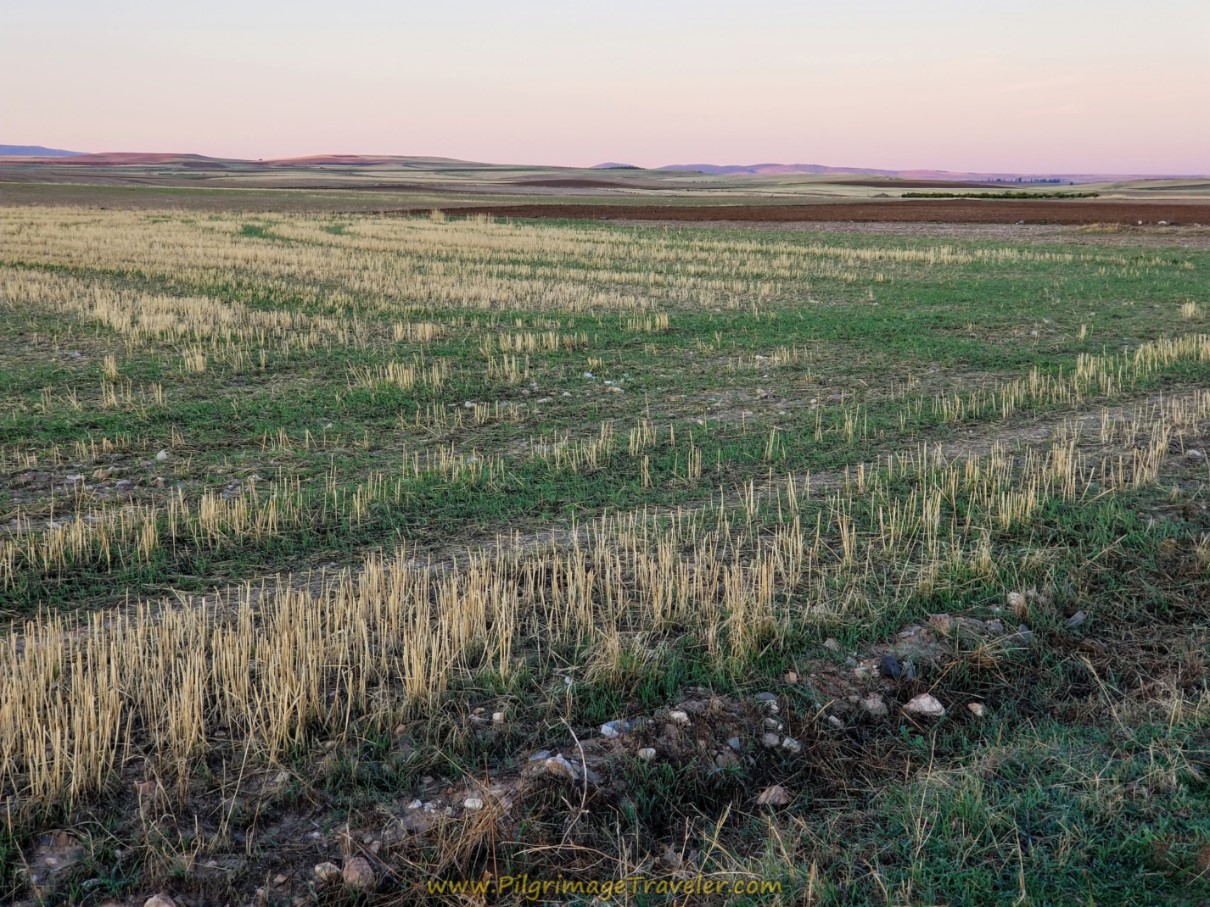 Surrounded by Grass Fields
Surrounded by Grass FieldsAs the rising sun lit up and warmed the earth, I really enjoyed the designs of plowing in the fields.
The hill climb shown above looks more impressive than it is, and before we knew it, we were at the top, with a view of El Oso in the distance.
After approximately 3.14 kilometers into day two on the Camino Teresiano, you come to this tower at the edge of El Oso.
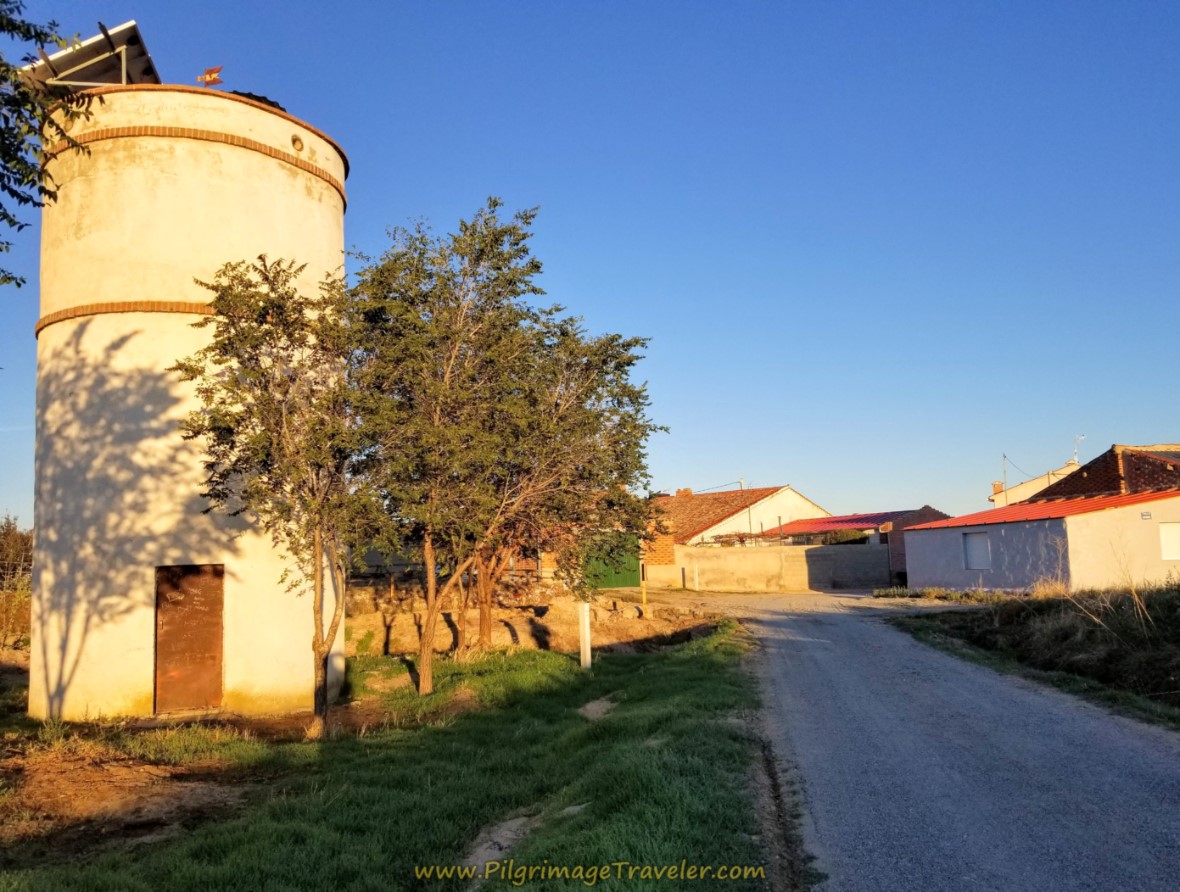 Entering El Oso
Entering El OsoAnother feature of the Camino Teresiano are the location maps in each town, like the one shown below that we also encountered just inside the town.
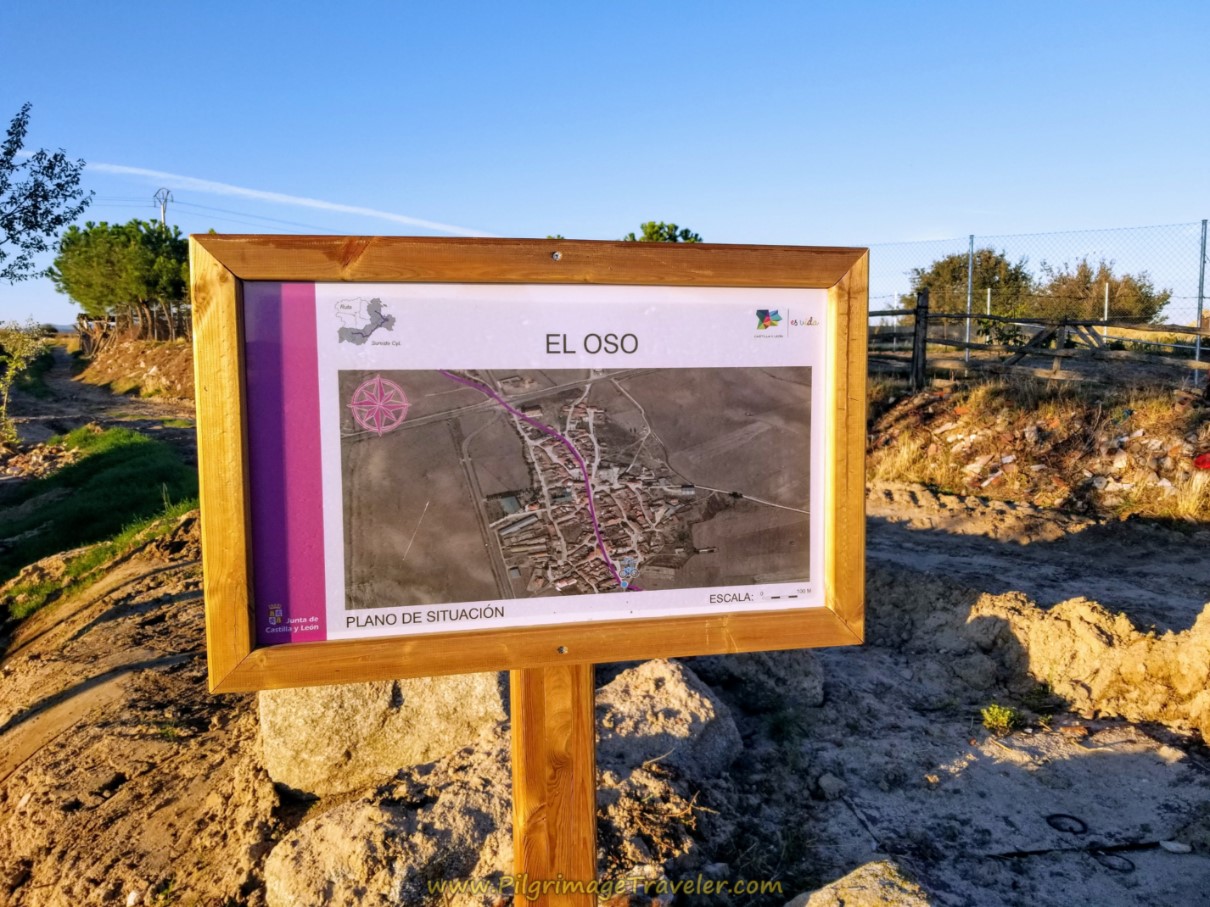 El Oso Location Map
El Oso Location MapRich stopped to read the very nice information board, another feature of this Camino, showing the effort that was put into it.
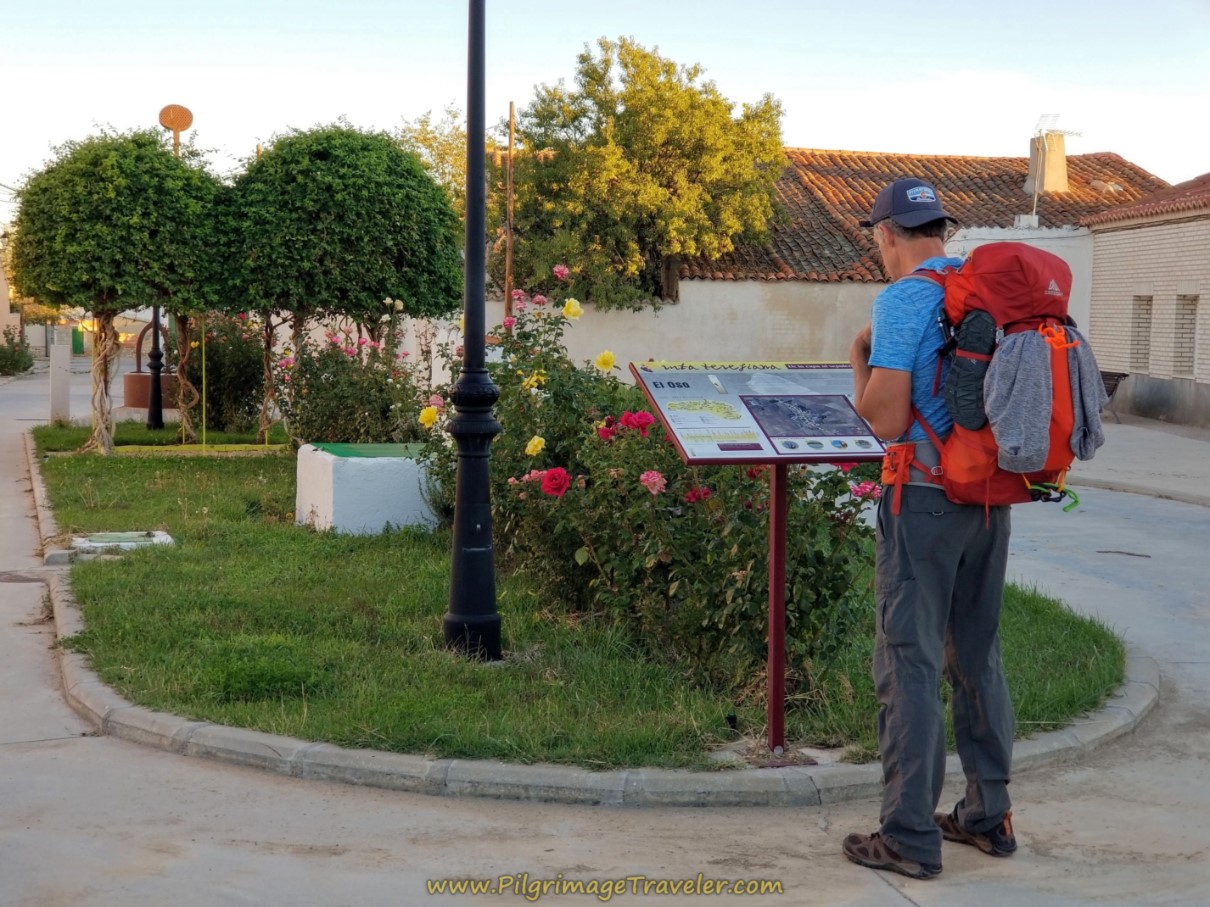 Rich Reads the El Oso Information Board
Rich Reads the El Oso Information BoardAs we walked along through town on the Calle Larga, we soon realized that this was a special place. In 250 meters, when we came upon the first sculpture, below, the sign next to it said, "Museo al Aire Libre, El Oso," or El Oso Outdoor Museum. The sign explained that this sculpture was for the "Trabajos de la Tierra" or the Earth Works.
There are old farm implements displayed here, and an old hand plow, emerging out of the man's head. The sign explains that this shows the continual thinking required for a man of the country. Interesting.
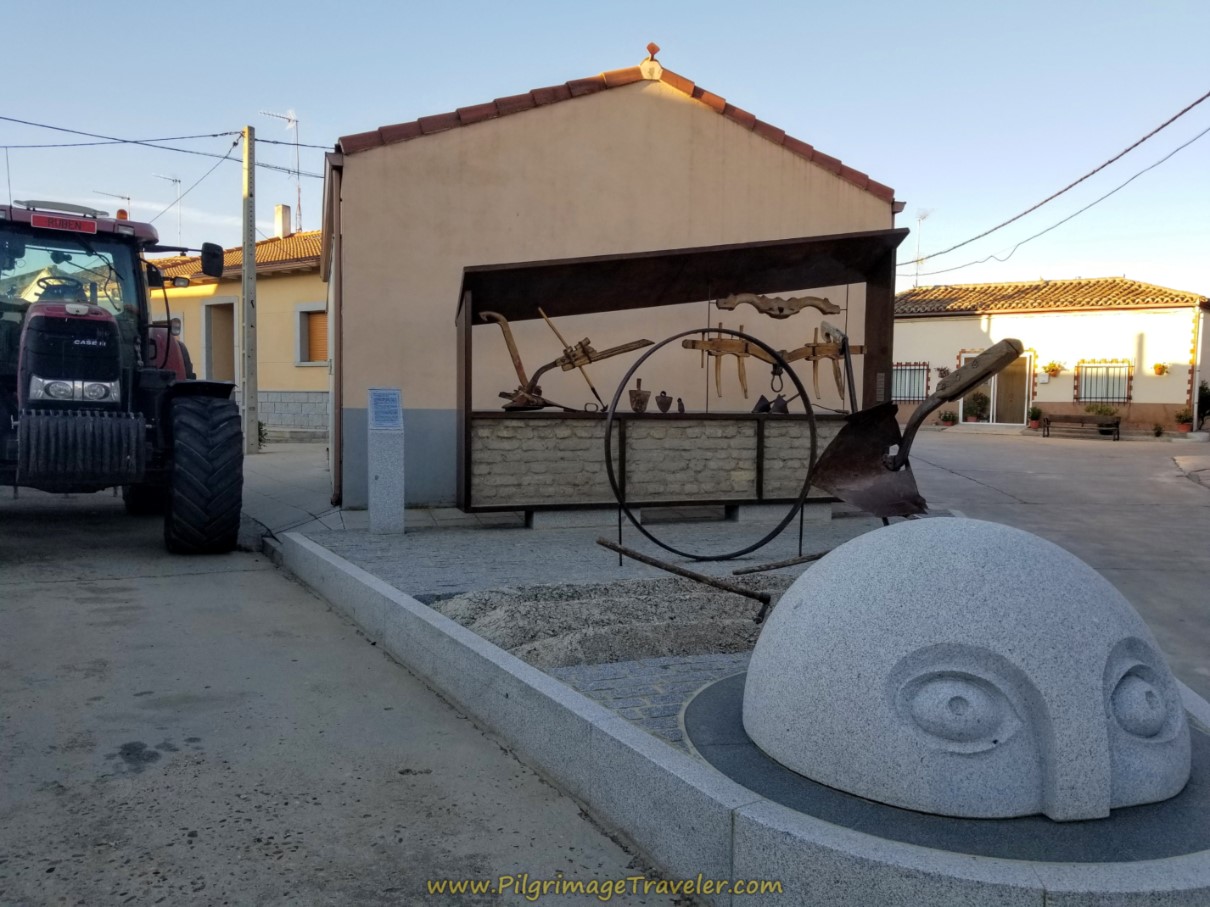 Sculpture to the Workers of the Land
Sculpture to the Workers of the LandIn only a few more meters, the sculpture below is called simply, "El Agua" or The Water. It shows the relationship between man and water and how for centuries the two have gone hand in hand.
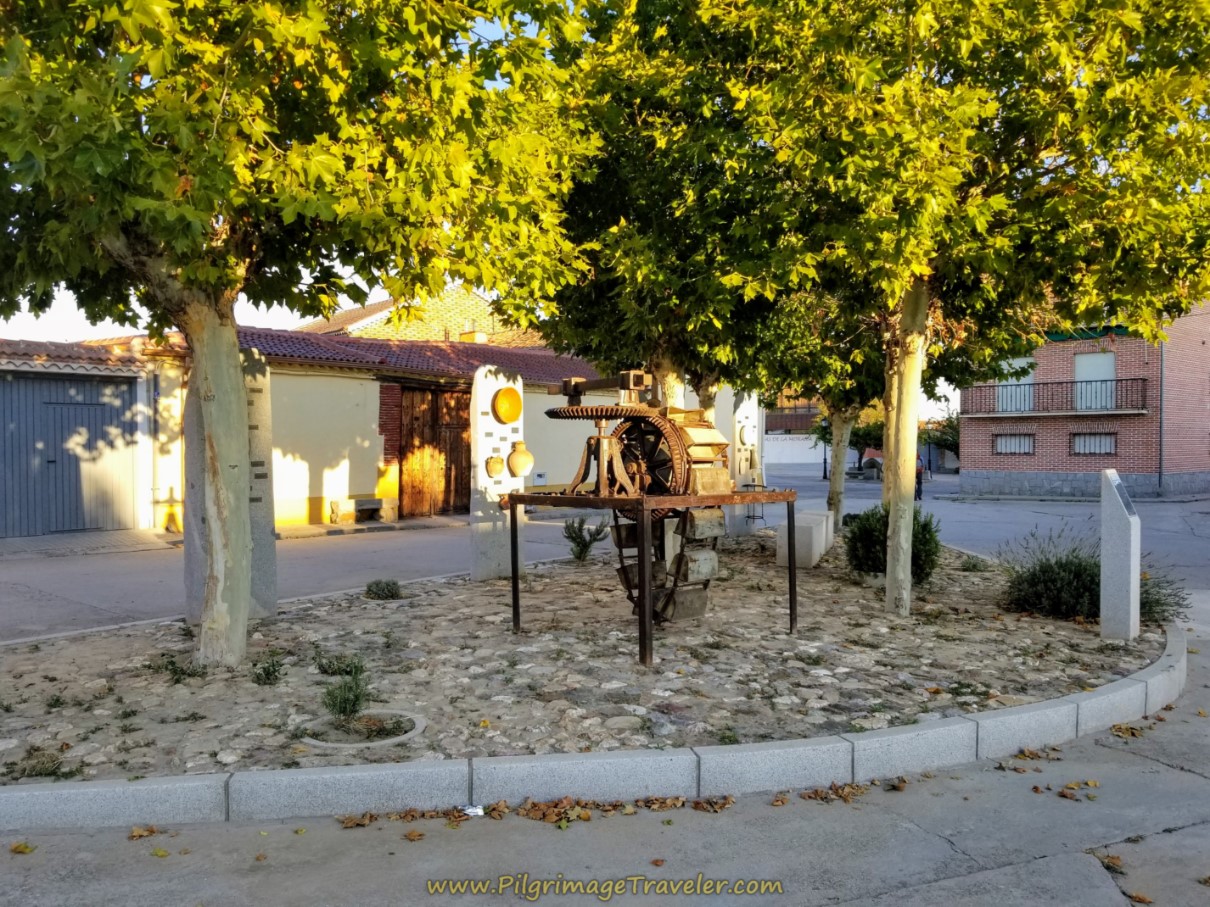 Sculpture to Man and Water
Sculpture to Man and WaterAfter only another block, the Plaza Constitucion wields a lovely butterfly sculpture. Just across from the sculpture in the plaza is a fountain with potable water, if you need it.
Only a few steps from the plaza, this wall mural to the ubiquitous stork was fun to see.
Only two blocks farther on is this sculpture titled, "Homenaje a los Religiosos y Cooperantes," a tribute to those who have dedicated their lives to the betterment of others.
On the edge of town to the north, one encounters the church and the most famous of all the sculptures, the bear sculpture, from which the town got its name. El Oso, means the Bear, in English. However, this bear-like monument is actually a Verraco, a type of prehistoric stone monument seen throughout the central plateau of Spain. The word verraco, in Spanish means "boar." Sometimes these monuments have also been thought of as bulls. No one really knows the origin or the nature of these prehistoric stone figures, but in this town it is thought to represent a bear.
At the top of the church steeple, is a large stork's nest, glowing in the sunlight, something which would be a very common sight on this Camino.
And to the right, below, is the final town sculpture, a memory tree, with descriptive commemorative plaques.
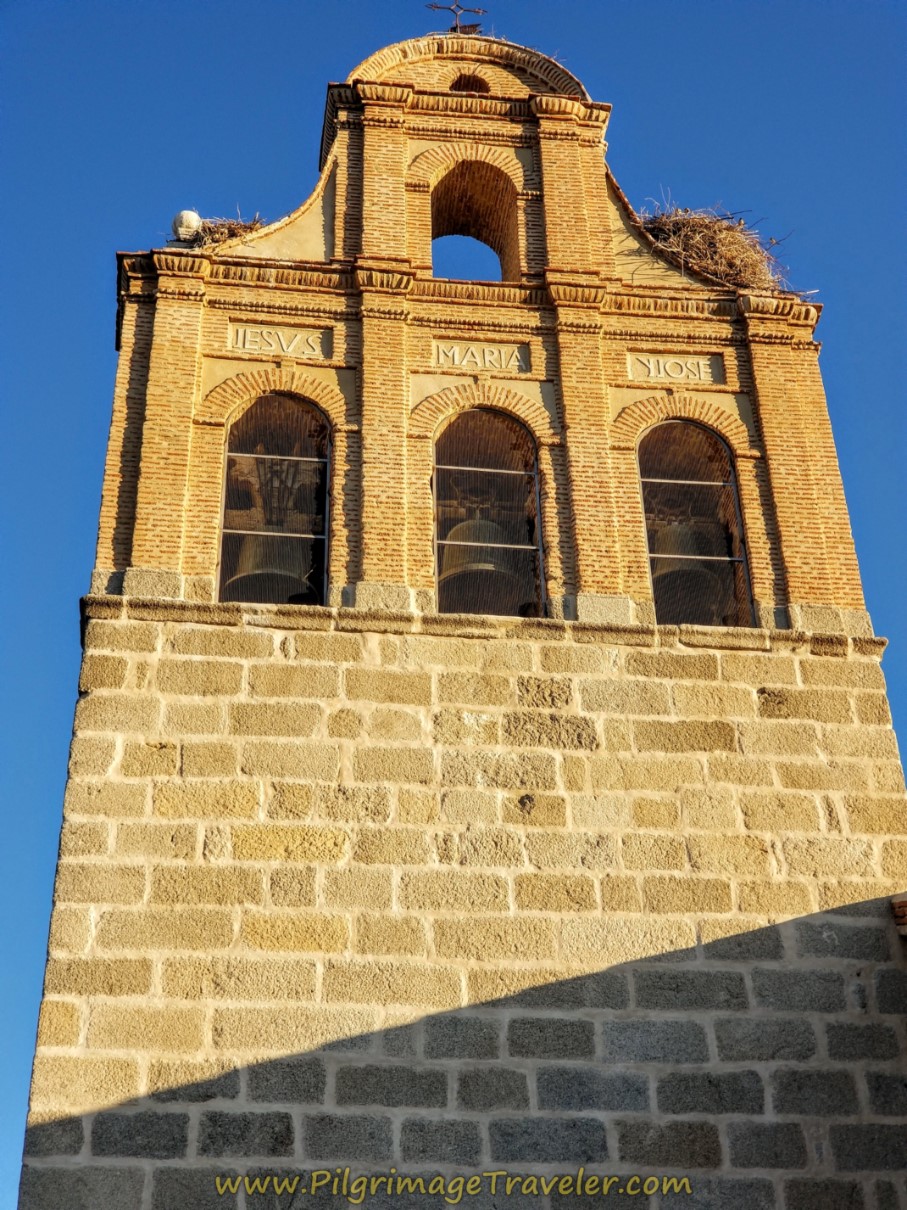 Stork Nests
Stork Nests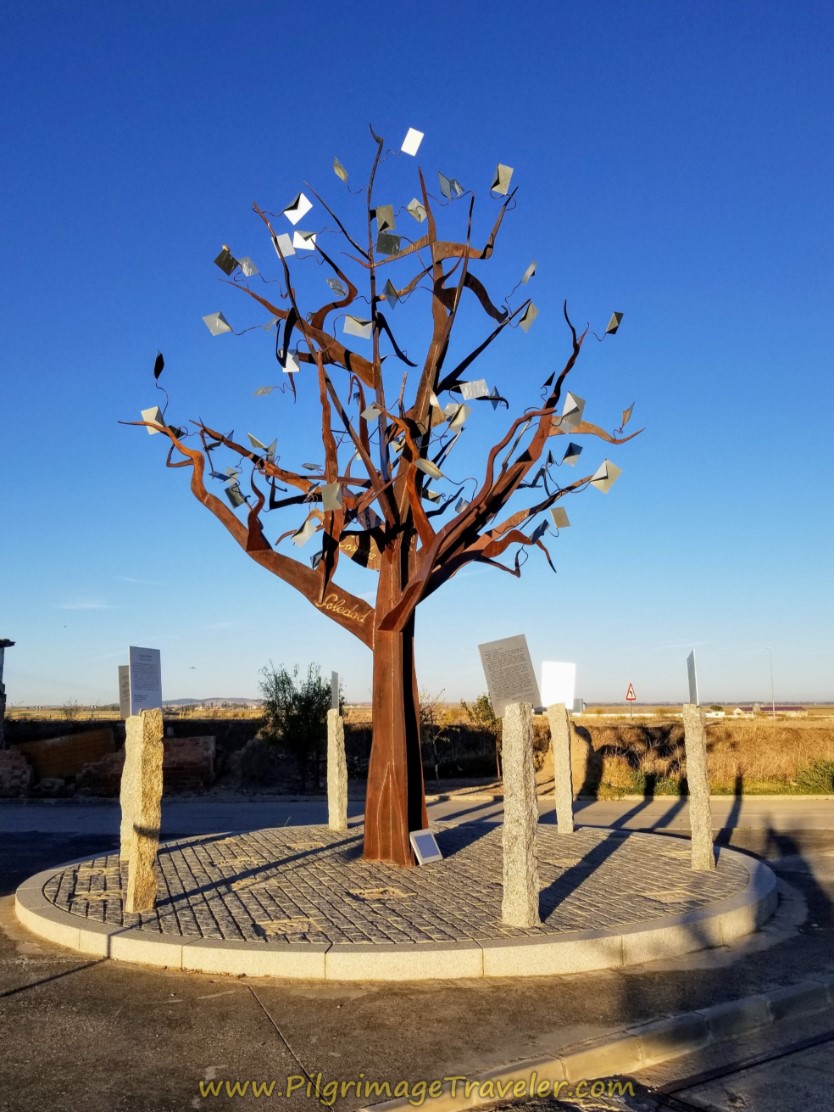 Memory Tree
Memory TreeWalking through the town of El Oso is a mere 650 meters, but we greatly enjoyed their outdoor museum and were grateful to the townspeople who had created it. They had displayed quite obviously, their love of the land and the people of the land.
There is only one accommodation in town, the Casa Rural La Lagunilla. This is a rural home for 10, and you must rent the entire place to stay here, a minimum of two nights. Not appropriate for pilgrims.
The Caverna del Oso tapas bar is a few steps east of the main route, and there is also a bakery, the Panadería Pindado that is open 24 hours! Could be a lovely place for breakfast at the bakery if you need it.
The walk through town ended at approximately 3.8 kilometers into day two on the Camino Teresiano, where we came to this roundabout, and crossed the CL-507, to head back into the countryside once again.
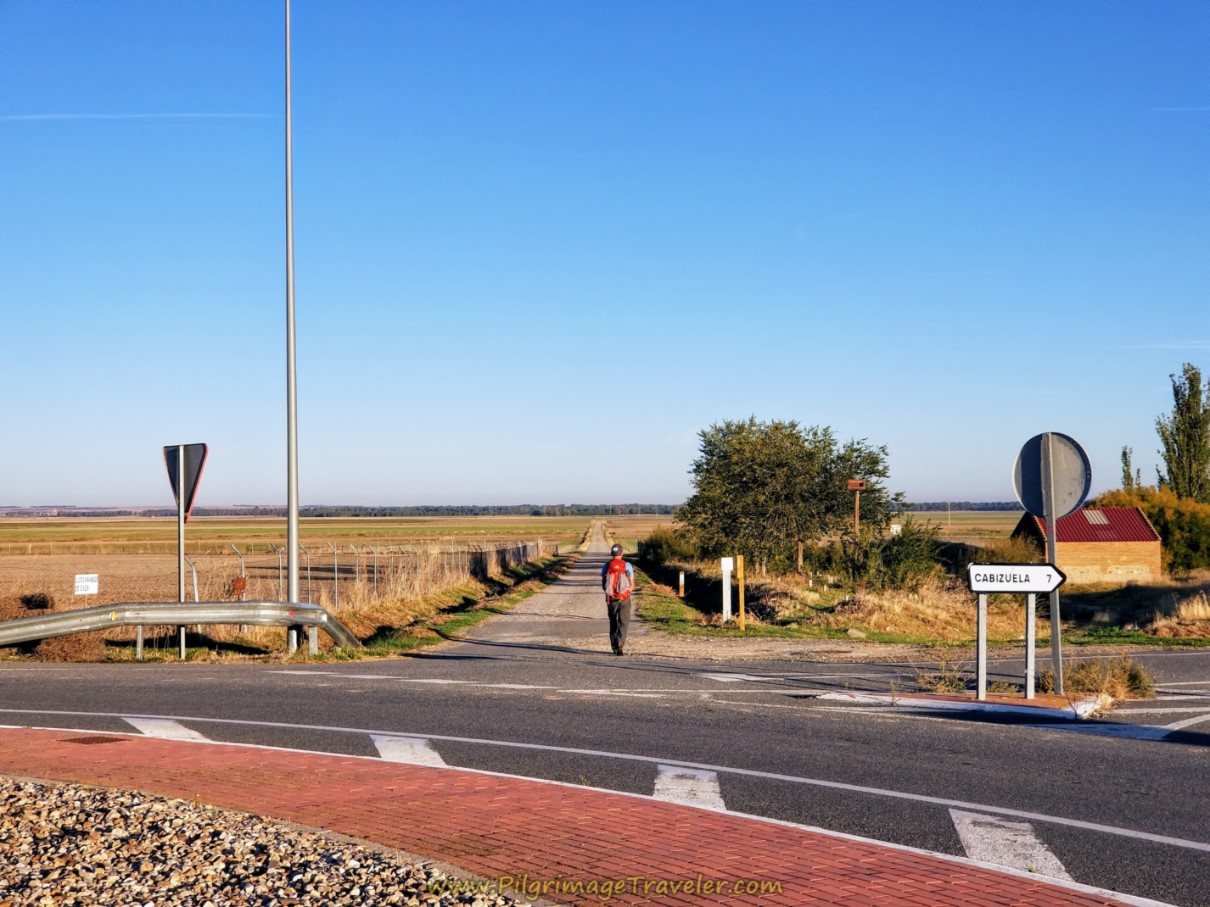 Leaving El Oso at Roundabout on day two of the Ruta Teresiana
Leaving El Oso at Roundabout on day two of the Ruta TeresianaJump to Camino Teresiano Stages
Up ahead, as we left town, we could see a discrete area of trees, an unusual sight for this area. It appeared that we were heading directly towards it. This is the Lagunas del Oso de La Moraña. Click on the link to learn more about this natural area.
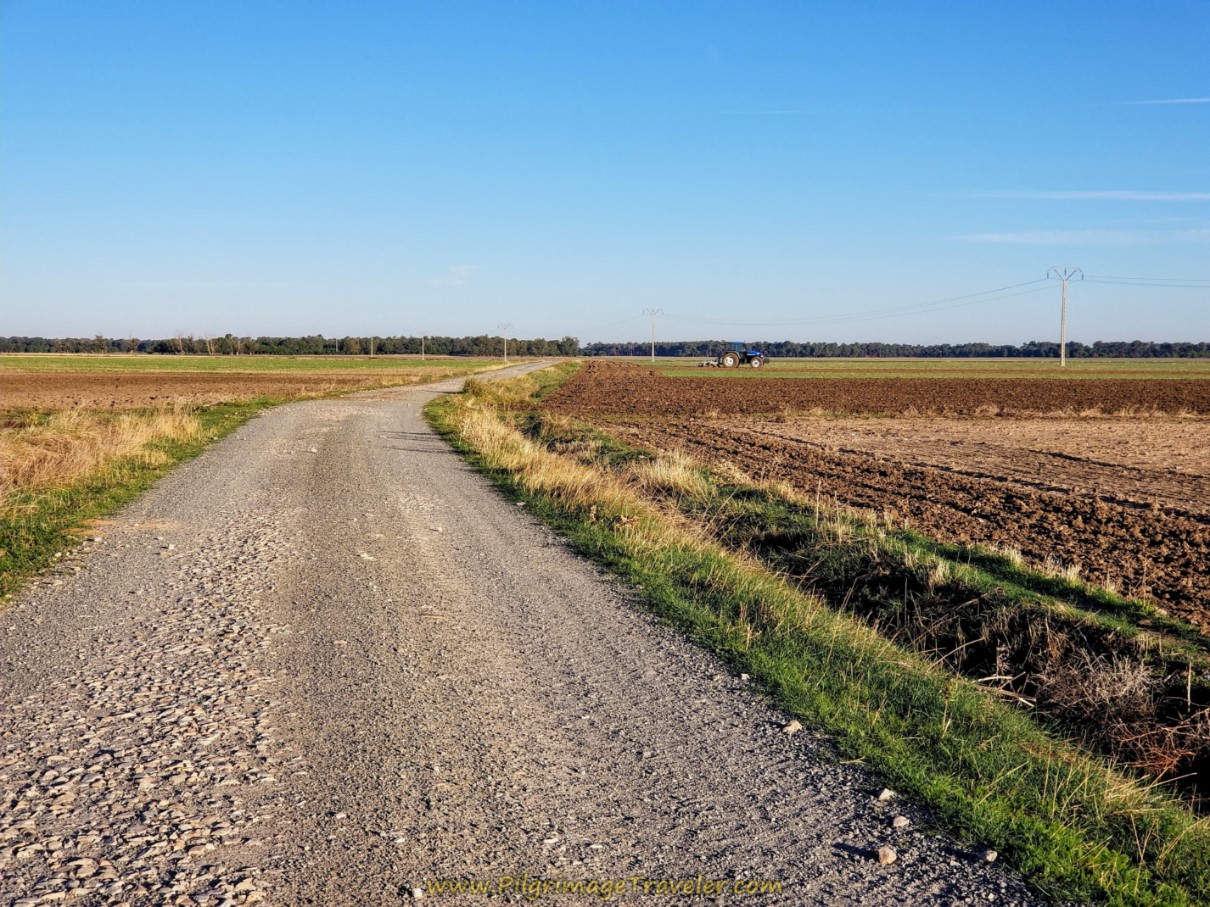 Open Road Towards Papatrigo
Open Road Towards PapatrigoIn this open area, we could see in the distance the Central Mountain chain of Spain to the south, the geographic division between the northern sub-plateau where we were and the southern sub-plateau.
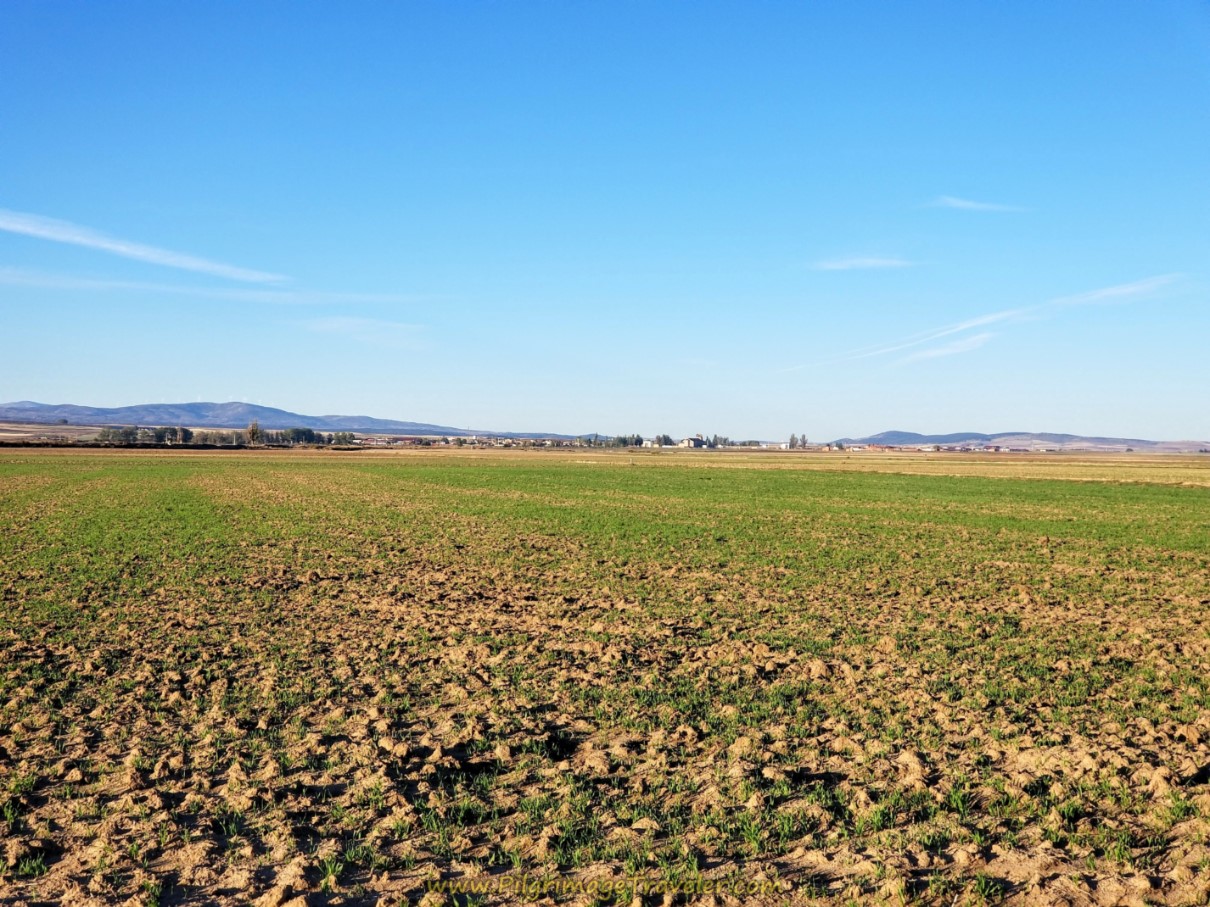 Central Mountain Chain of Spain to the South
Central Mountain Chain of Spain to the SouthAfter 1.75 kilometers from El Oso, you come to this Y-intersection, closer to the Lagunas area now, and you stay to the left.
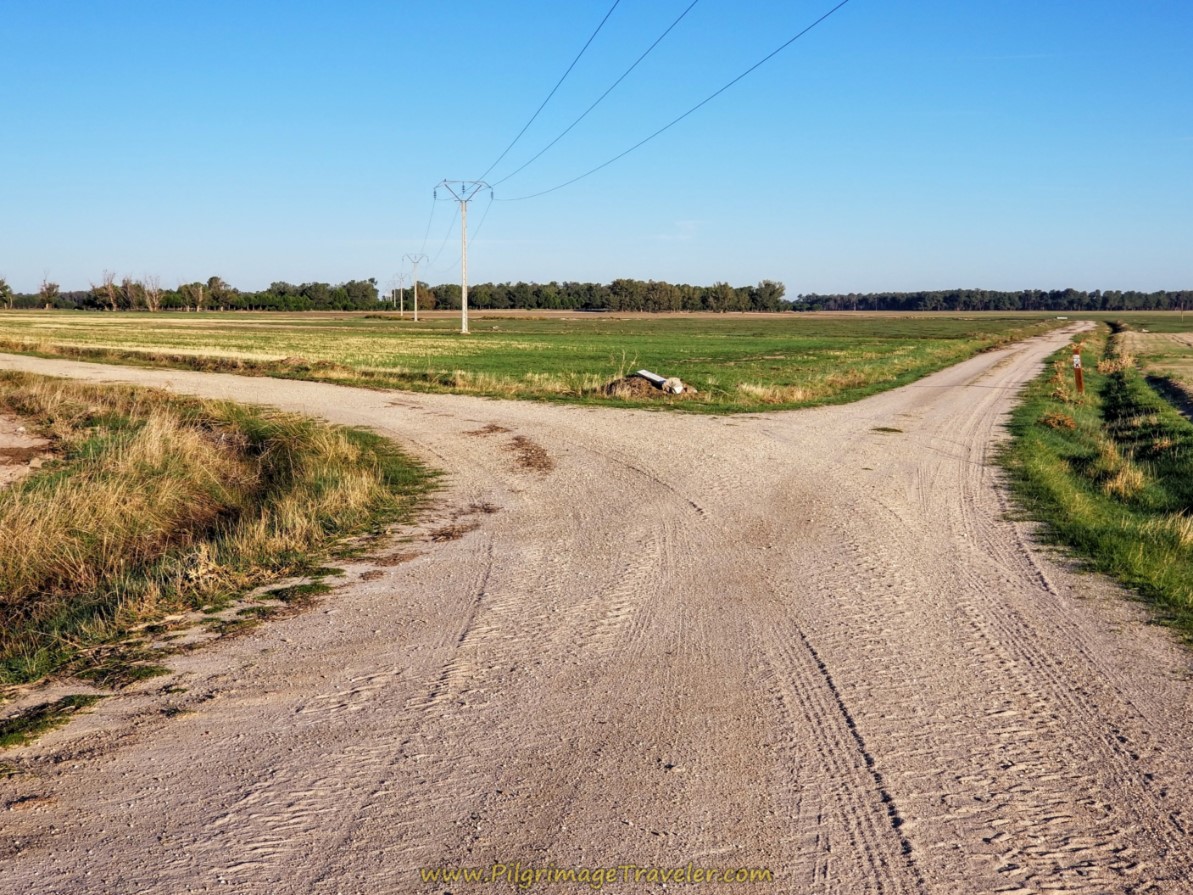 Left at the Y Intersection
Left at the Y IntersectionIt is almost 3.0 kilometers from El Oso when we entered the woods or the bosque preserve, for a total of 6.75 kilometers into day two on the Ruta Teresiana.
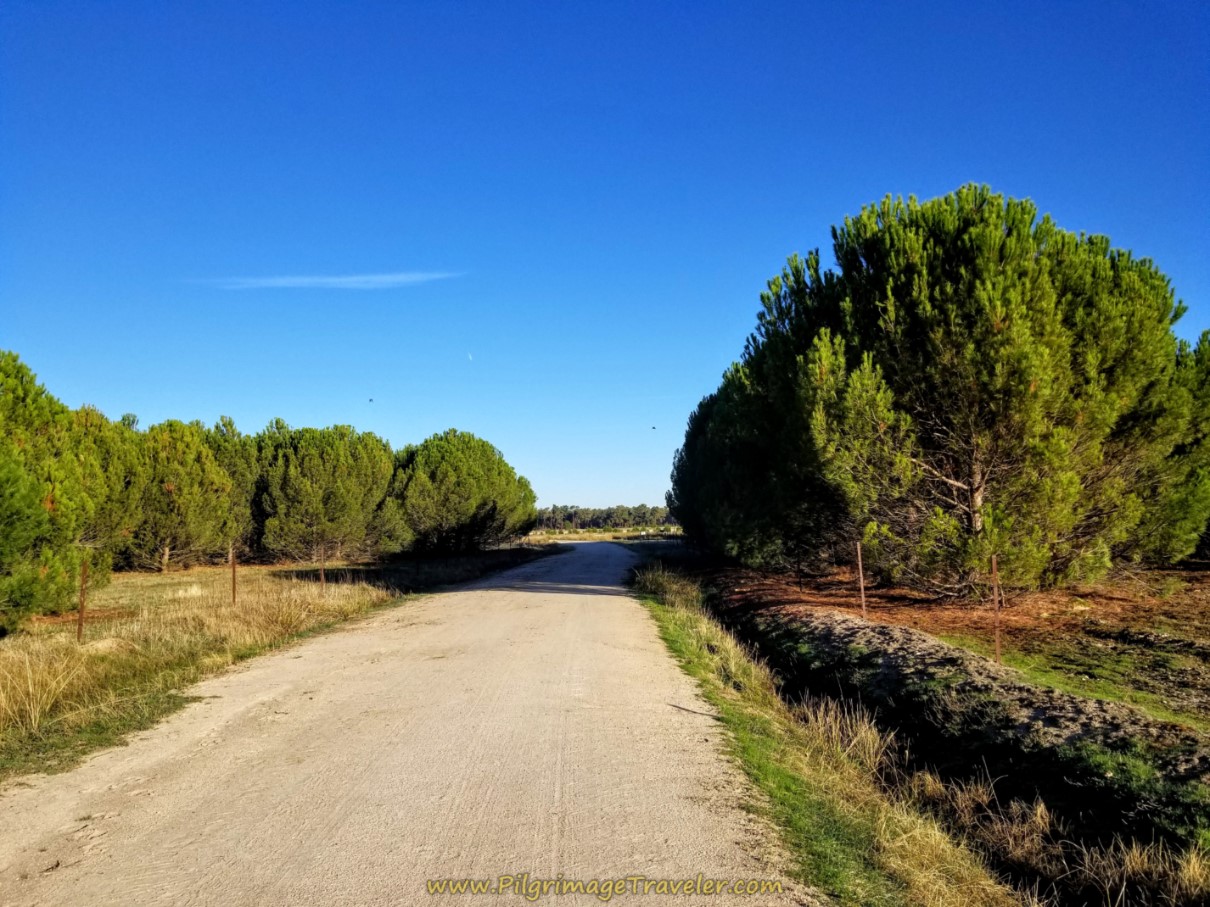 Into Wooded Area
Into Wooded AreaThere were some very large pine trees, where the locals were collecting the pine sap in buckets hung in the trees, shown below.
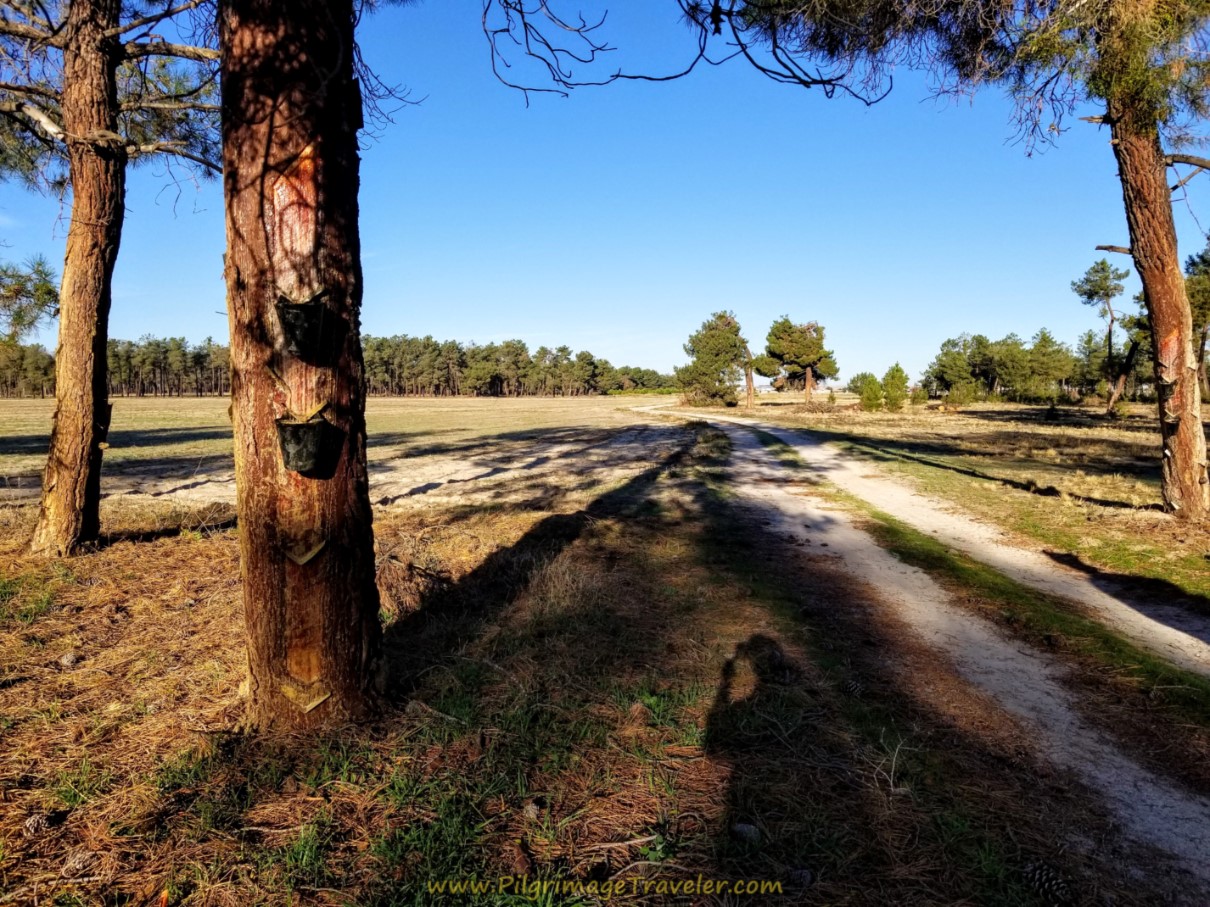 Collecting Pine Sap
Collecting Pine SapThese old bent over pines are evident of the harshness of this area!
Our walk through the scattered trees of the preserve was a brief 1.5 kilometers. We emerged after the large pine trees, back on the open lanes, with the town of Papatrigo now in sight.
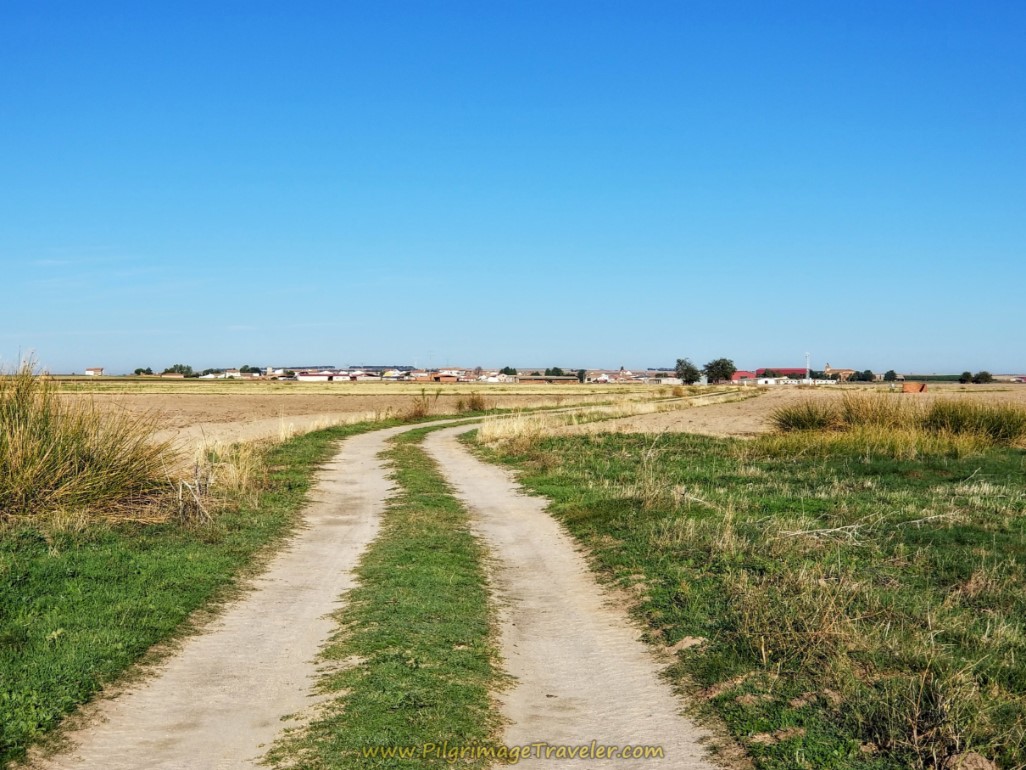 Papatrigo Ahead
Papatrigo AheadStaying straight on and following the frequent waymarks, we approached the town. We were seeing local walkers into and out of this bosque, but no pilgrims with backpacks.
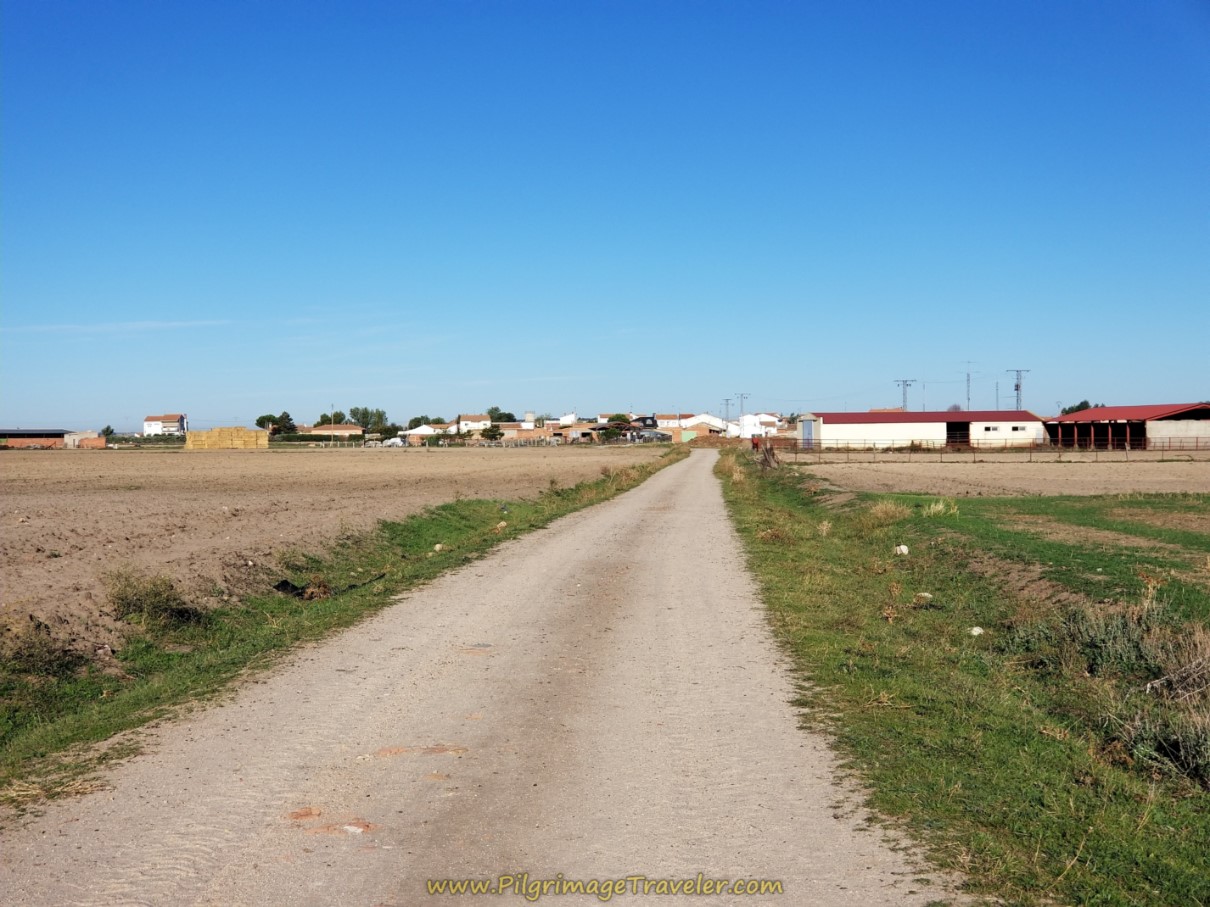 Papatrigo
PapatrigoWhen you reach the edge of Papatrigo, at 9.5 kilometers, you see the information boards and a bench to rest if you need. Continue to walk straight on and through town on this street, the AV-P-110.
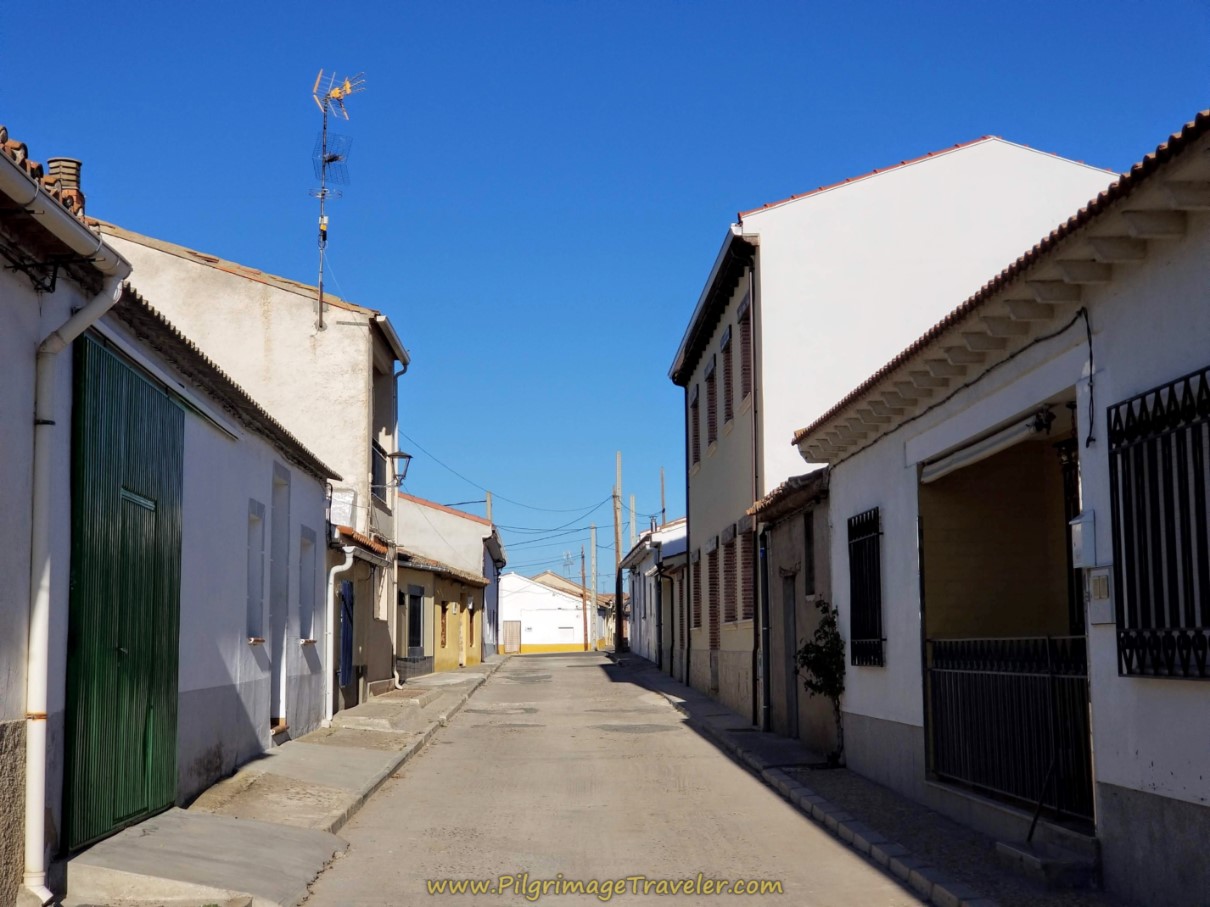 Walking Through Papatrigo
Walking Through PapatrigoThere is not much historic value or beauty in this town. We did pass a public fountain by this old building.
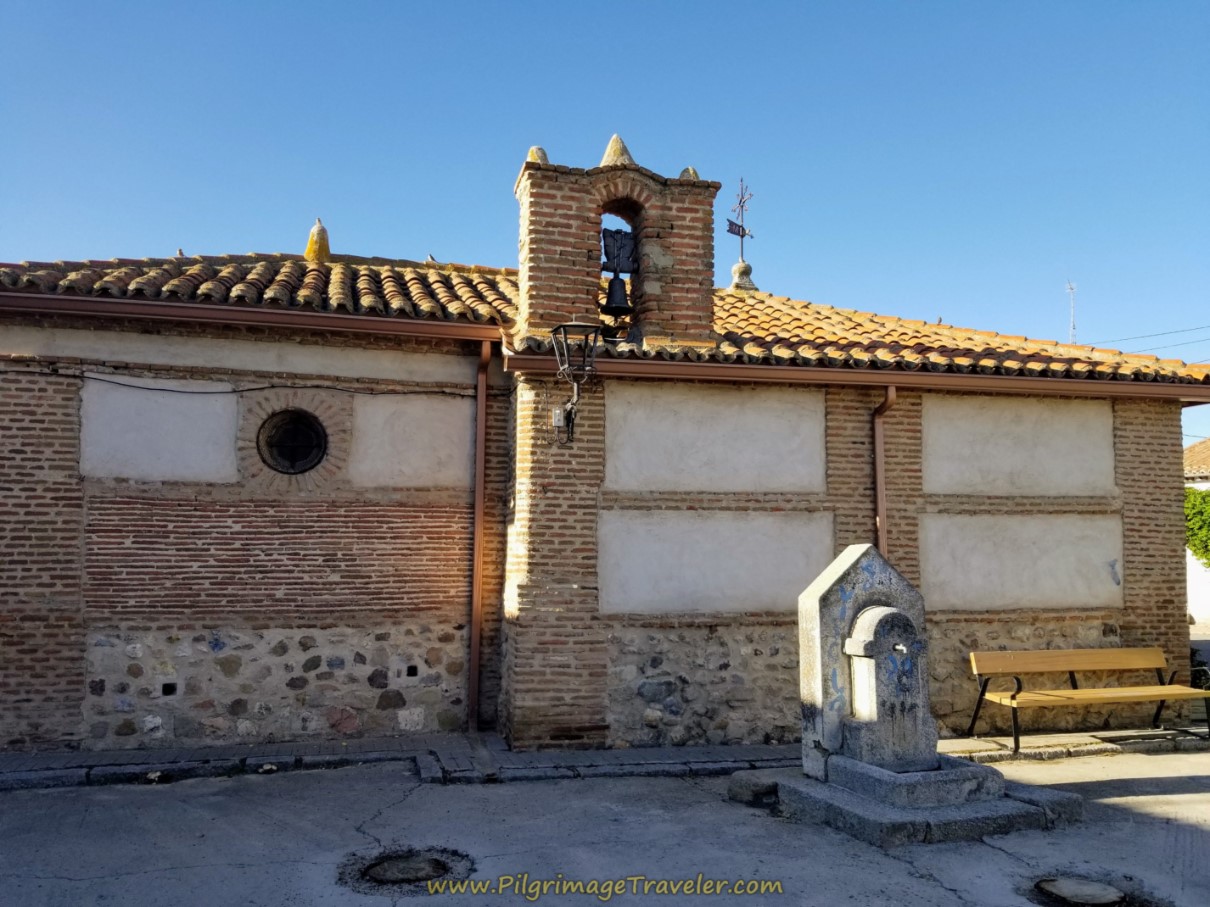 Plaza Montalvo and Fountain
Plaza Montalvo and FountainThere used to be a bar along the way in town, just before the town square, shown below, but alas, it is now gone, a result of the pandemic, I am sure.
This square is a lovely shaded area, surrounded with stone benches, yet another fountain, and another stockade-type structure for holding horses for shoeing. Turn left here at this plaza.
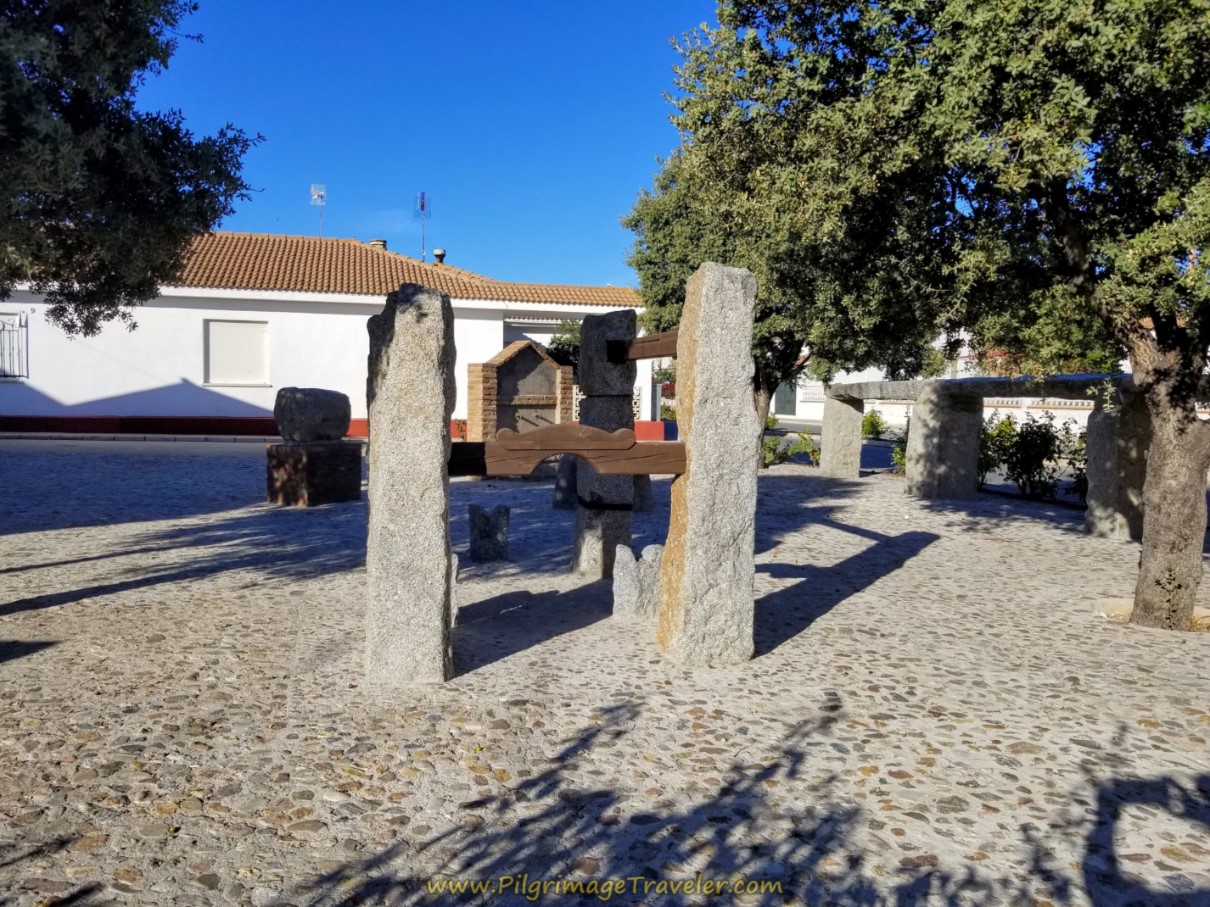 Left Turn After Stockholder
Left Turn After StockholderThere is only one accommodation in Papatrigo, a distance south of town, a casa rural called the El Caminero. It requires a minimum stay of two nights, for 3-5 people and is quite expensive, so nothing again, for the pilgrim here.
After the turn at the plaza, a walk of 200 meters along the Calle Pablo Portero, brings you to this intersection with a tower and a beehive-like structure. Turn right. At this intersection you are about 10 kilometers into day two of the Camino Teresiano. The walk through Papatrigo is only 1/2 kilometer total, short and sweet!
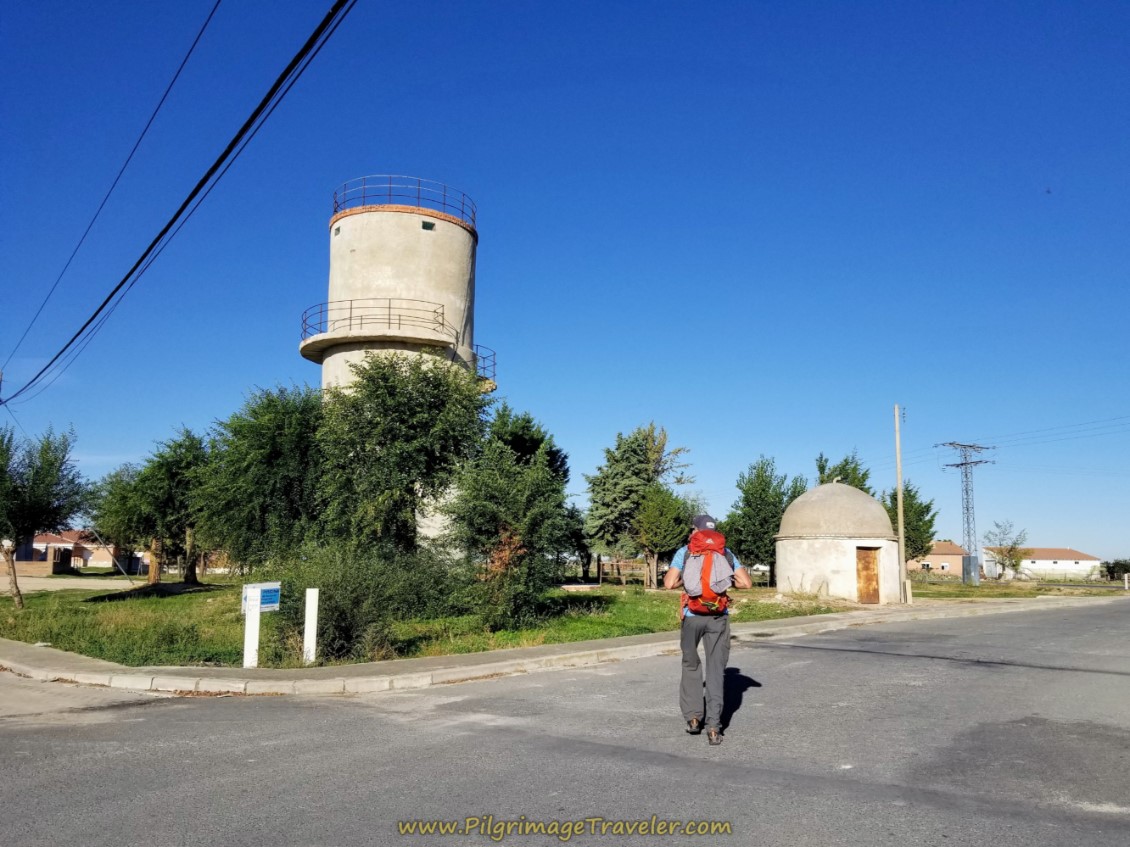 Right Turn at Tower
Right Turn at TowerAfter walking 80 meters, the main road veers off to the left, but we stay straight on to take a northwest bearing that led us by this sheep pen. There were two geese that came racing towards us, squawking away, to warn us off! We laughed and carried on.
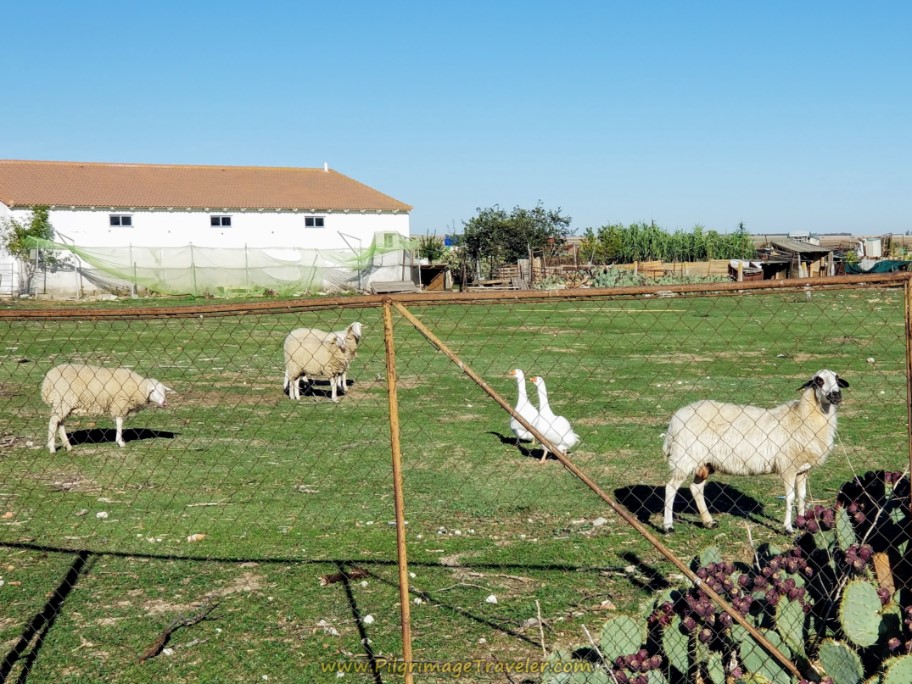 Straight on at Sheep Pen
Straight on at Sheep PenAs soon as you leave town, the next town of Narros de Saldueña, about 3.0 kilometers away can be seen. The high castle of the town is easily spotted towering above the rest of the buildings. You walk for 1.3 kilometers on the open lane that leaves Papatrigo. Come to an intersection and turn left.
It is a long straight shot of about 1.7 kilometers from here into Narros de Saldueña. This tractor passed us along the way.
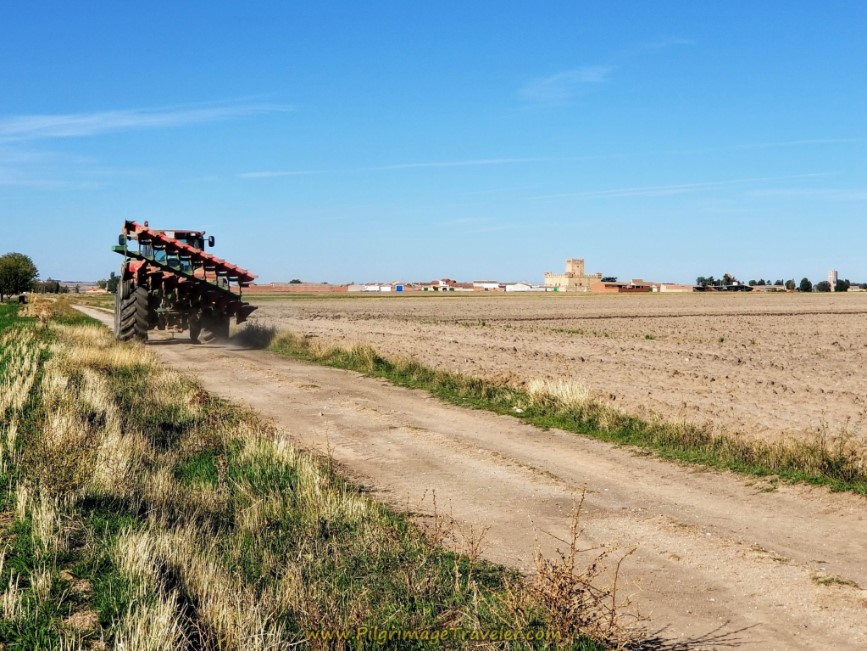 Tractor and the Castillo de Narros de Saldueña
Tractor and the Castillo de Narros de SaldueñaAs you get closer to Narros de Saldueña, the Castillo del Duque de Montellano rises ever closer.
At the information board, when you reach town, after approximately 13.2 kilometers into day two, the Ruta Teresiana stays straight on, but if you want to see the castle, take a right hand turn onto the Calle Lopez. Walk north, past the flags flying at the town hall, as the Tribute Tower of the castle enters your line of sight.
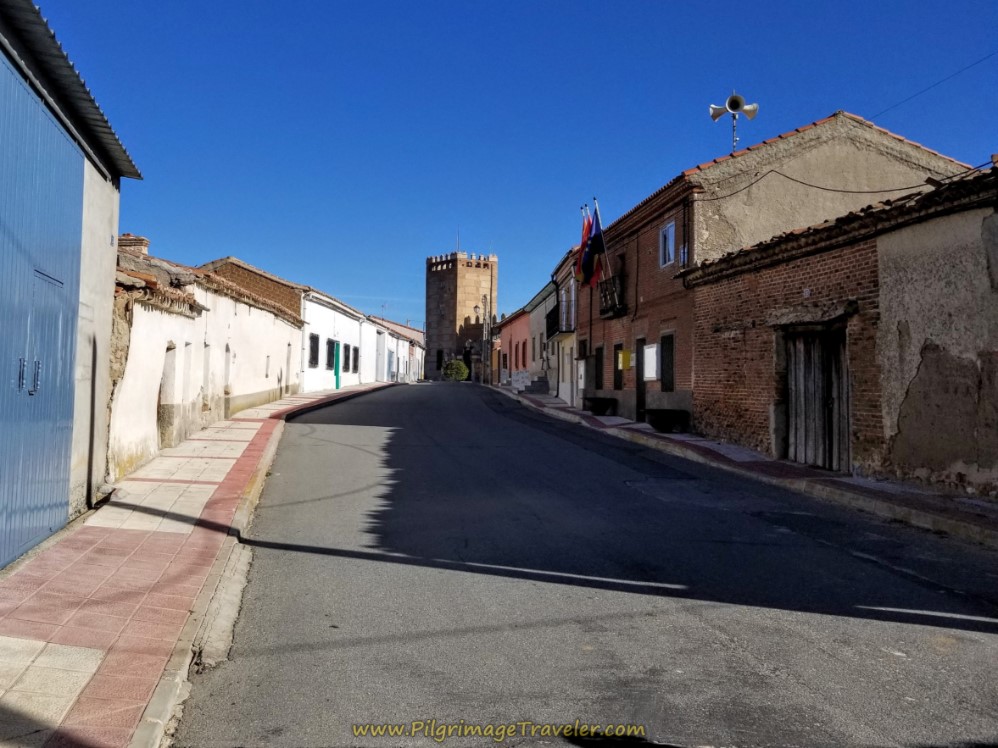 Right Turn in Town for the Castillo
Right Turn in Town for the CastilloThe castle is barely 300 meters off-Camino and it is a glorious sight. Built at the end of the 15th century in the Morrish Mudejar style, and without any natural defensive element, it most likely was a residence instead of a "castle." It is the Torre del Homenaje, the Tribute Tower that stands high above the town buildings and above the plain. For more information on this castle, click here.
While most websites regarding the castle state that it is not open to tourists, a local who happened by while we were admiring it, told me that it is open on Wednesday mornings. It was Saturday. Bummer. May you have more luck when you arrive. It would have been delightful to see inside.
We continued north a few more meters, then turned left to see the town church and hopefully find a café. The Bar El Castillo is right beside the church and it was closed tight when we walked by. Bummer #2. Its normal hours are noon to midnight.
There are absolutely no accommodations in this town.
Jump to Camino Teresiano Stages
Camino Teresiano, Spirit of Love on Day Two
We asked a local if there was a café in town, and we were pointed towards the small tienda, just down the street called the Comercio Hermanos Jiménez. We barely picked out its blue doors and awning, and went inside. We bought Aquarius, cheese, bread, muffins, cookies and water.
The proprietress and her son were very curious about us, and we struck up a bit of a conversation. Again, they were astounded that we had come all the way from the USA just for this walk. We were asked if we wanted a stamp, which of course we did. This was the only place to get one, on the entire day two of the Camino Teresiano.
We set off again, but found a nice bench in the shade, along the street to sit down and have our drinks and picnic lunch. A very friendly elderly Spanish man walking by, stopped to have a chat with the curiosities!
Shortly another man on a bicycle came along and stopped. Oh boy! He asked us if we lost a "bolsa pequeña?" I thought for a minute, shook my head no. Then I asked, what color was the small bag? He said "white." Hmm, we had little white cloth cosmetic bags that we carried in our packs. Rich was rummaging through his pack at the tienda to retrieve his credential to get stamped. Could he have dropped it?
Then, I told the man on the bike that maybe it was our small bag. What he answered, I just didn't quite understand. My Spanish is elementary at best. The man on the bike pulled out his phone and made a call. After the call, while we were struggling to communicate, along came a car around the bend, and in it was the proprietress of the tienda's son! Suddenly a light came on!
What the local on the bike was trying to tell me, was that the man in the car had raced after us, down the lane toward the next town of Collados, to return our "small bag" to us! When the man in the car jumped out, showing us our bag, I threw my hands up and thanked him profusely, giving him a kiss on both cheeks as is the European custom! My soul was filled with love and gratitude for these kind and helpful folks.
What an amazing show of support for us crazy pilgrims that this young man and his mother had shown! I was so very grateful. Our break on the side of the street had allowed the town to find us, to return our bag to us.
I am sure we would have gotten along just fine without the small cosmetic bag, but it was so soul-fulfilling to be a part of their lovingkindness!
Back on the Camino, at this funky old bridge, we continued westward toward the next town.
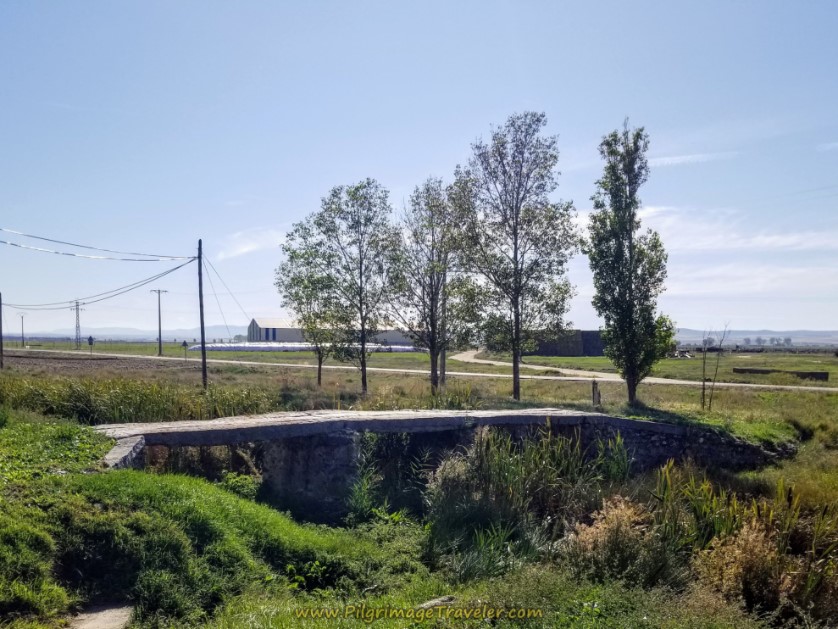 Old Bridge at Town Exit
Old Bridge at Town ExitThe next stop, about 6.0 kilometers away, was Collado de Contreras. Here is the hot, open road that led us there.
In about 2.0 kilometers, you come to a large intersection, but continue on straight.
After about 5.0 kilometers of nothingness, all of a sudden, up ahead we could make out two buildings on the horizon. These would turn out to be the historic churches of Collado de Contreras.
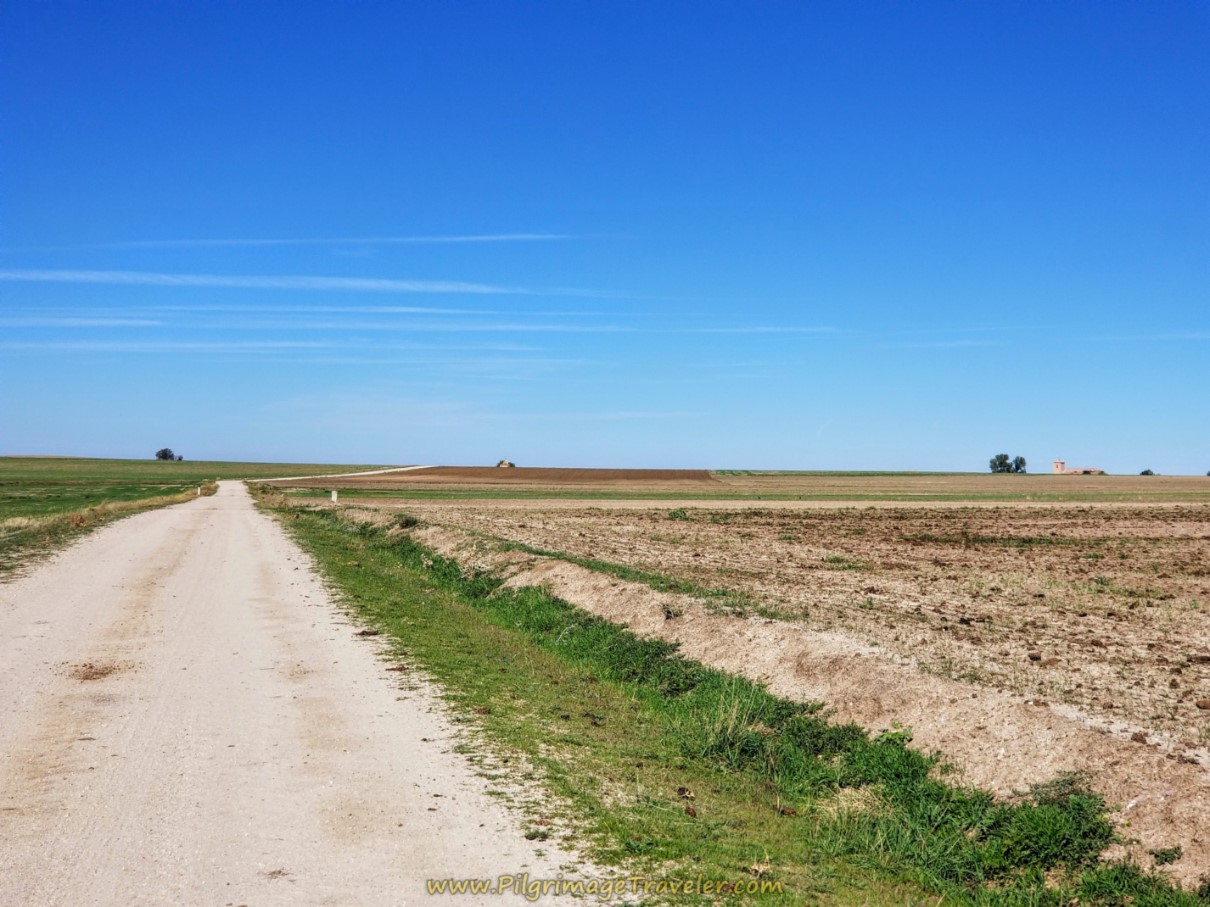 Churches of Collados Visible on the Horizon
Churches of Collados Visible on the HorizonThese two churches could be more easily made out as we got closer to town and after we crested the rise in the land.
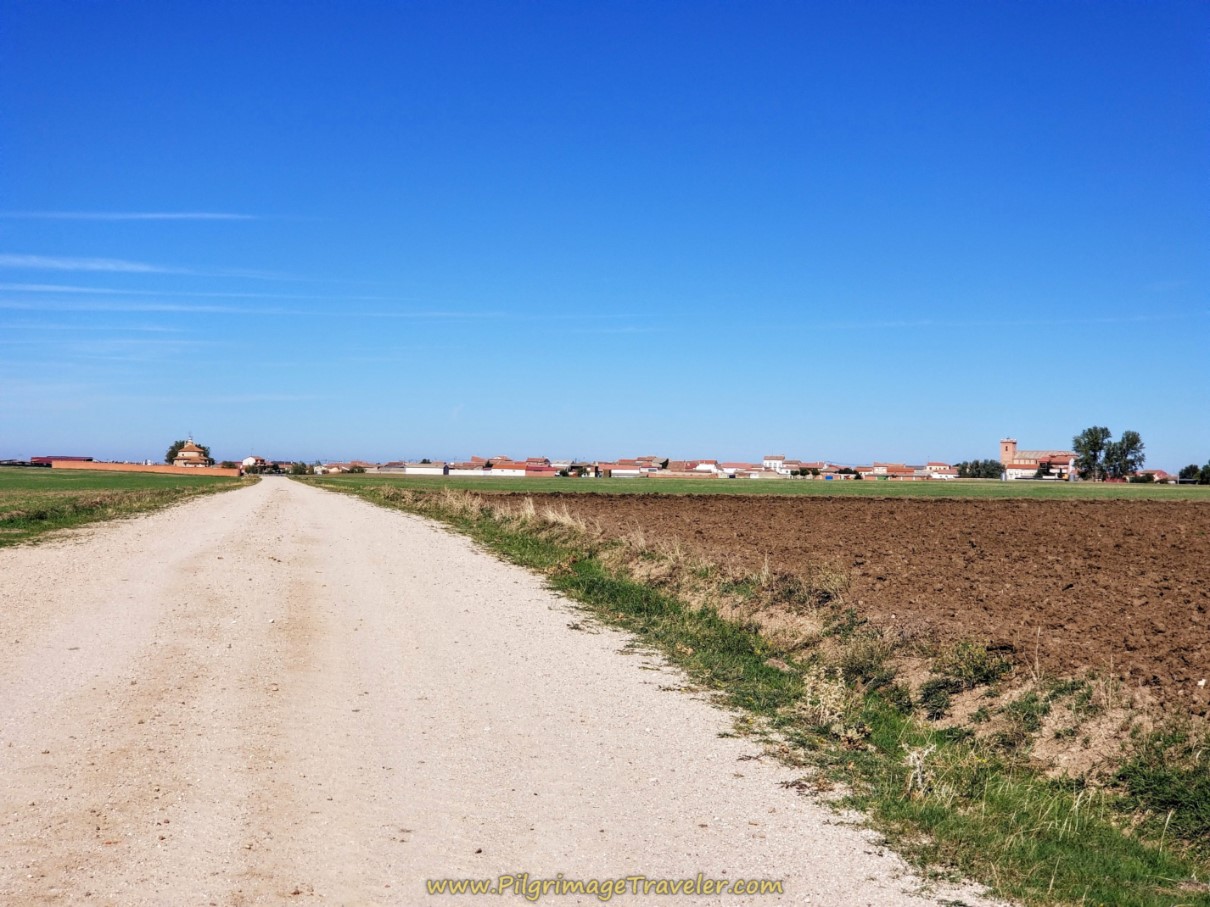 Collado de Contreras Ahead
Collado de Contreras AheadAfter 18.8 kilometers, we reached the first historic church, the Ermita de Nuestra Señora de las Cuatro Calzadas, or Our Lady of the Four Roads.
The shade trees in front of the church invited us to stay awhile, so we sat and had cookies. The church was closed, and I am unable to find any online references for the history of this place.
After the Ermita, you continue on about 350 meters, cross a paved road and enter into Collado de Contreras town proper, by the pond, shown below.
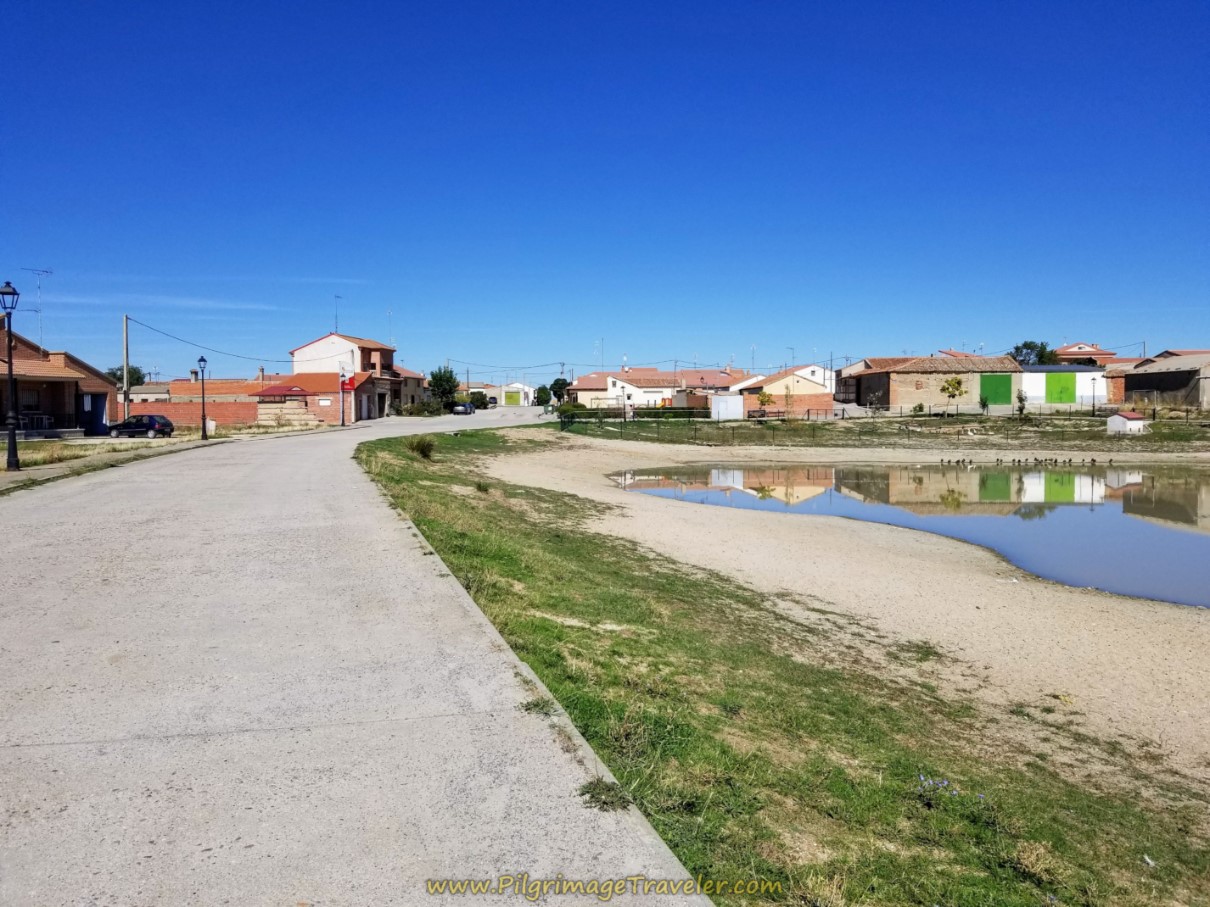 Entering Collados by Pond
Entering Collados by PondIf you want to see the 2nd historic church, the Iglesia de los Dolores de Nuestra Señora, shown below, you must take a detour, off-Camino for only about 400 meters. Turn right onto the Calle Acera del Sol immediately after the pond shown in the photo above. Alas, this 15th century church was also closed. To have a look inside, click on the link provided.
It is a wonderful edifice, worth a visit even if you are only able to view the outside. There is also the Bar Plaza, a block from the church if you wish to take a break here in town. There are no accommodations in Collado de Contreras.
Jump to Camino Teresiano Stages
Fontiveros is another 6.1 kilometers away, and we decided to push on and get out of the heat of the open road as soon as possible. It was after 1:00 p.m and already quite hot.
From the main intersection at Calle Larga in Collado de Contreras (without adding the detours into two towns), you are at about 19.5 kilometers into day two on the Camino Teresiano.
After about 1.5 kilometers from Collado de Contreras, you see and eventually pass this chicken farm, by staying straight on.
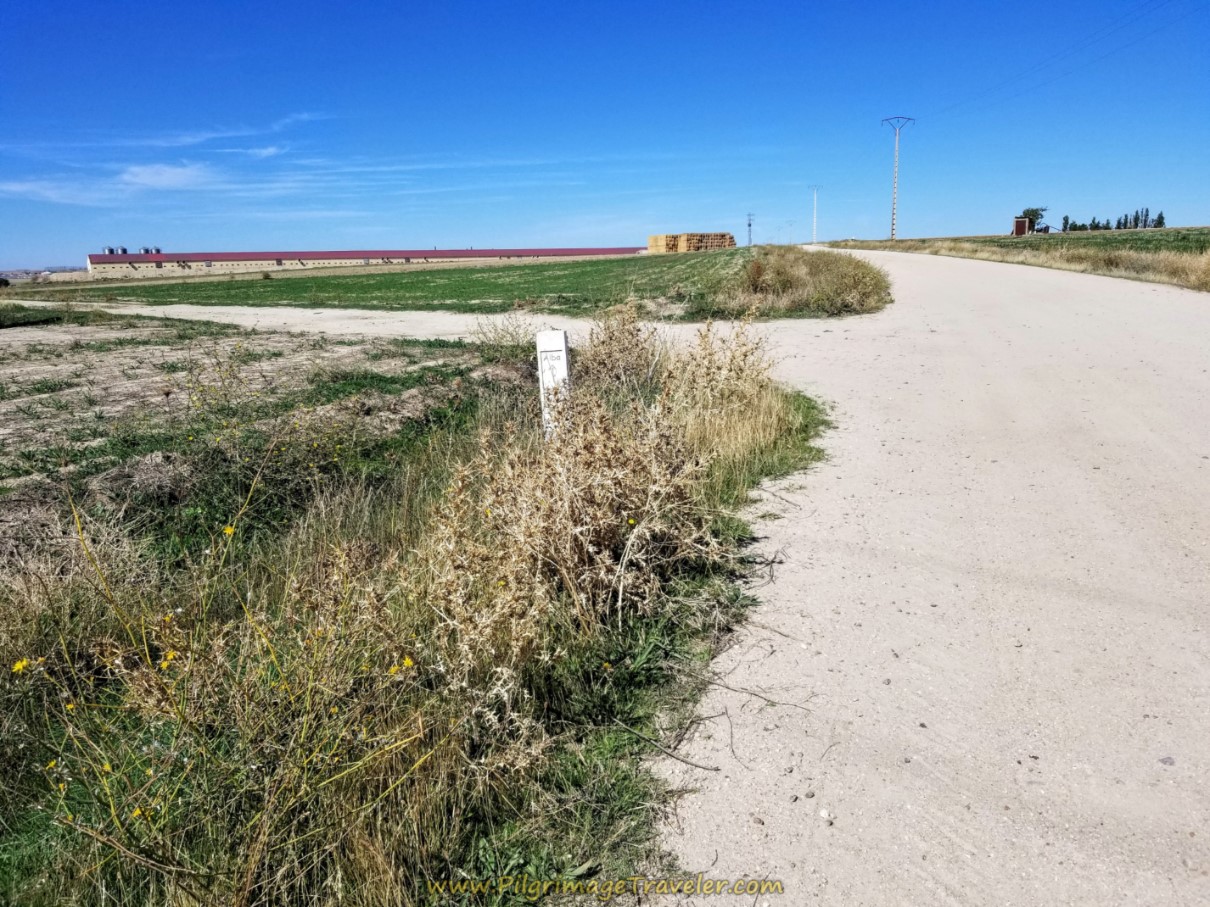 Pass Farm
Pass FarmJust beyond the chicken farm, after about 21.3 kilometers into day two of the Ruta Teresiana, the road branches at this Y-intersection. Stay to the right.
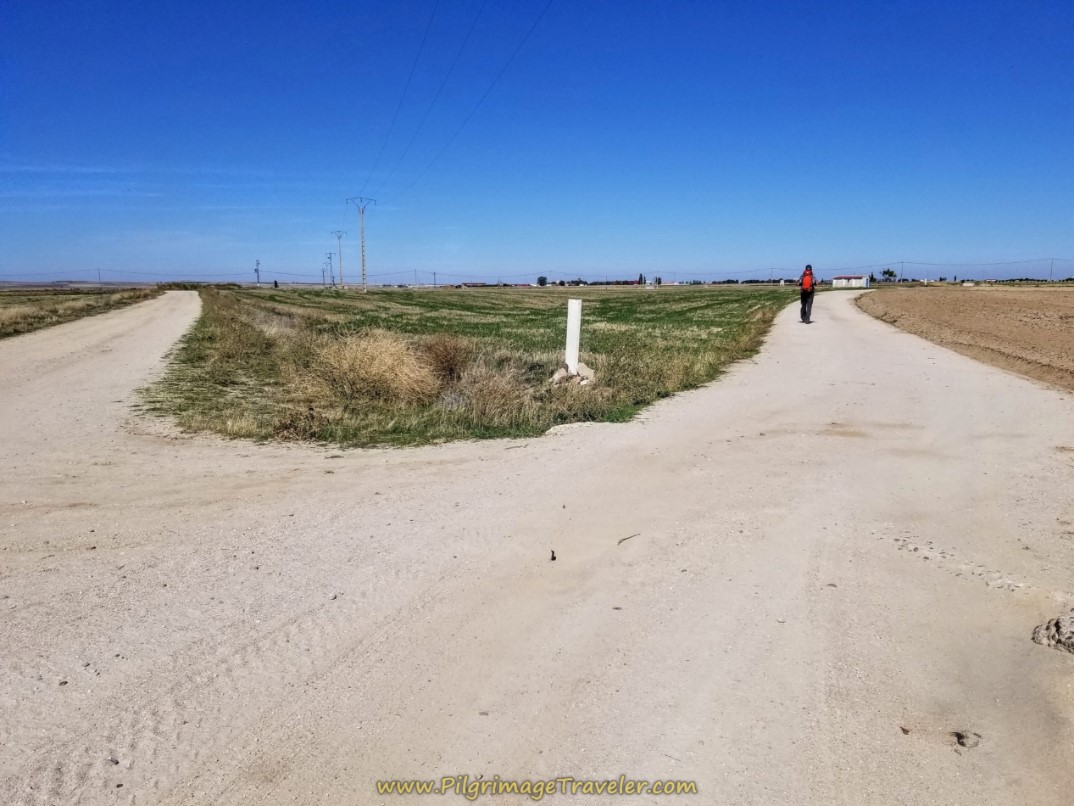 Stay Right at the Y Intersection
Stay Right at the Y IntersectionAfter another kilometer, the Ruta Teresiana comes to another intersection, and goes to the left, toward another large farm.
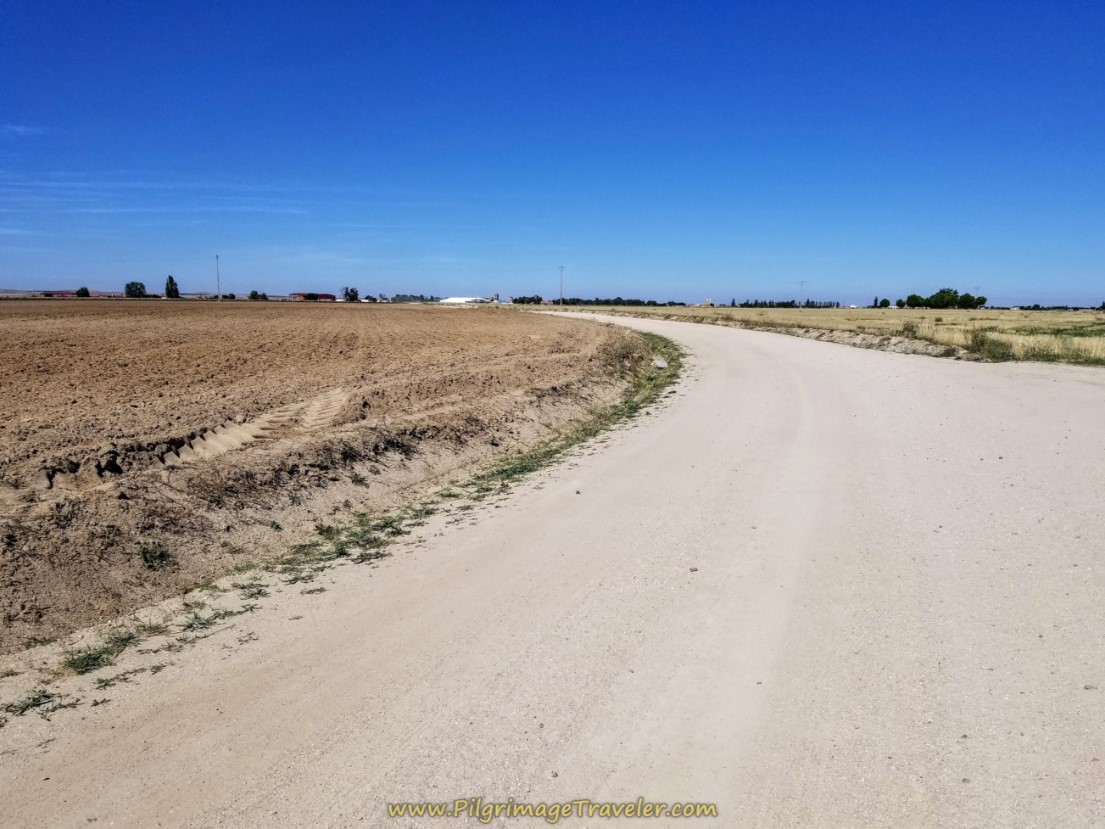 Stay Left at This Junction
Stay Left at This JunctionAfter 1.2 kilometers more, turn right at another intersection, heading toward a clump of trees. I was very surprised at this turn, as it appeared to be turning away from Fontiveros. I was so exhausted from the heat, and I just wanted this day to be over! I could see from Google maps that the more direct approach was straight on, towards the hotels in town.
Somehow, I thought the Camino planners must have a reason to take us in the other direction, so we turned right to follow the official route. We arrived at the clump of trees after about 300 meters, and turned left after them. 3000 meters was an OK addition to the day, I thought, to avoid main roads in town for longer.
(In hindsight, if we had gone straight here we would have joined the main road into Fontiveros after a bit more than a kilometer. There is a sidewalk on the AV-P-115a, so it would have been perfectly safe to take this shortcut, but it doesn't save much distance.)
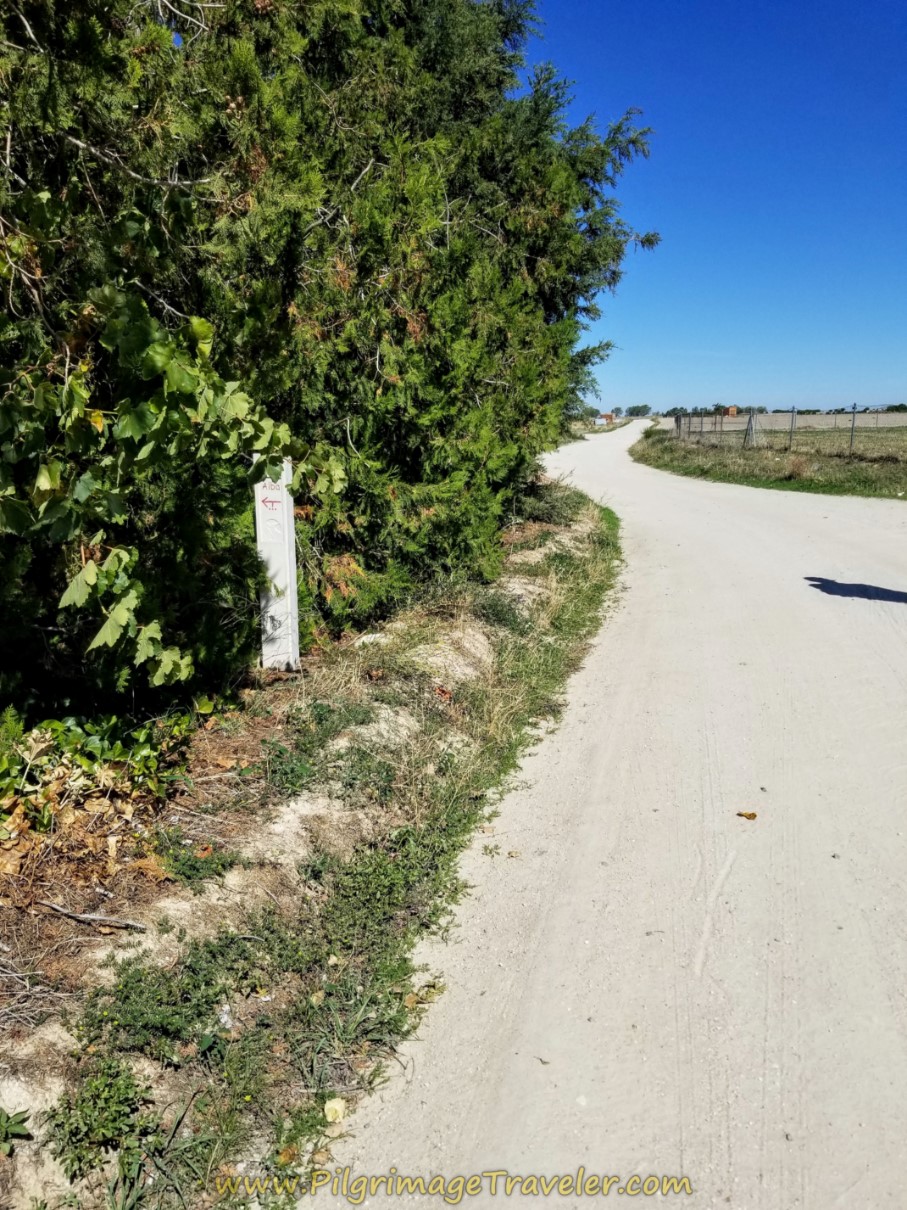 Left at Clump of Trees Onto Calle Viejo
Left at Clump of Trees Onto Calle ViejoAfter the turn you can see this cement plant ahead. In 250 meters more, stay left at the plant and continue on.
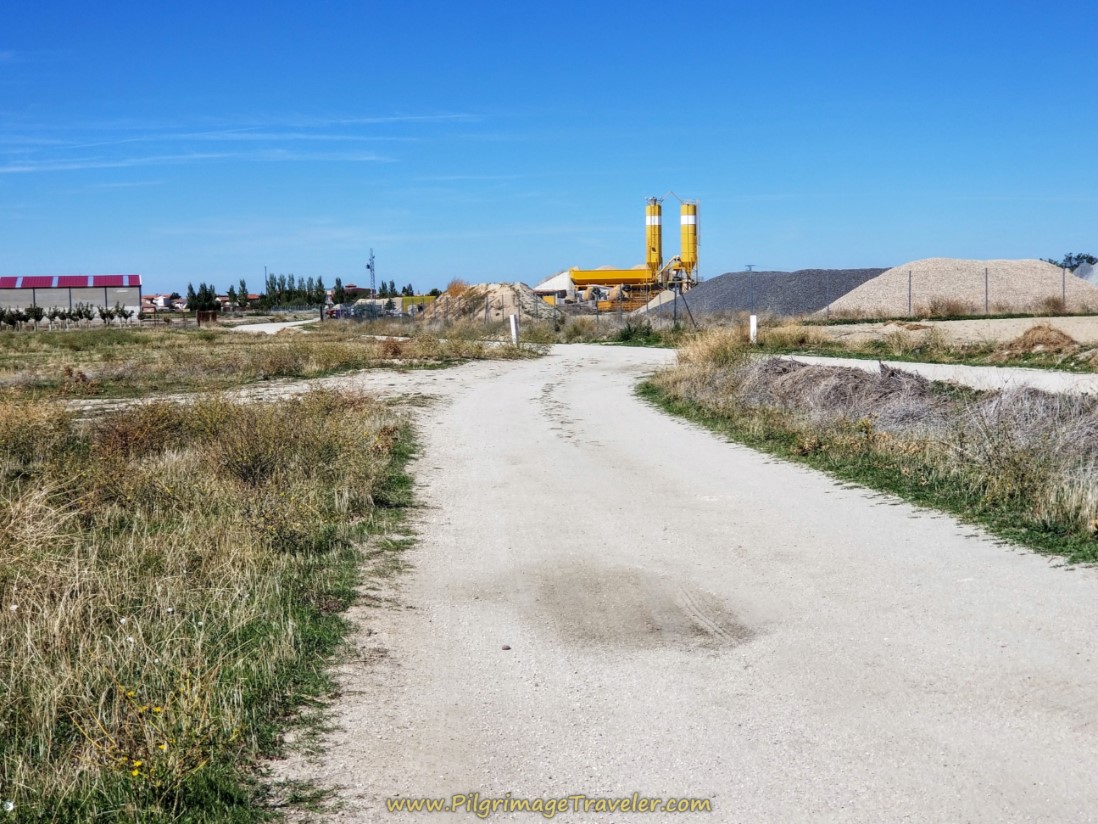 Stay Left to Walk by Cement Factory
Stay Left to Walk by Cement FactoryBeyond the cement plant, Fontiveros comes into clear view.
After 750 meters, you arrive on the fringe of town and come to an information board by two ponds. This board dictates a turn to the right to stay on the Camino, alongside the ponds.
Once again, I could see on Google maps that going straight instead of turning by the ponds was a reasonable shortcut, by about 1/2 kilometer. I was hot and tired and just wanted to get to the hotel.
I couldn't understand the direction of the Camino, as it did not even walk the Pilgrimage Traveler by any major sites, according to the board. Besides, we had plenty of time to tour the town later after a shower and a break from the hot sun!
This time I made the decision to take the shortcut and stayed straight on the Calle Viejo. This shortcut made a real difference!
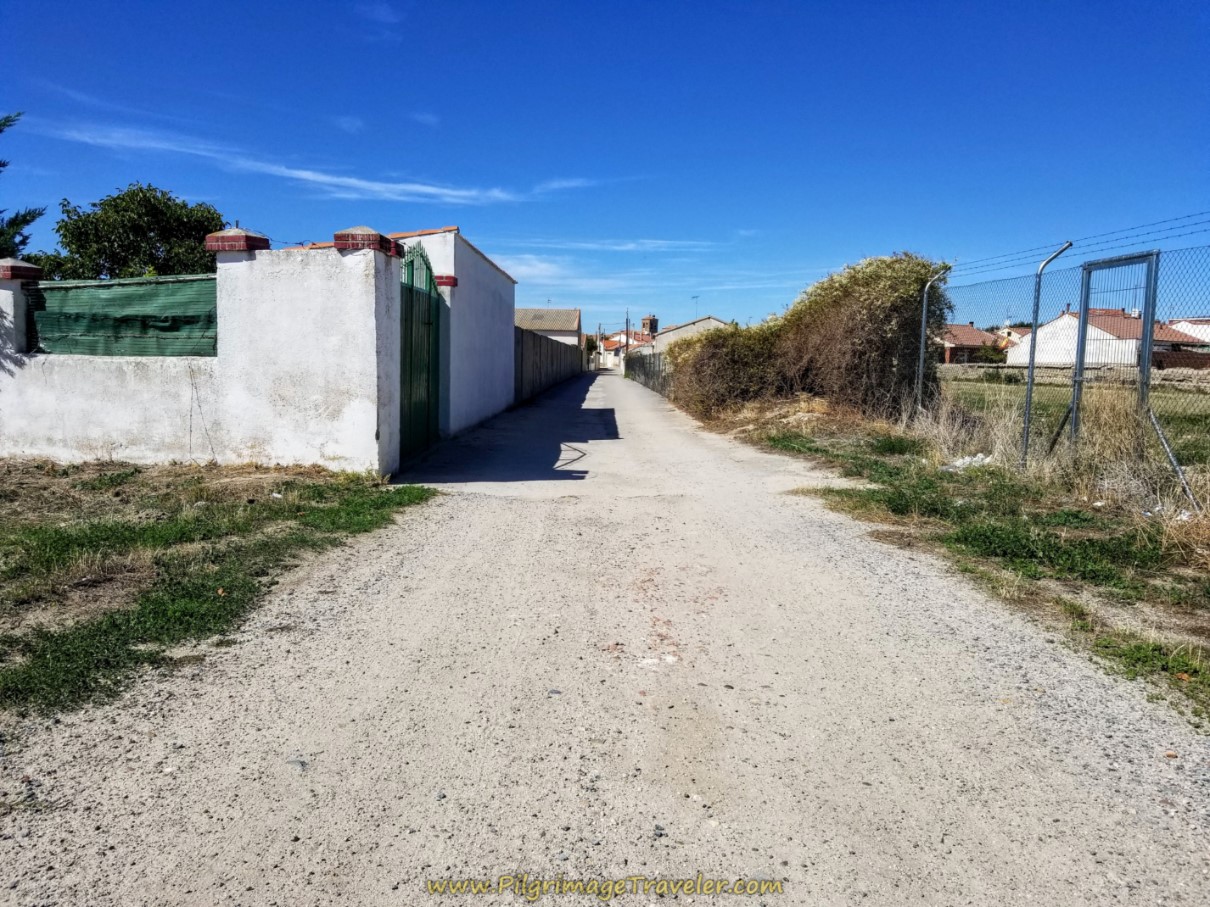 Continue on Calle Viejo for Shortcut into Town
Continue on Calle Viejo for Shortcut into TownOn my interactive Google map above, I did show the official route through Fontiveros, if you wish to walk it, and I also show the actual shortcut we took in orange.
For us, continuing on the dirt Calle Viejo, within 300 meters we came to the AV-P-115a, and turned right. After only 60 meters, we came to a Y-intersection, where we took the left onto the Plaza Frontón, where immediately on the left are the distinctive orange walls of the Casa Rural La Fonte (+34 636 03 79 55), shown below.
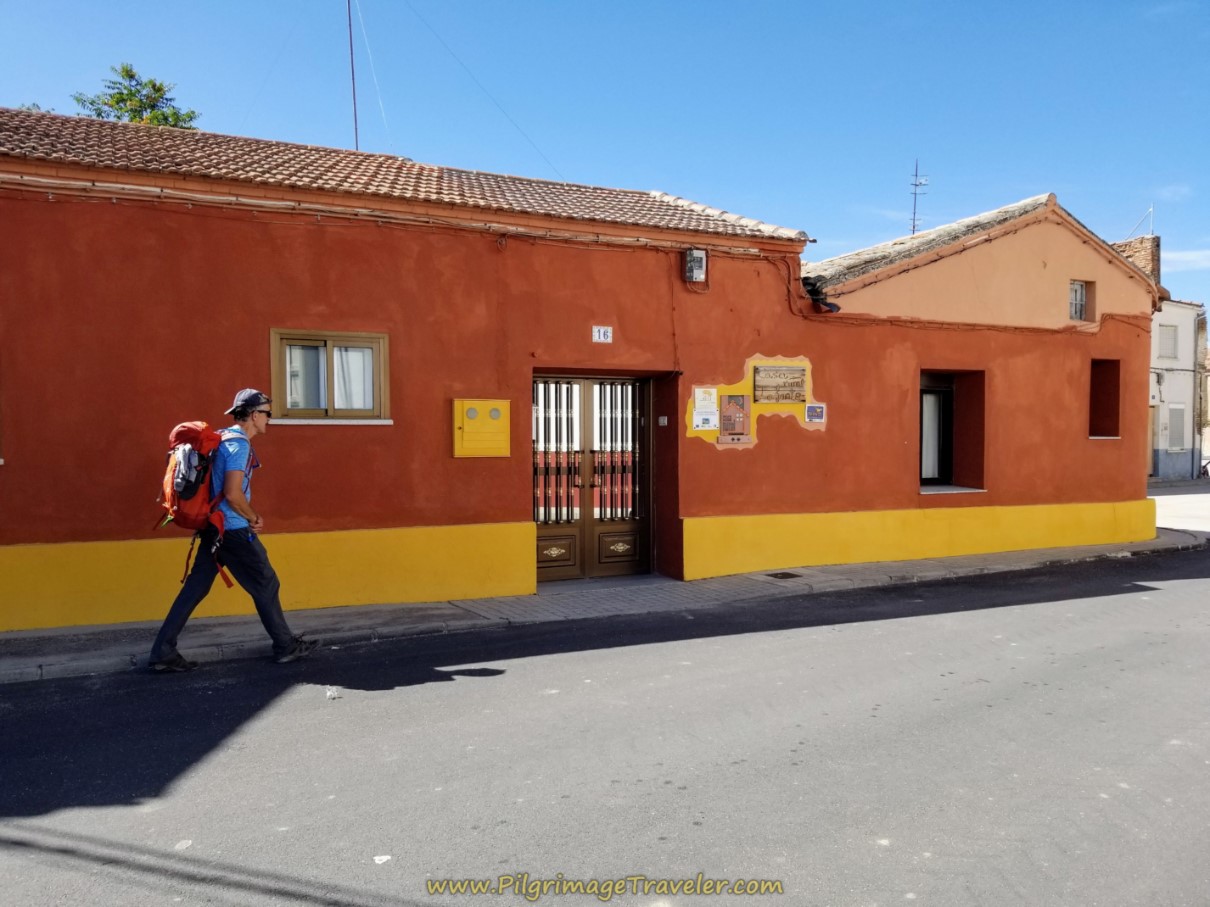 Casa Rural La Fonte
Casa Rural La FonteWe walked on by, to check out the special facility to San Juan first, shown below. In only 80 meters more, the Camino turns left onto the Calle Santa Ana to continue onward and out of the town. This is where I turned off my GPS.
Staying straight instead, the Posada Espacio San Juan de la Cruz (+34 918 63 04 60) is just ahead. This center was built by the Diputación de Ávila around the figure of the saint, on the theme of Llama de Amor Viva, or the "Living Flame of Love." It houses a restaurant, a garden dedicated to the four elements of earth, air, fire and water, a library, 11 rooms and living spaces, all to honor the mystic tradition.
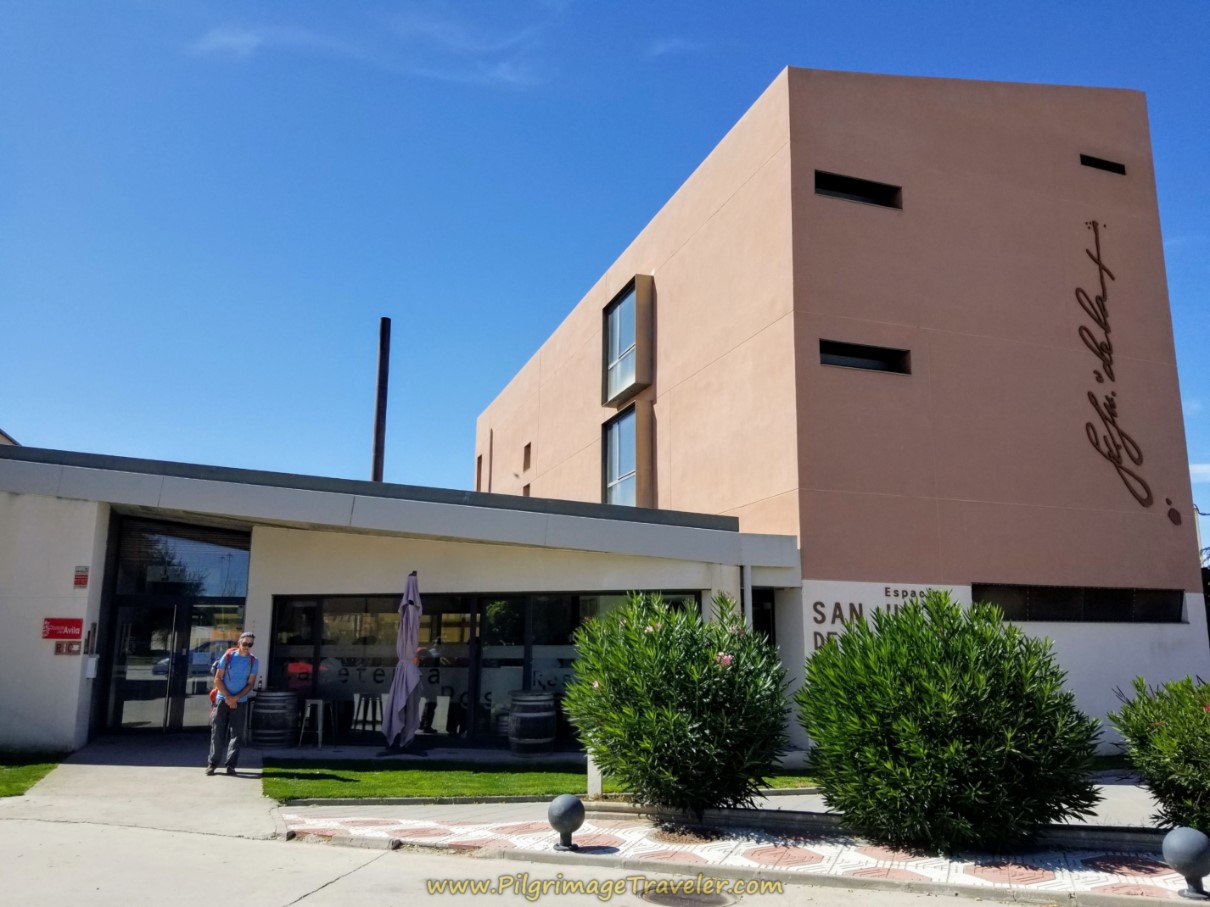 Posada Espacio San Juan de la Cruz
Posada Espacio San Juan de la CruzAt the time of our walk the Posada was closed to the general public. We turned around and went back to the Casa Rural La Fonte. When we rang the bell no one answered, so we called the number. With my broken Spanish, I managed to get a room, but the proprietress needed us to wait until 5:30 to get in so she could clean the room! It was 2:30 which meant a three hour wait!
But the price was right at 20 Euros each, and since there was no other choice (the pilgrim's albergue was not yet open when we were here and the Posada which used to take walk-ins was full for the weekend), we agreed to take the room. The place turned out to be lovely, with three available rooms for two or three, a full home to share with a well-equipped kitchen, a washing machine and a nice outdoor patio to relax and hang our clothes.
We took the room with two singles and a bathroom en-suite. It was a very comfortable and inexpensive night with the ability to cook our meals. We even had the entire house to ourselves that night.
The proprietress was also very helpful and kind and tried her best to accommodate us otherwise.
The wait until 5:30, however, was extremely inconvenient, but we killed time at this place, the Pub Fussion in the center of town.
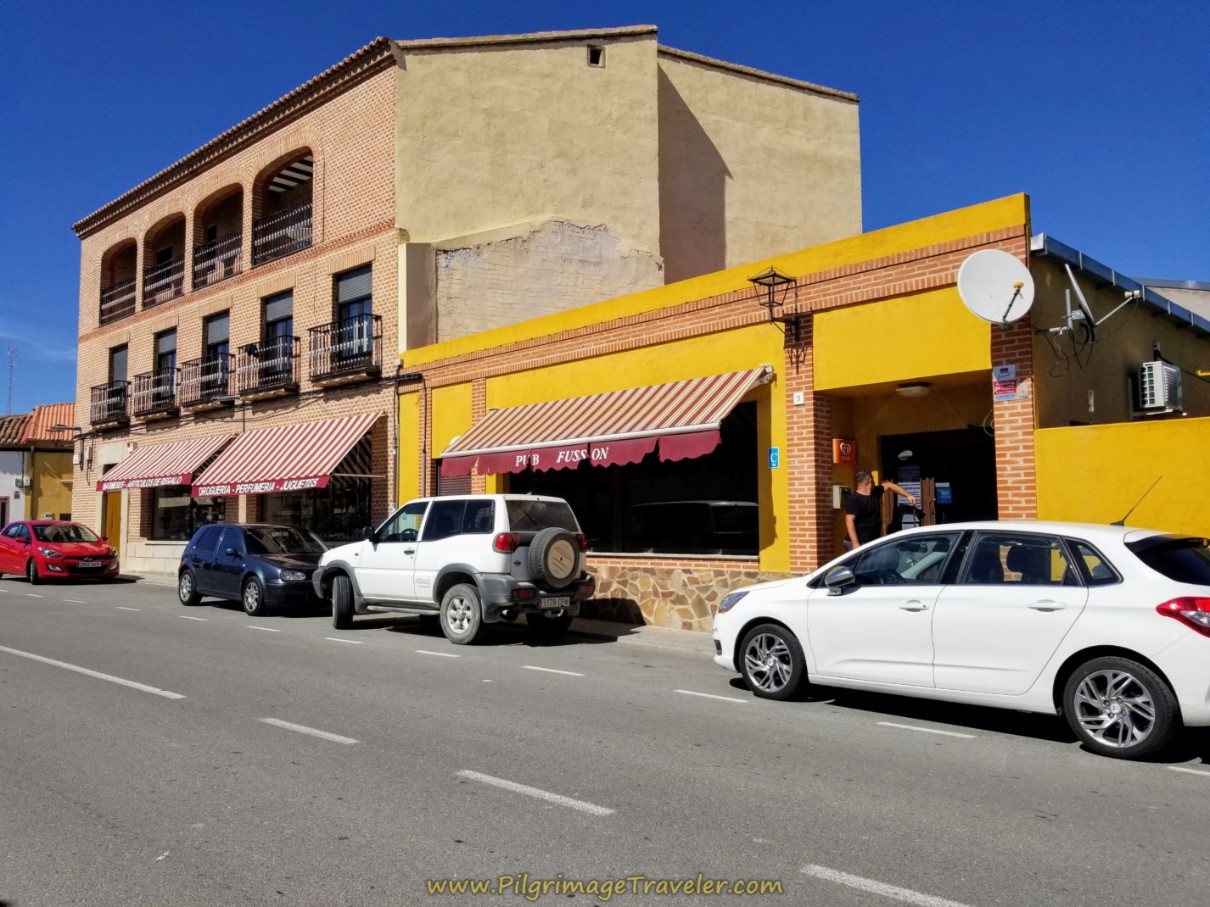 Pub Fussion
Pub FussionThe pub had an outdoor area and they offered an amazing plethora of pinchos, mostly bocadillitos (little sandwiches) made of serrano ham, tortilla or bacalao. They were fabulous and fabulously inexpensive. They filled our belly with happiness!
While Rich washed the pinchos down with Mahou, I tried the vino Verdejo, a local white wine, chilled and oh-so-refreshing. I soon forgot that I had not yet been able to take a shower as we made merry and had even more to eat and drink.
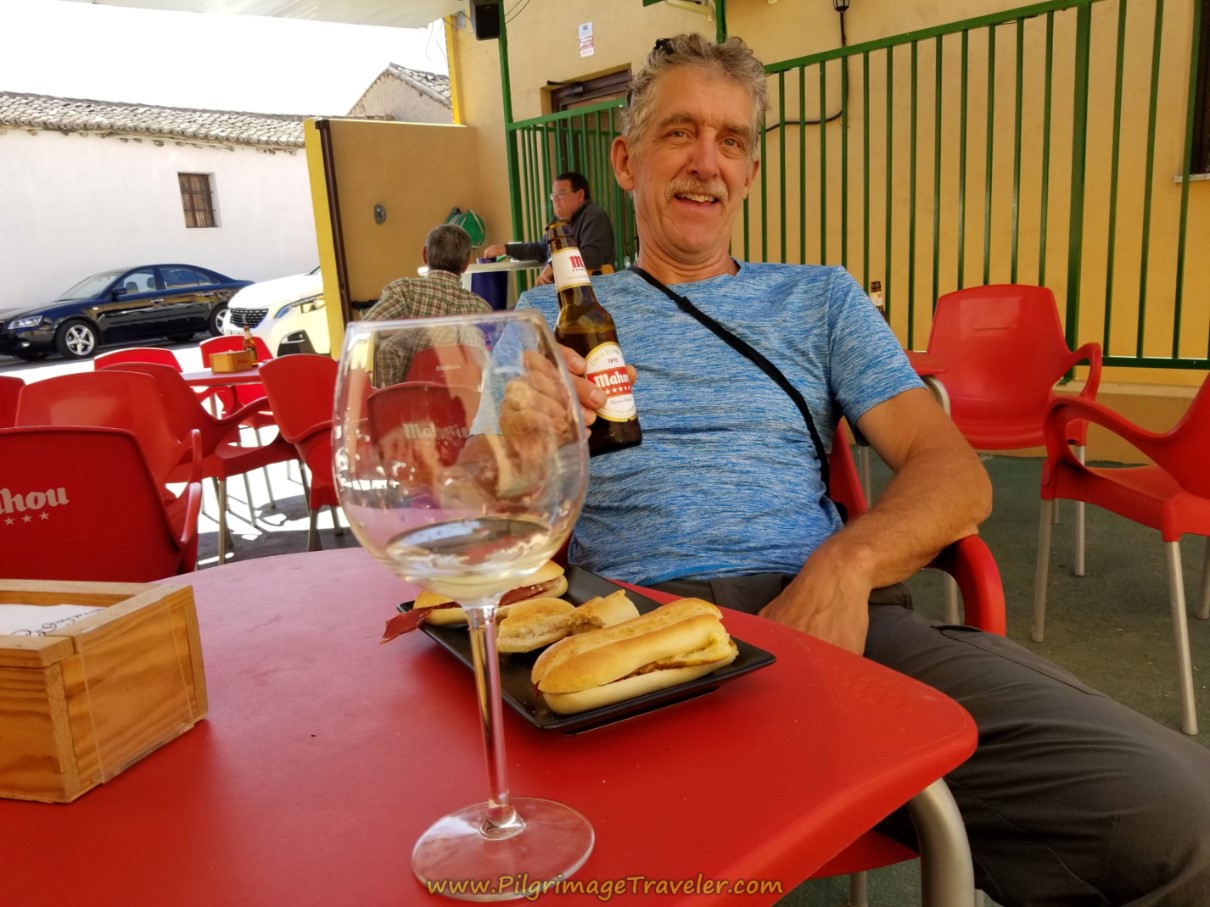 Rich at Pub Fussion Patio
Rich at Pub Fussion PatioFrom the pub, we located the major attractions in Fontiveros, first the Carmelitas de la Madre Dios convent. Since this is a living convent, carrying on the traditional observations of the Carmelites, visiting hours are restricted. You may call the number I provided in the link to see if you can see inside or when mass is celebrated. Otherwise, expect it to be closed as it was when we were here.
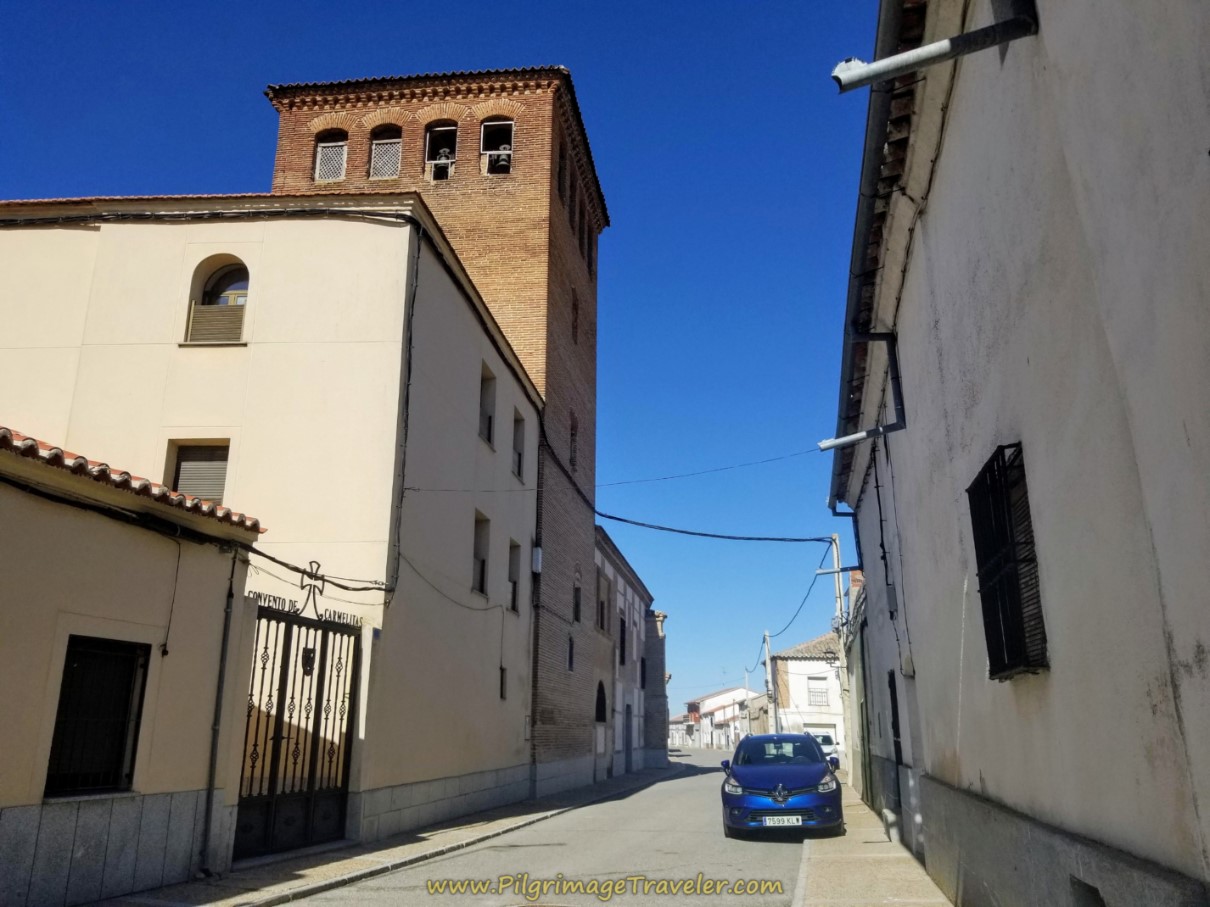 Carmelitas de la Madre de Dios
Carmelitas de la Madre de DiosThis building has been in use since 1609 when it was first occupied. It is a simple brick building in the Mudejar style, currently operated by a handful of nuns.
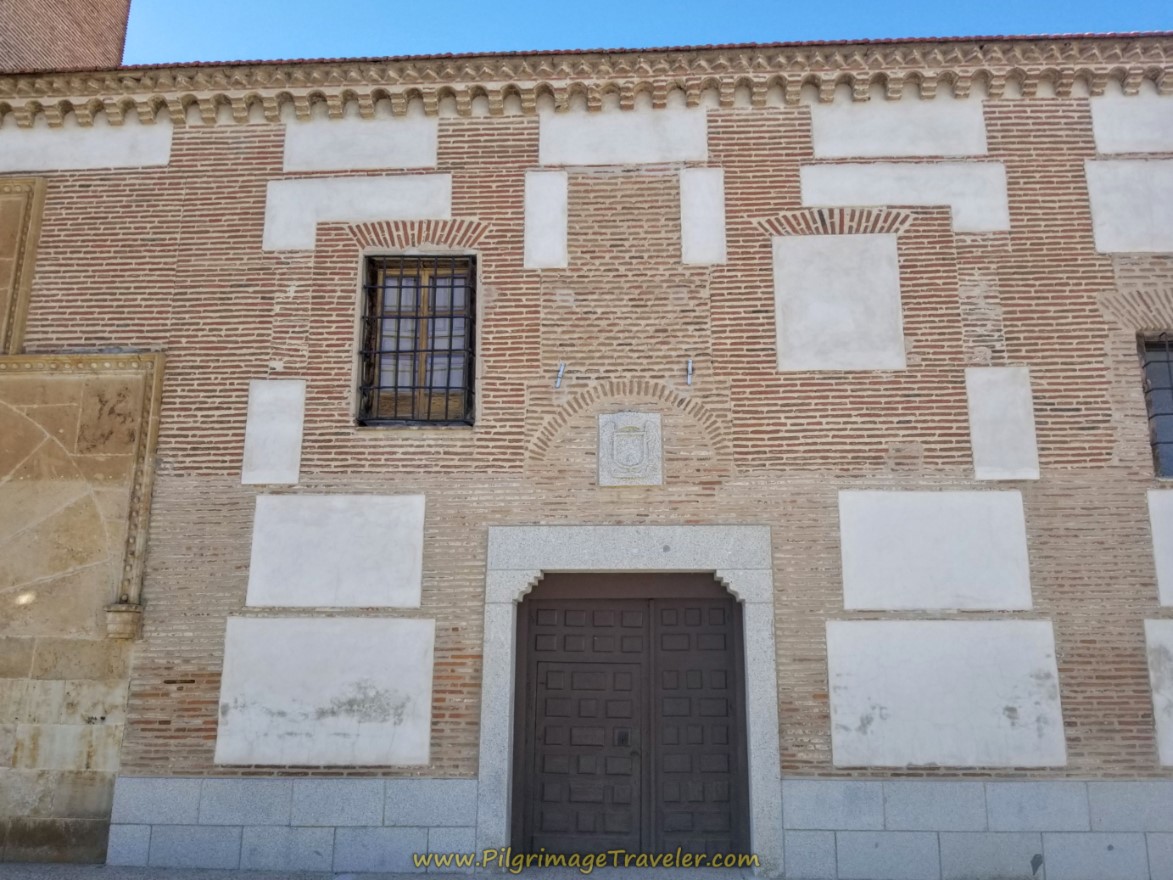 Carmelitas de la Madre de Dios Doorway
Carmelitas de la Madre de Dios DoorwayJust adjacent to the convent is the small, unpretentious church on the site of the home where San Juan de la Cruz was born, the Iglesia Casa Natal de San Juan de la Cruz. The home has been transformed into a sacred place to honor the life of San Juan de la Cruz. This lovely chapel was also closed when we arrived. To have a look inside, click on this YouTube video.
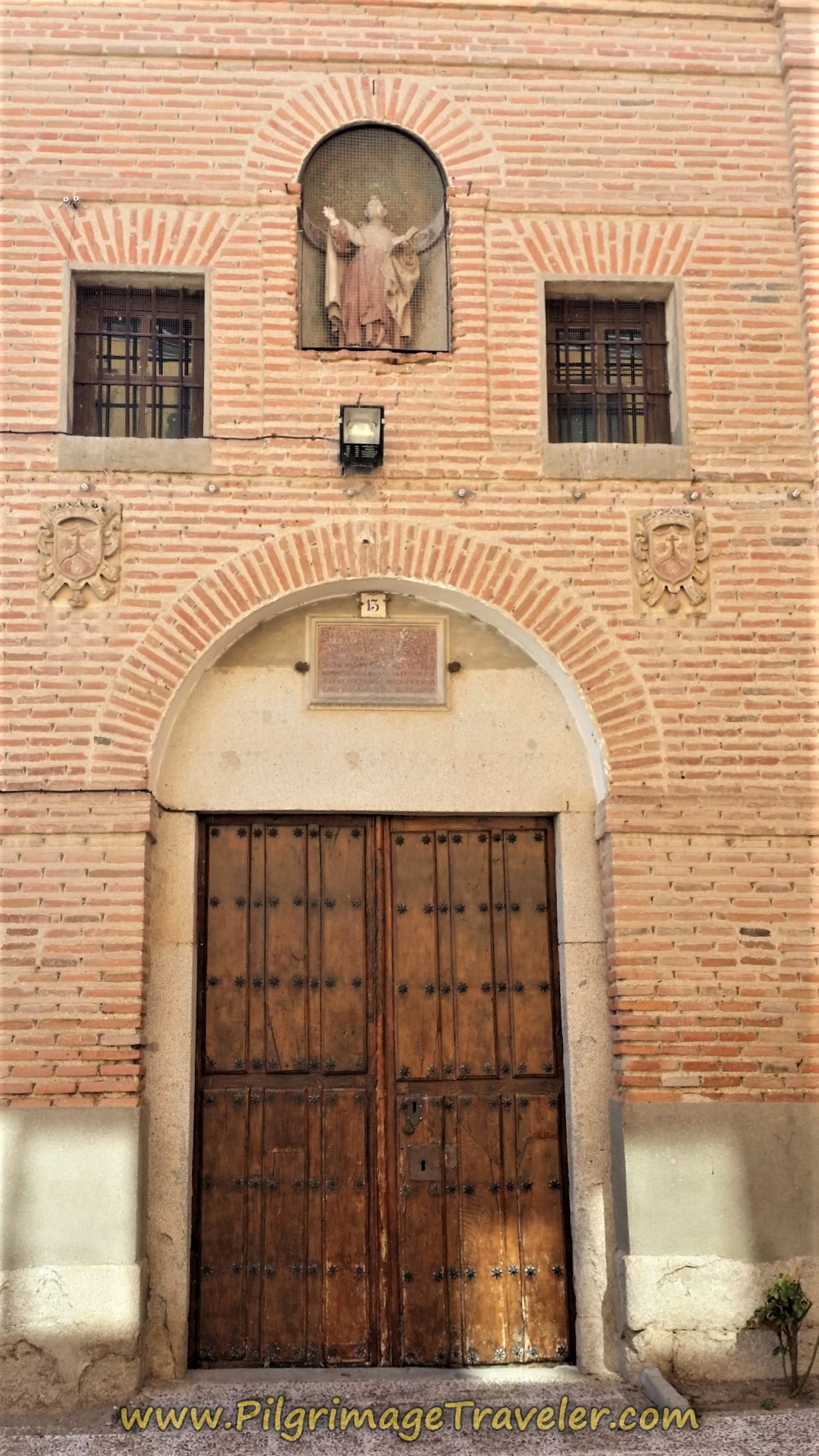 Iglesia Casa Natal de San Juan de la Cruz
Iglesia Casa Natal de San Juan de la CruzAnd in the center of Fontiveros, as you may expect, is a very nice statue commemorating the saint and his place of birth. St. John's presence is palpable in this city. Even menu items are named after him, the local stew, the San Juaniego.
And finally we had a look at the Parish church of Fontiveros, originally built in the 12th century in the Moorish Mudejar style, with Gothic and Romanesque components and an 18th century Baroque altar. We were unable to see inside, but here is a lovely YouTube video tour.
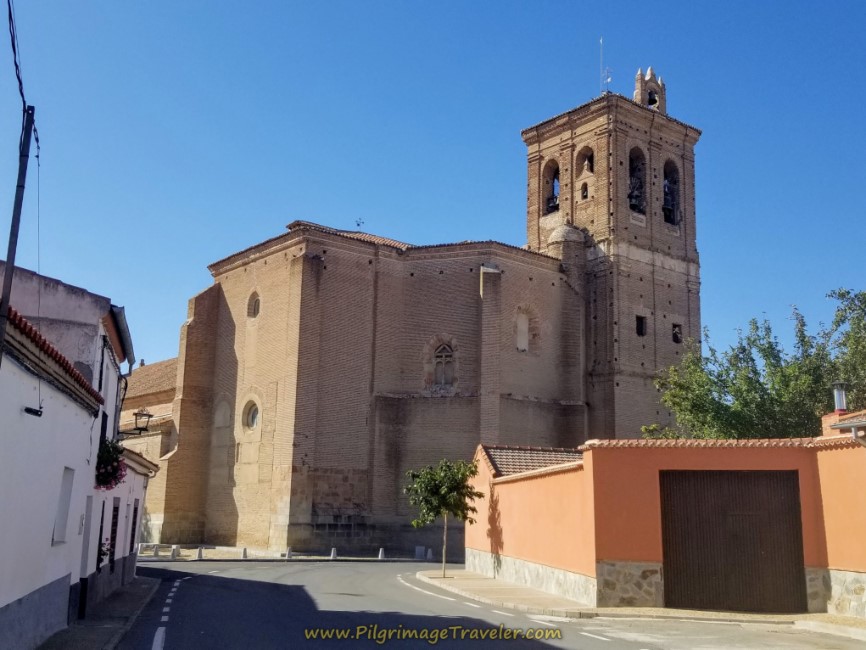 Iglesia Parroquial de Fontiveros
Iglesia Parroquial de FontiverosAnd thus, we completed our tour of Fontiveros. We finished the evening by going to the grocery store when it opened at 6:00 p.m. and bought groceries to cook our dinner in the Casa Rural La Fonte. We could also make a substantial breakfast the next day! It was a real treat to be able to do so!
Reflections on Day Two of the Camino Teresiano
This day, while hot and long, was filled with loving moments; from the natural landscape, from the locals and proprietors and from my soul mate. My longing to seek validation of my journey on the Camino and through life itself was enhanced by these moments filled with the loving infusion of God.
Despite disappointments along the way and the heat of the day, this Love lifted me into what was a perfect Camino day!
Salutation
May your own day two on the Camino Teresiano be filled with moments that will set your soul on fire with the Spirit of Love!
Caminos Teresianos Stages
Please Consider Showing Your Support
Many readers contact me, Elle, to thank me for all the time and care that I have spent creating this informative website. If you have been truly blessed by my efforts, have not purchased an eBook, yet wish to contribute, I am very grateful. Thank-you!
Search This Website:
Follow Me on Pinterest:
Follow Me on Instagram:
Find the Pilgrimage Traveler on Facebook:
Like / Share this page on Facebook:
***All Banners, Amazon, Roamless and Booking.com links on this website are affiliate links. As an Amazon associate and a Booking.com associate, the Pilgrimage Traveler website will earn from qualifying purchases when you click on these links, at no cost to you. We sincerely thank-you as this is a pilgrim-supported website***
PS: Our guide books are of our own creation and we appreciate your purchase of those too!!
Shroud Yourself in Mystery, along the Via de Francesco!
Walk in the Footsteps of St. Francis, and Connect Deeply to the Saint and to Nature in the Marvelous Italian Countryside!
Recent Articles
-
Day One on the Camino Portugués, Lisbon to Alverca do Ribatejo
Apr 15, 25 08:19 PM
Our Day One on the Camino Portugués was much more beautiful and enjoyable than we had heard. -
Hiking the West Highland Way
Apr 11, 25 08:51 PM
Hiking the West Highland Way is a representation of all things Scottish, traversing 96 miles from the lowlands of Milngavie to Ft William, in the highlands. -
Way of St Francis eBook Guide (Via di San Francesco)
Apr 11, 25 08:49 PM
Our Way of St Francis eBook Guide, a digital guidebook is full of current information to assist you in finding your Way. In downloadable, digital, PDF format.
Need suggestions on what to pack for your next pilgrimage? Click Here or on the photo below!
Carbon fiber construction (not aluminum) in a trekking pole makes them ultra lightweight. We like the Z-Pole style from Black Diamond so we can hide our poles in our pack from potential thieves before getting to our albergue! There are many to choose from! (See more of our gear recommendations! )
Gregory BackPack - My Favorite Brand
Do not forget your quick-dry microfiber towel!
Booking.com
My absolute favorite book on how to be a pilgrim:


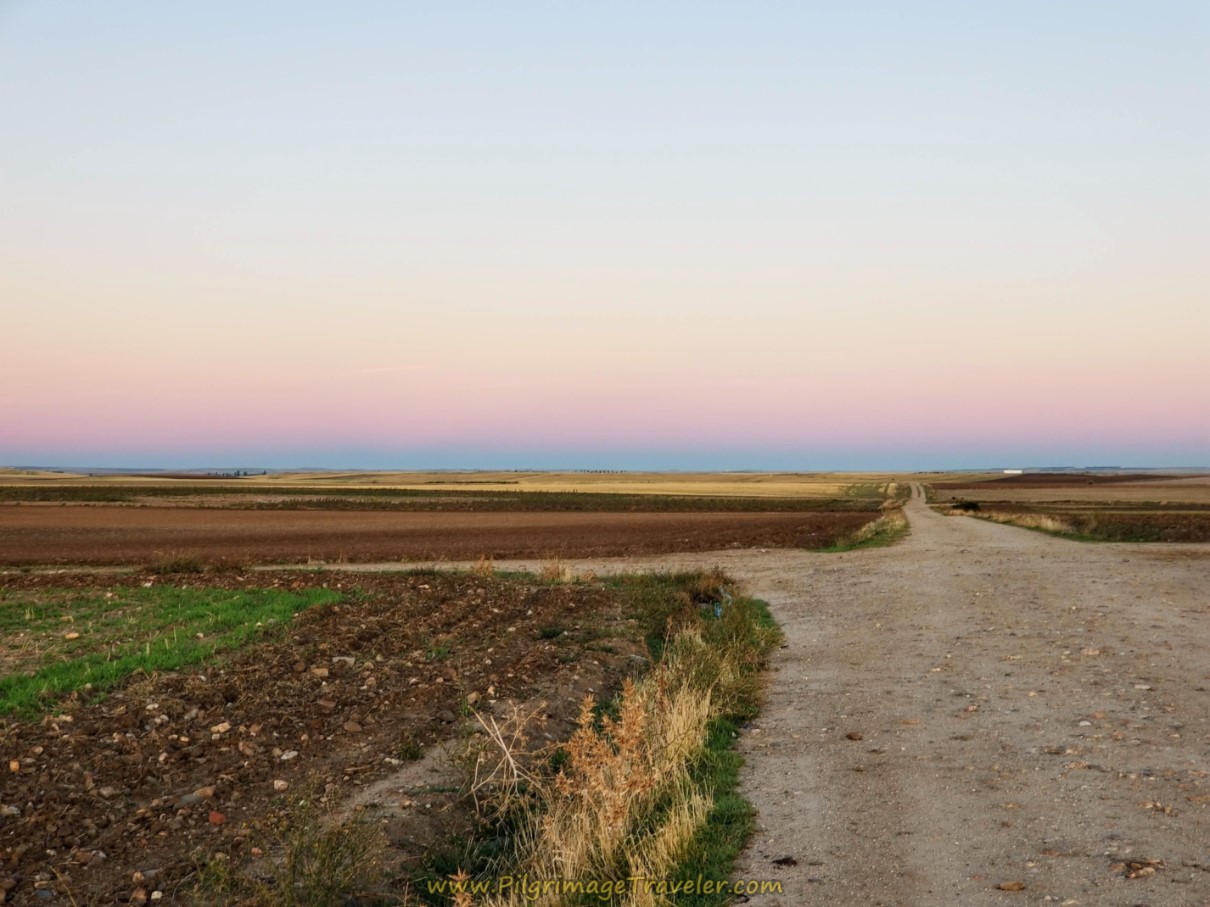
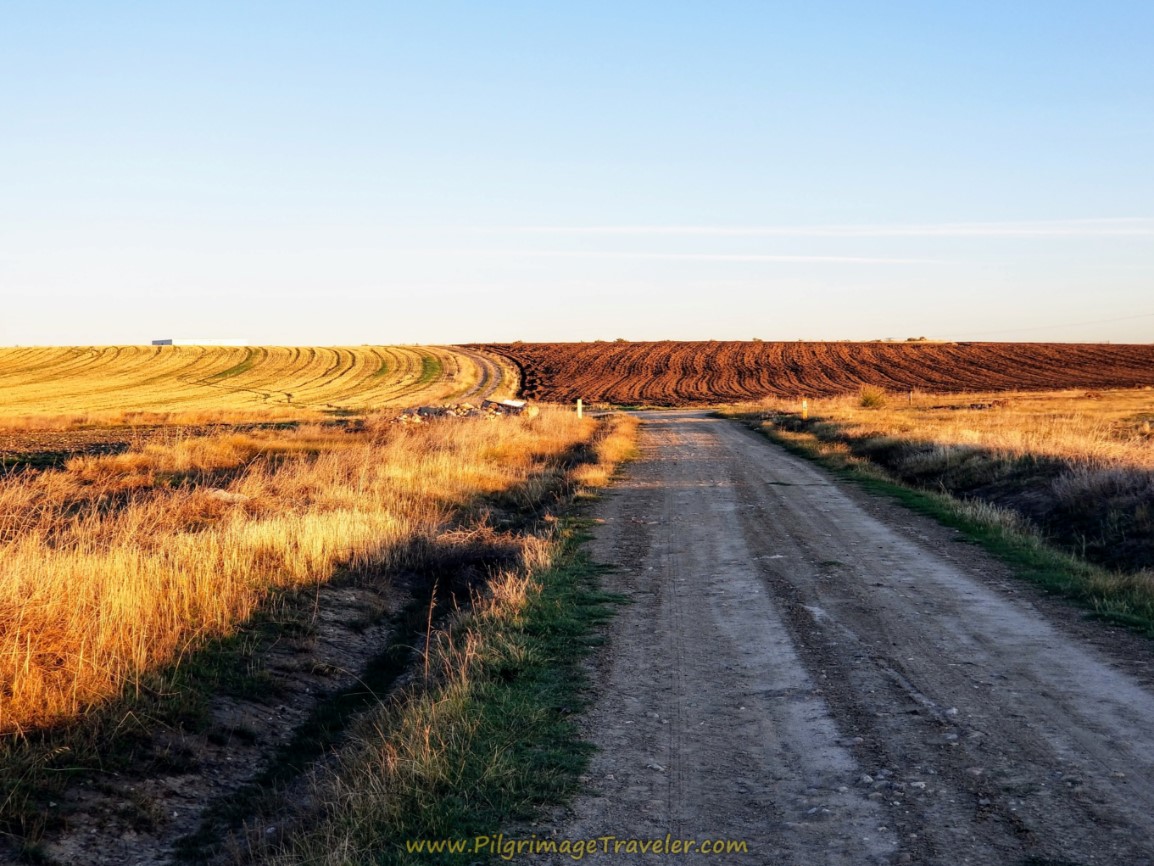
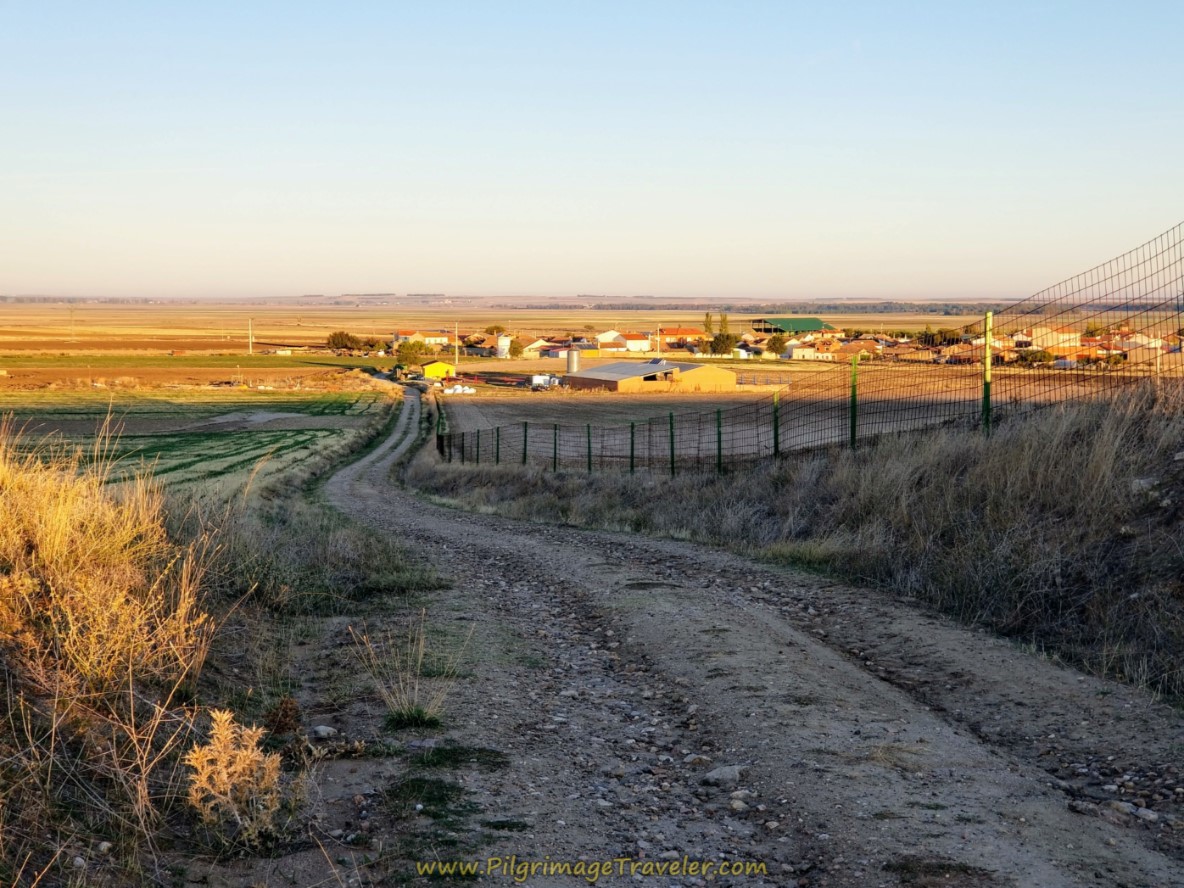
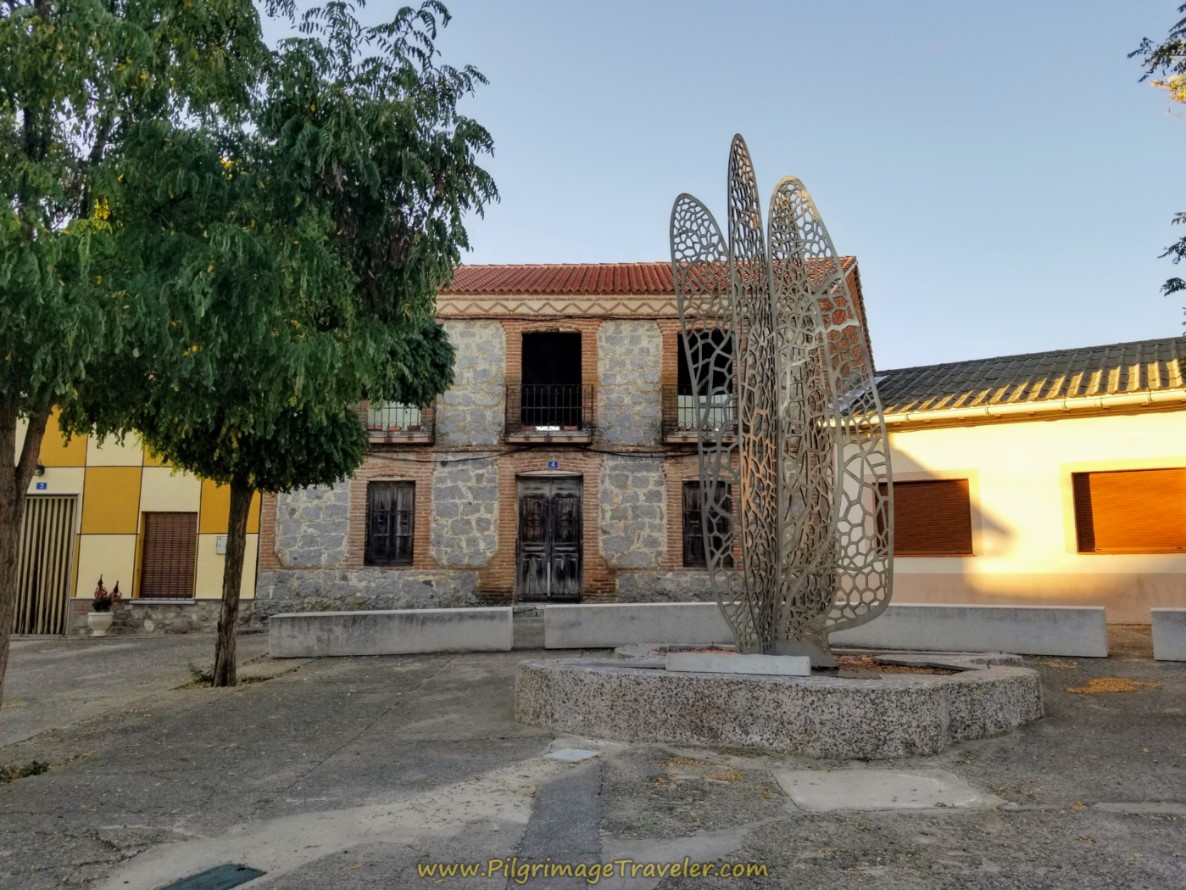
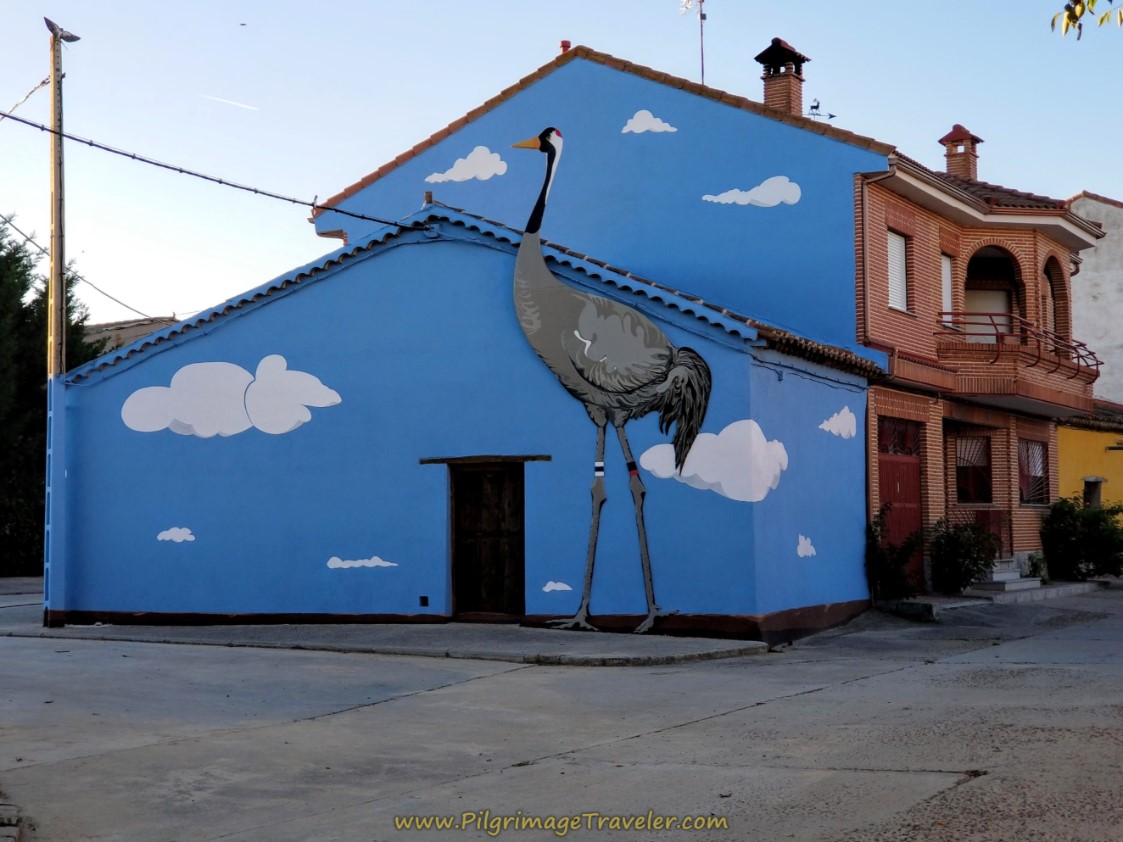
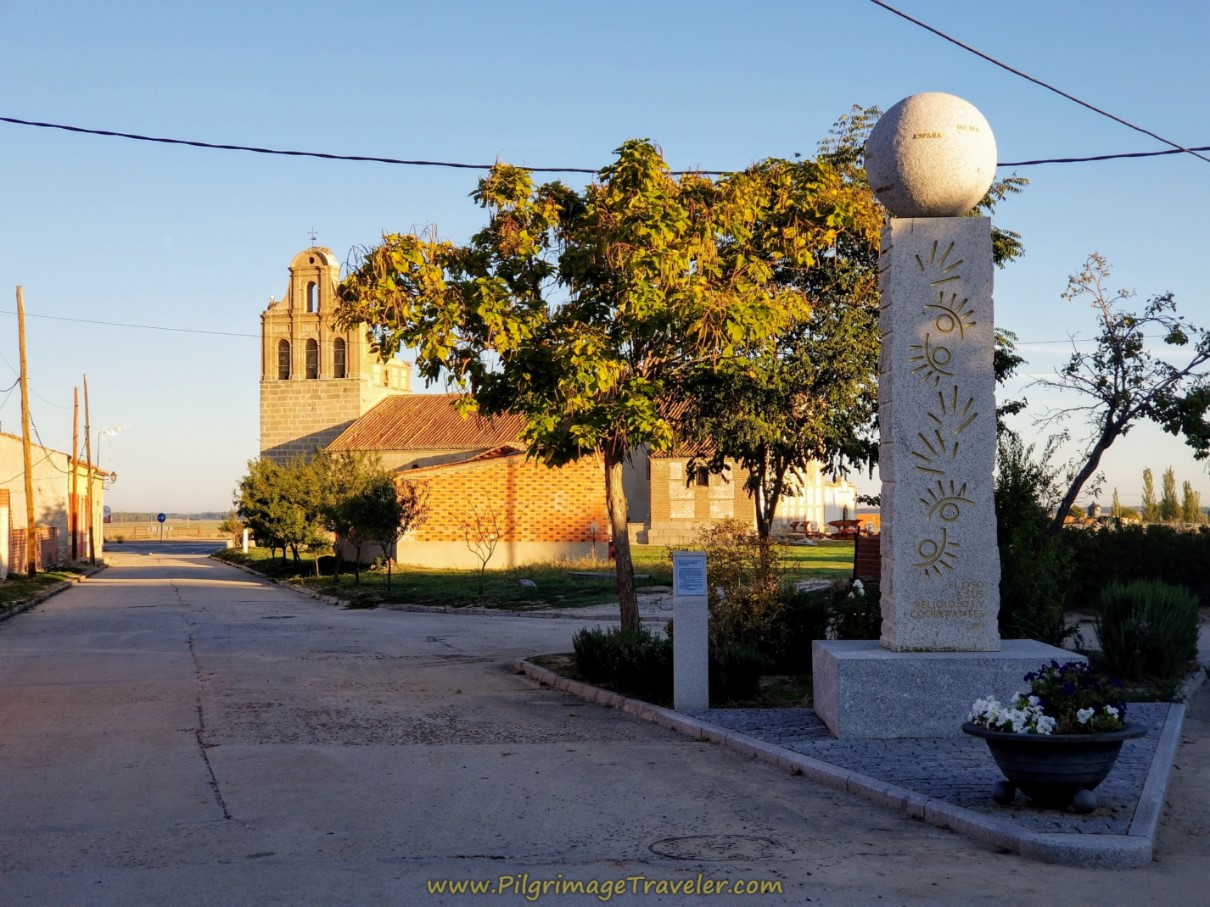
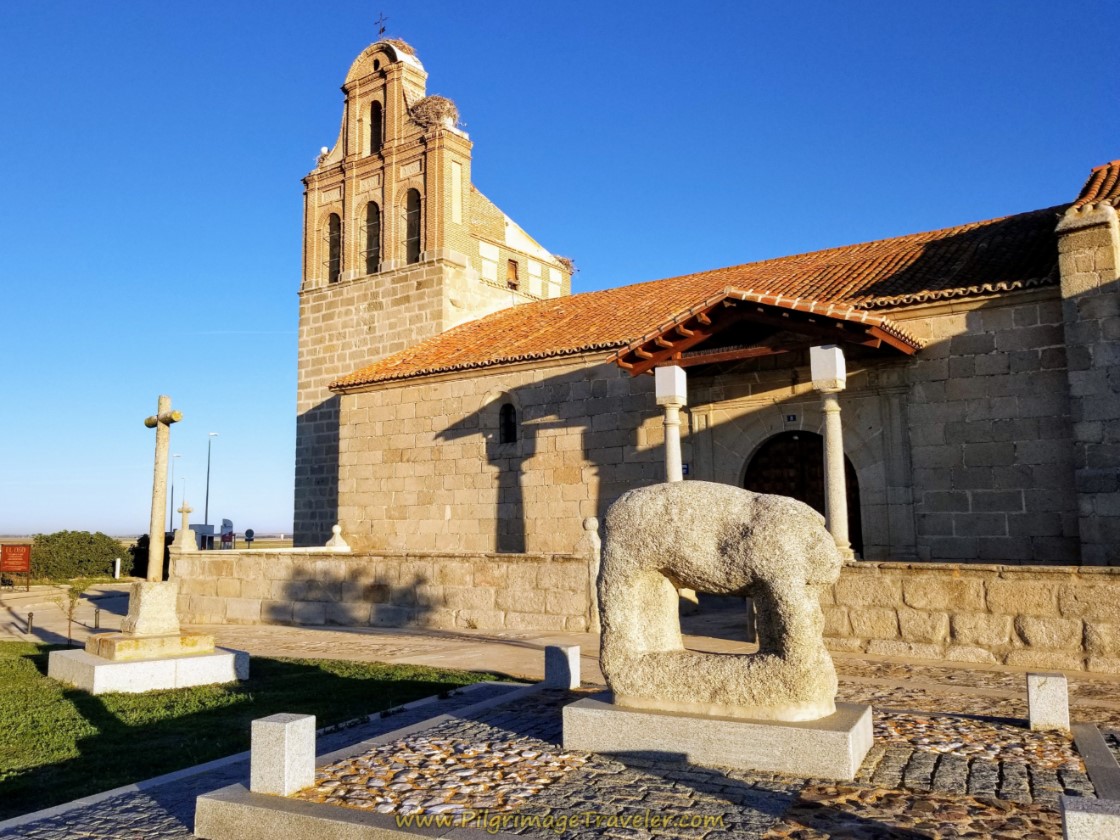
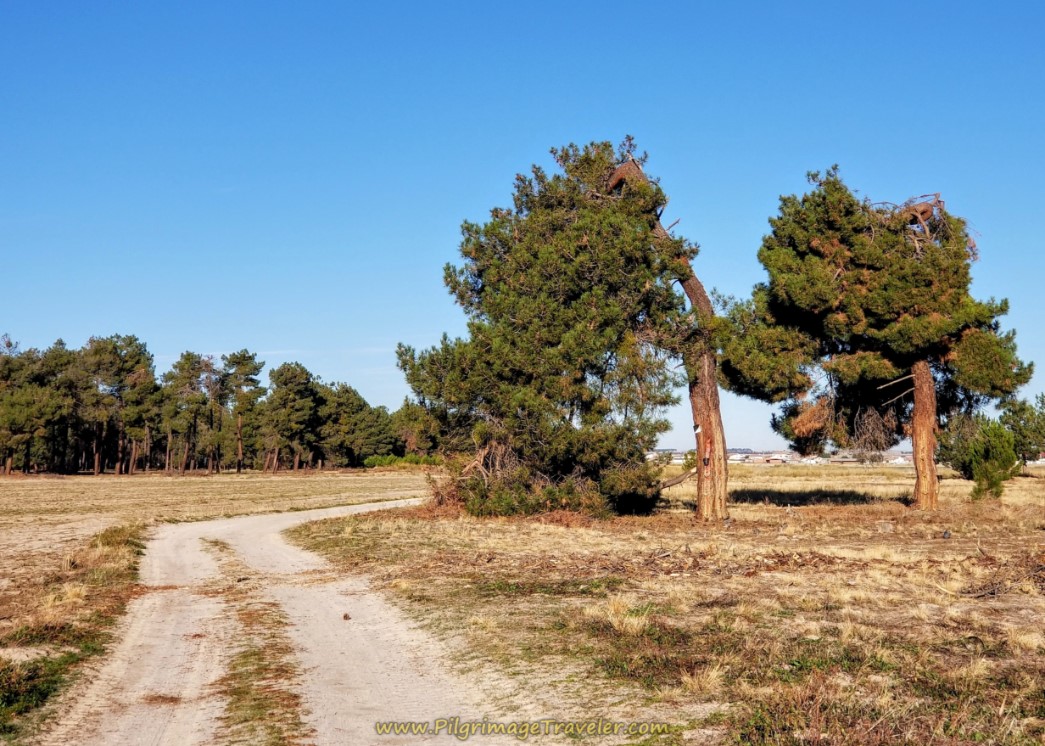
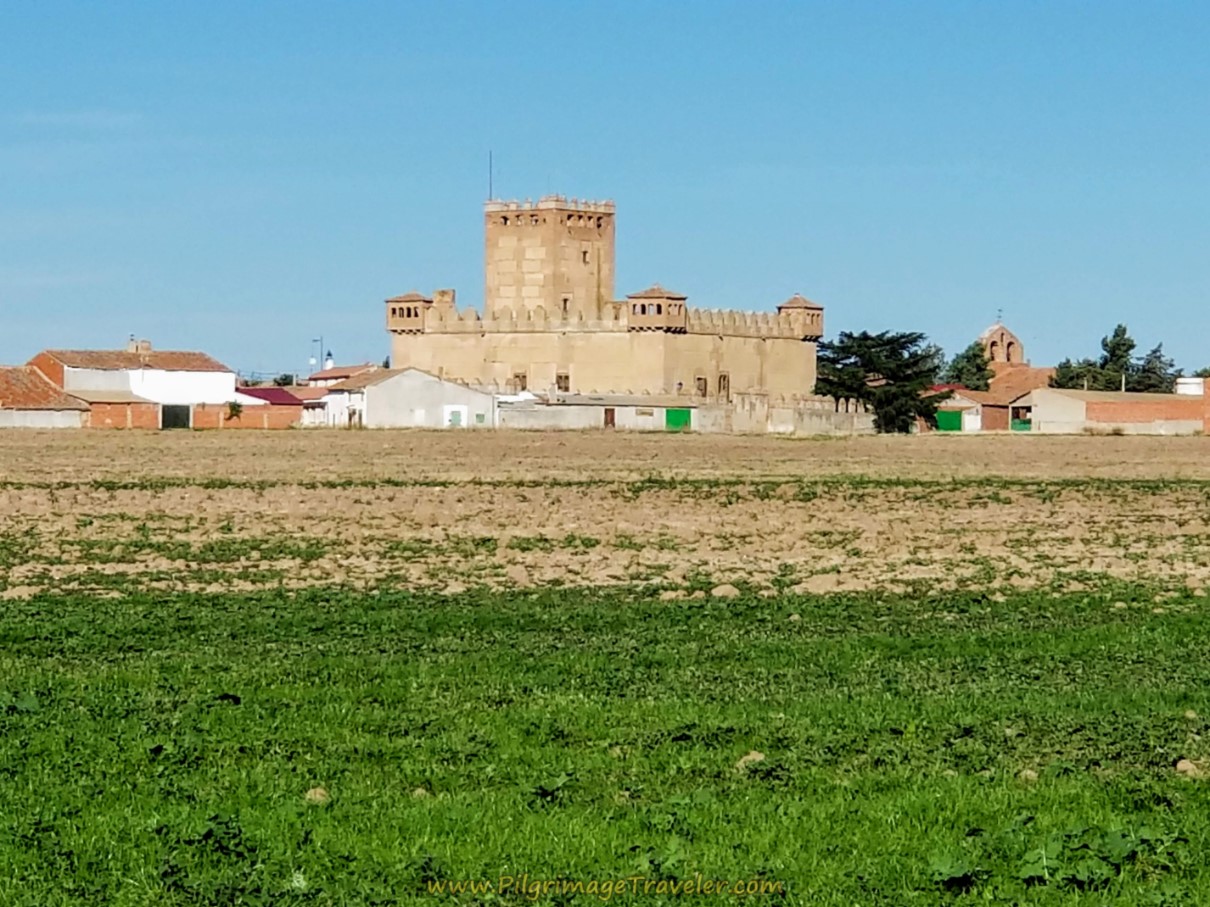
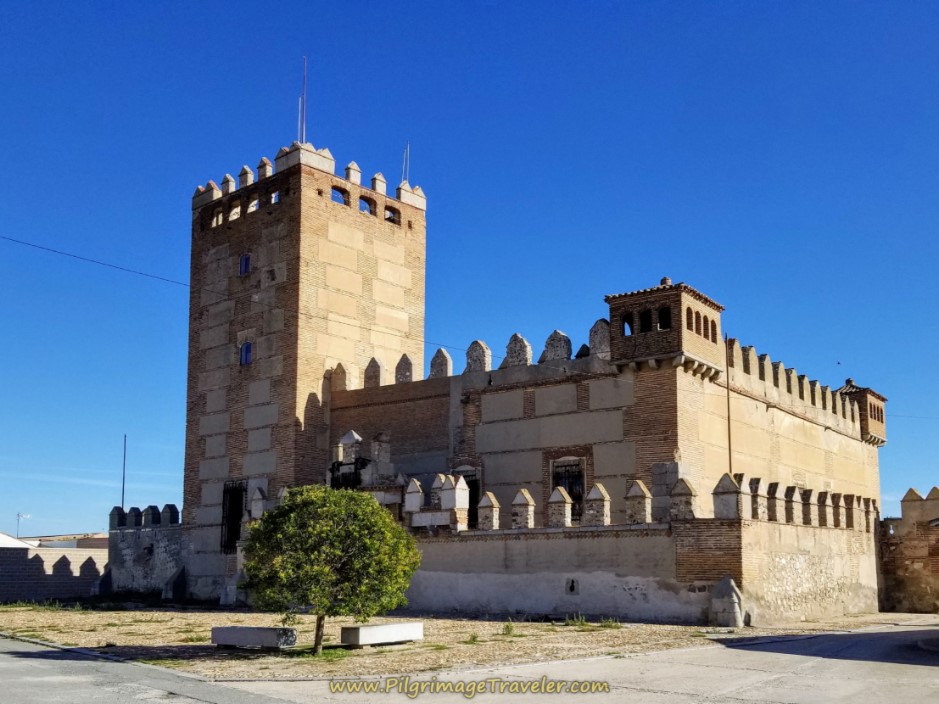
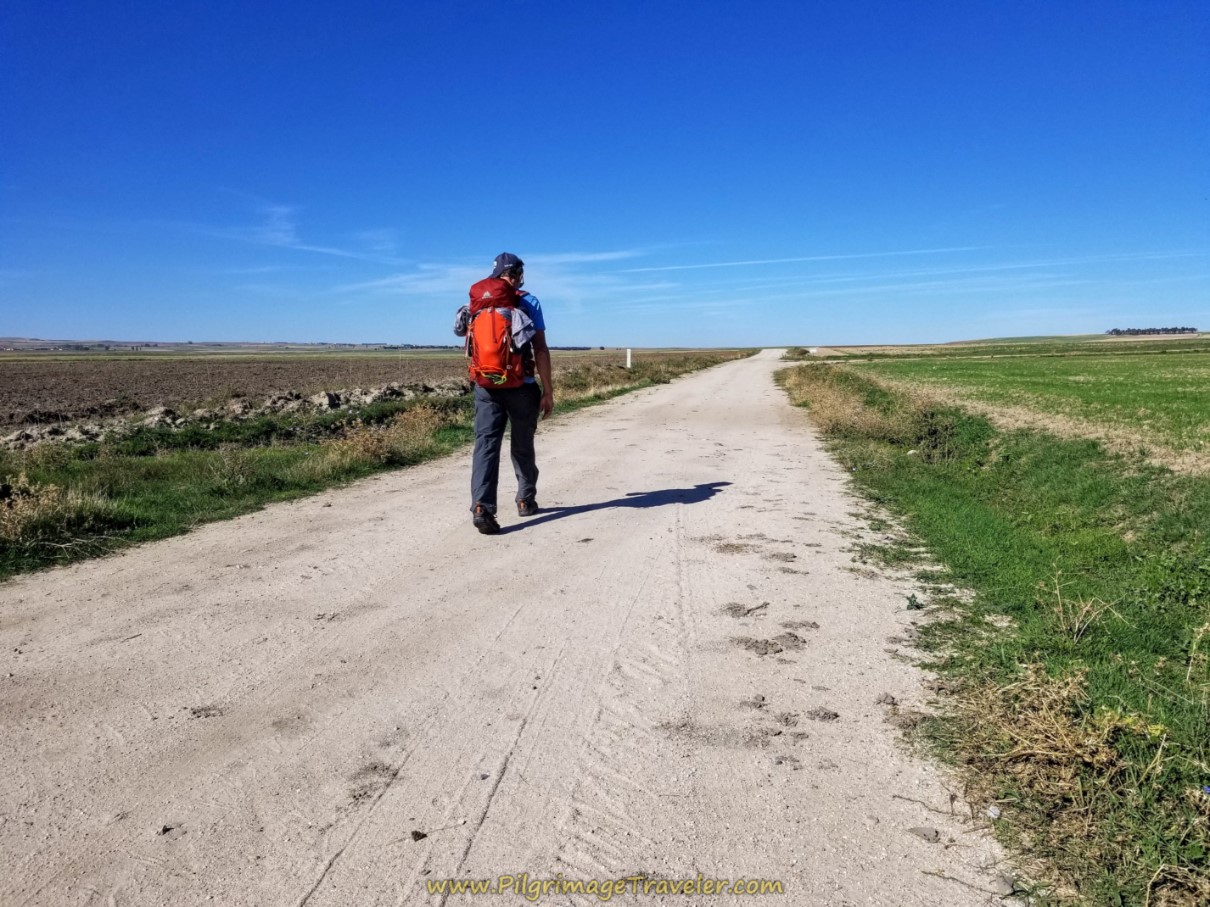
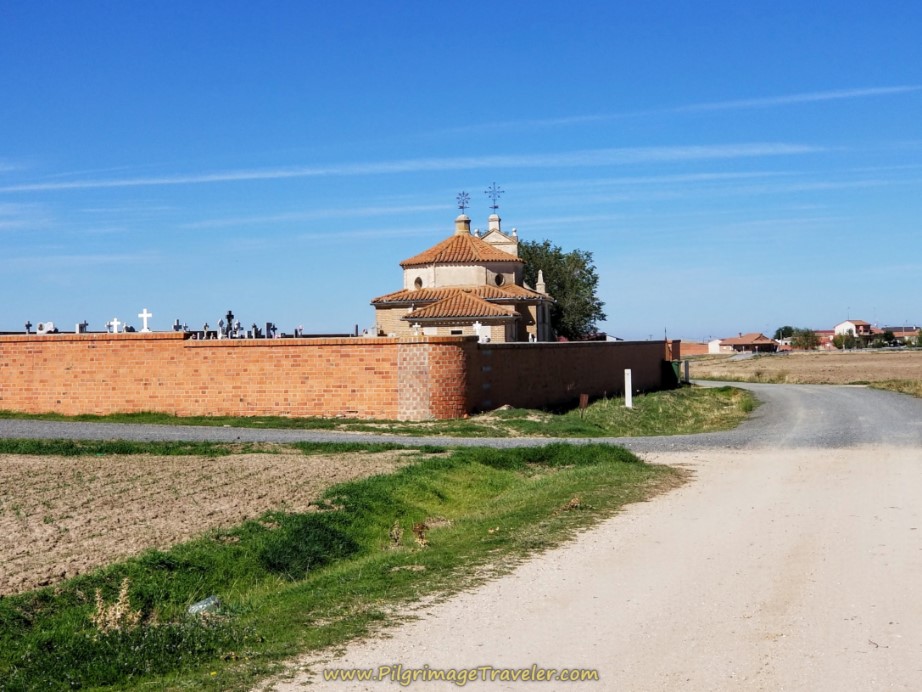
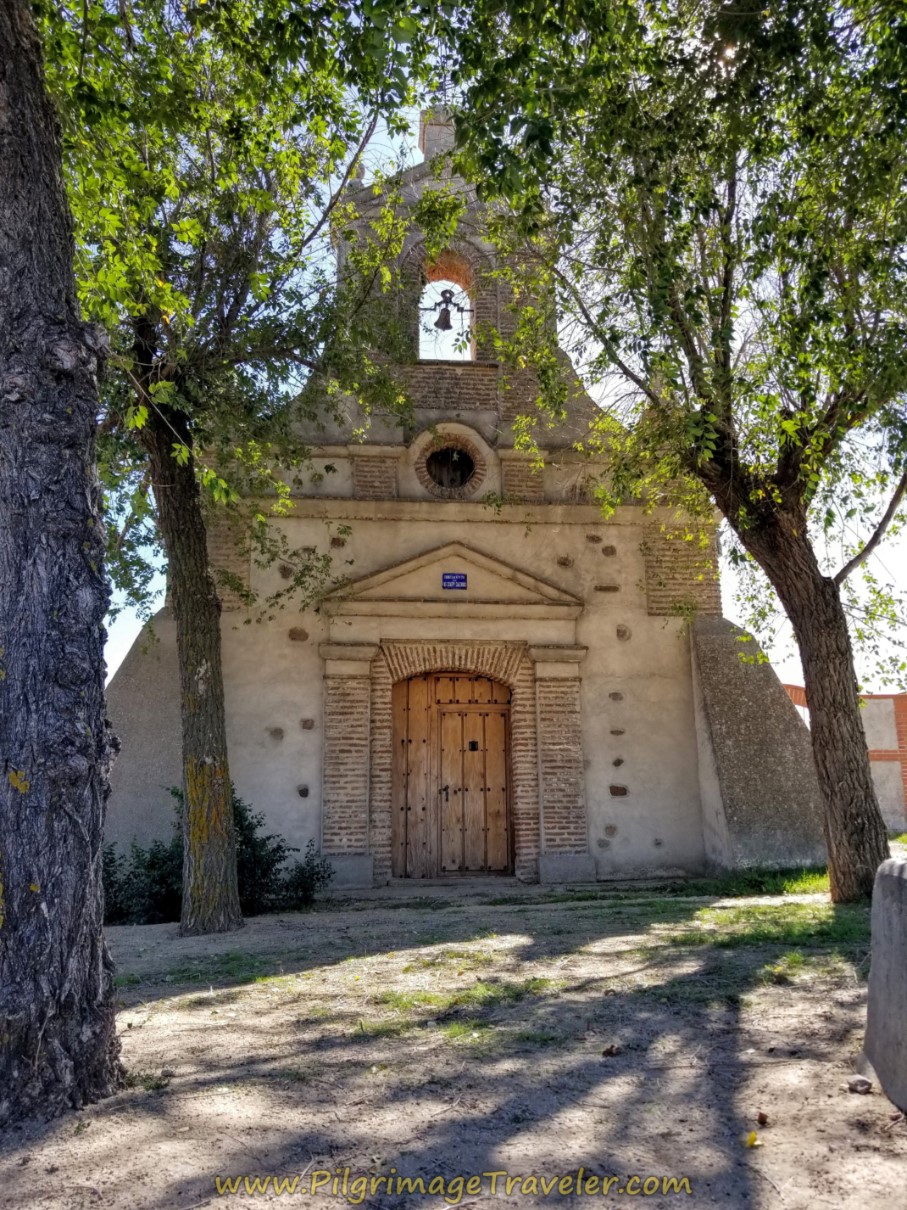
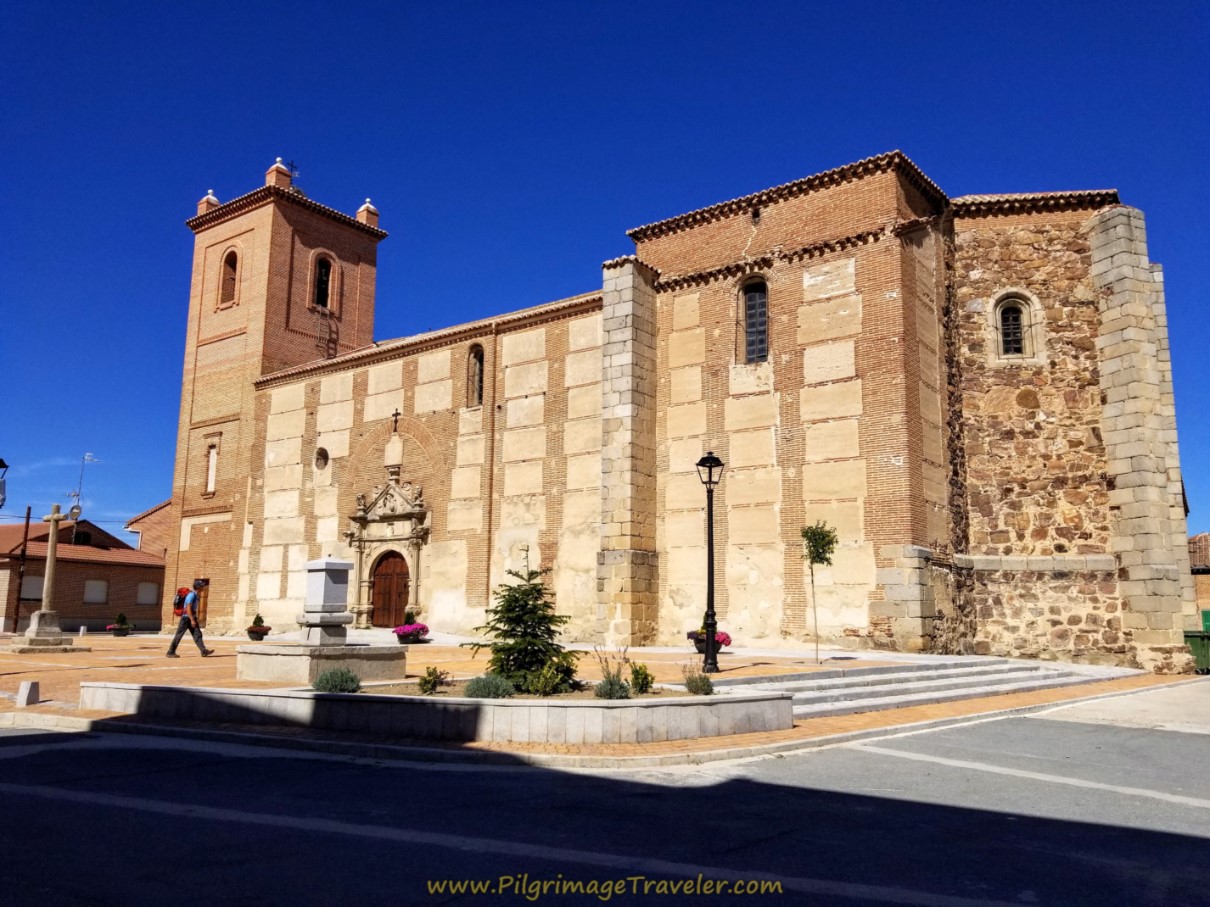

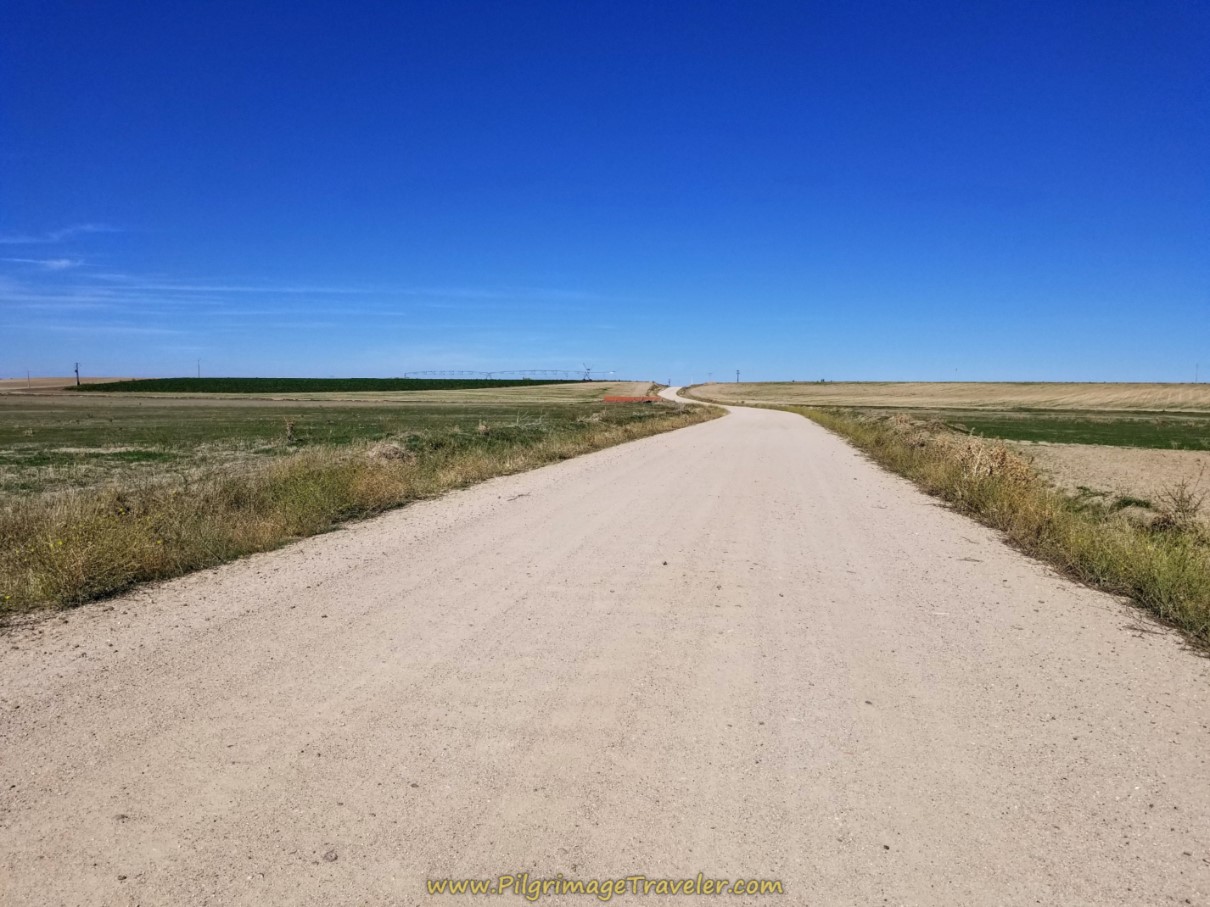
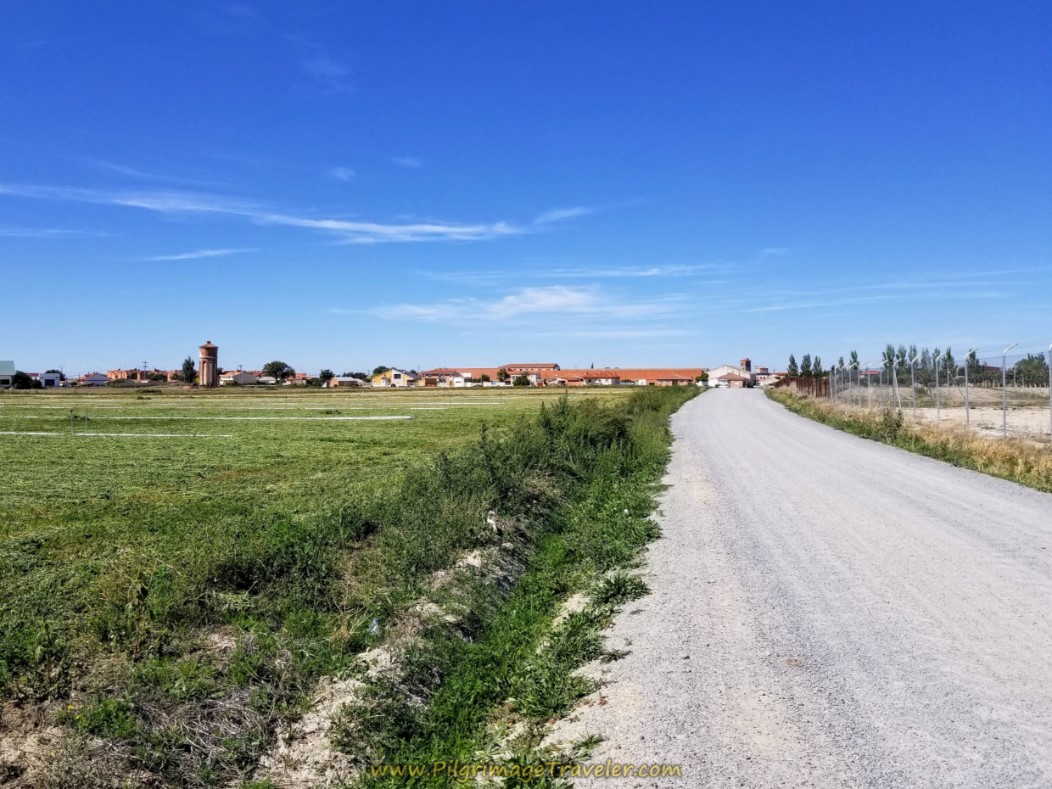
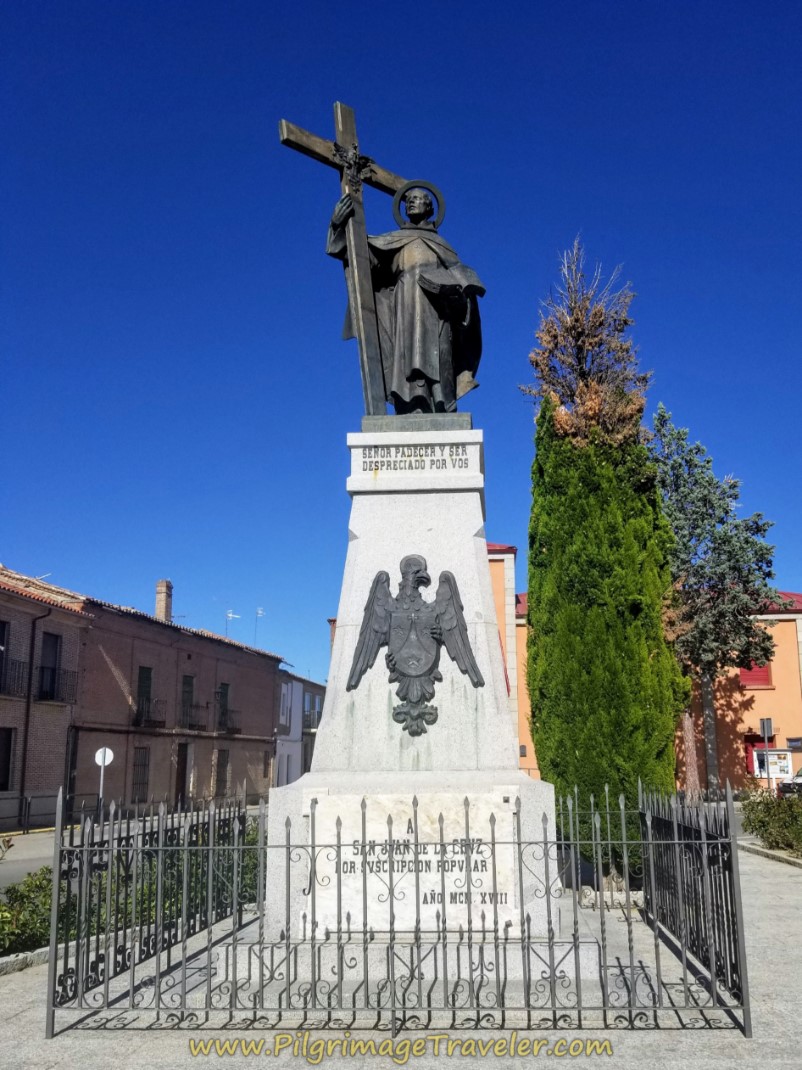
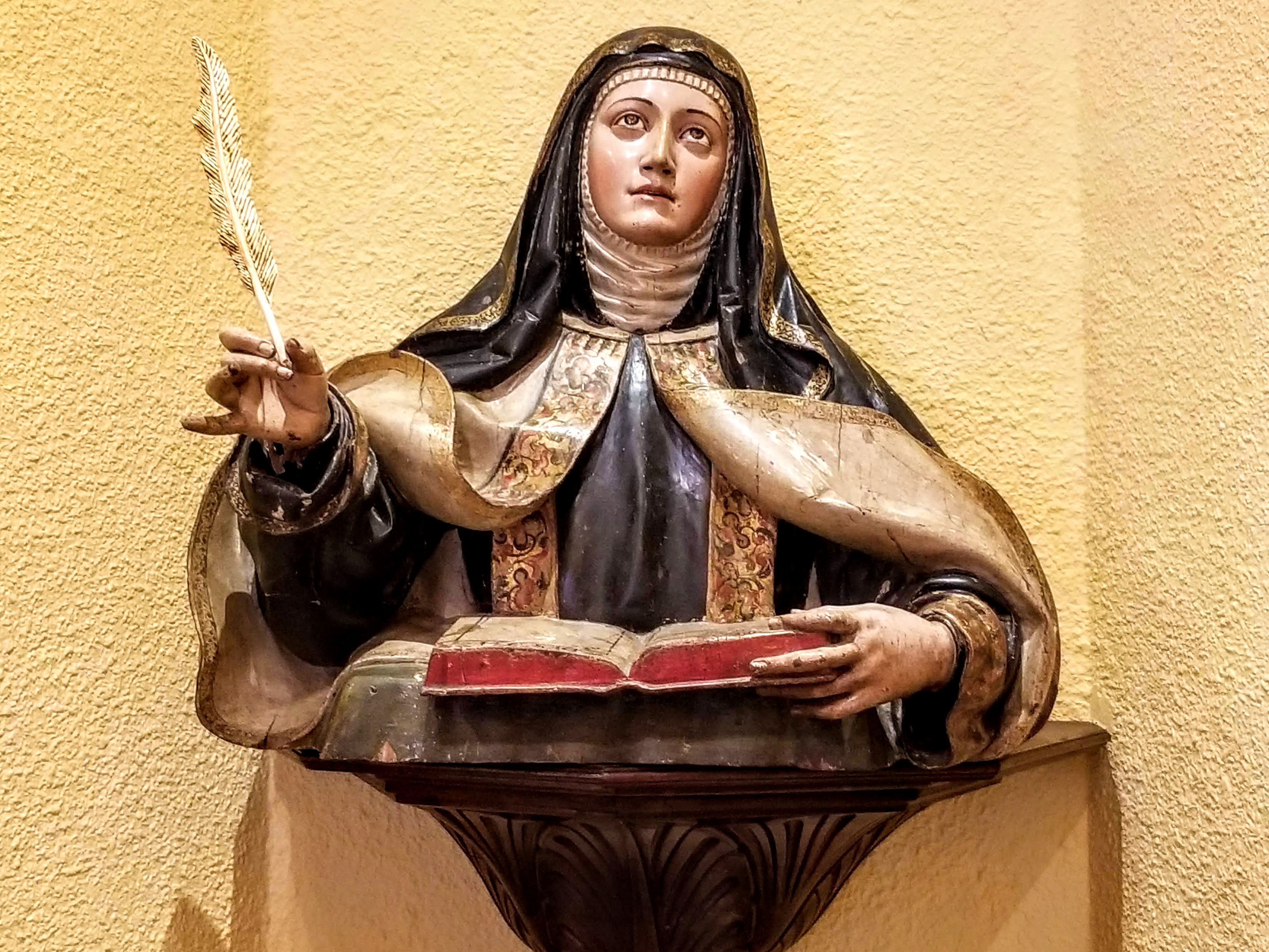
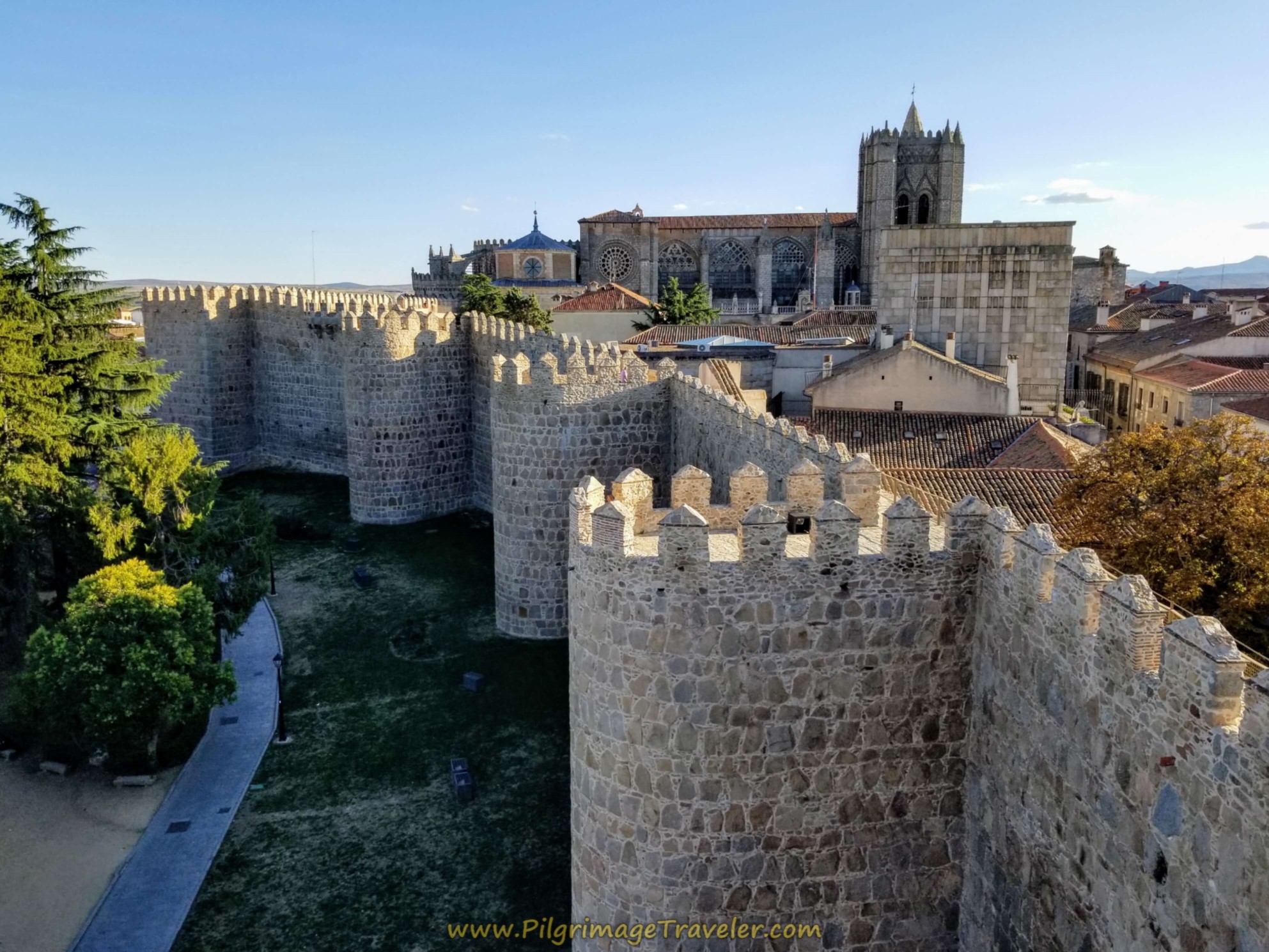
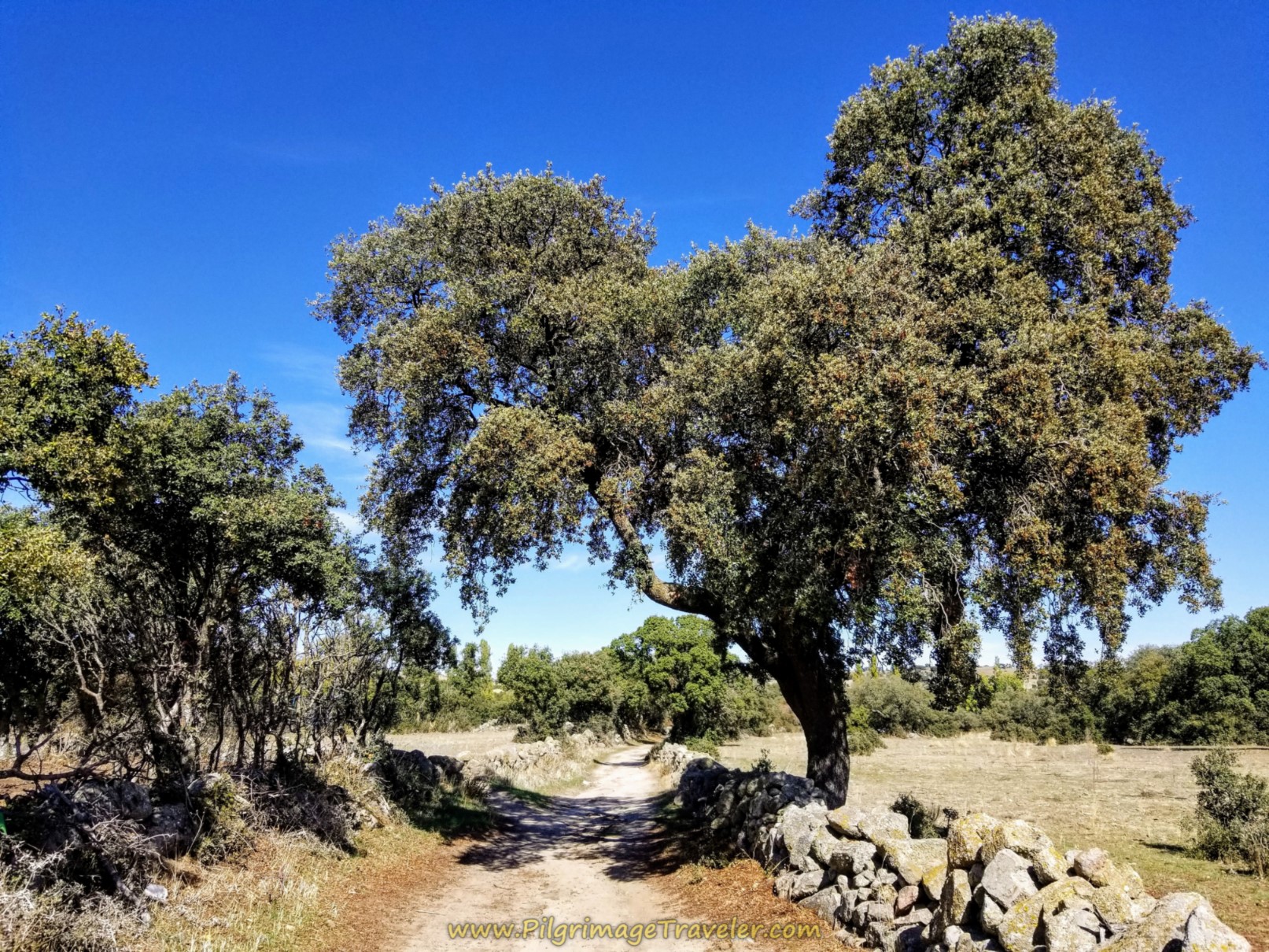
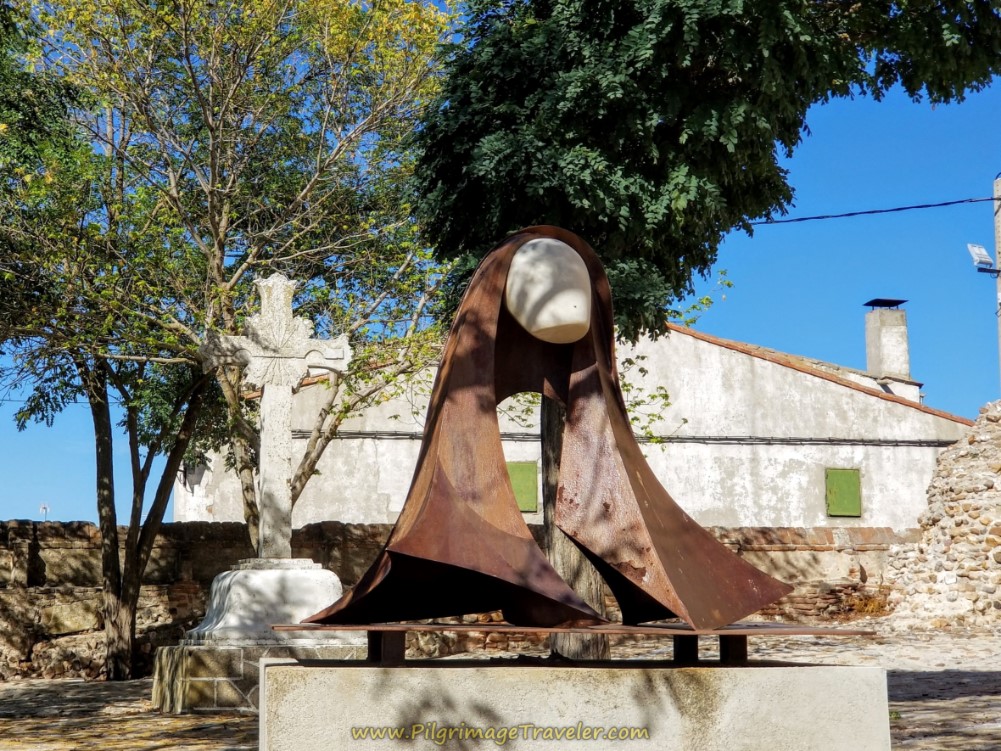
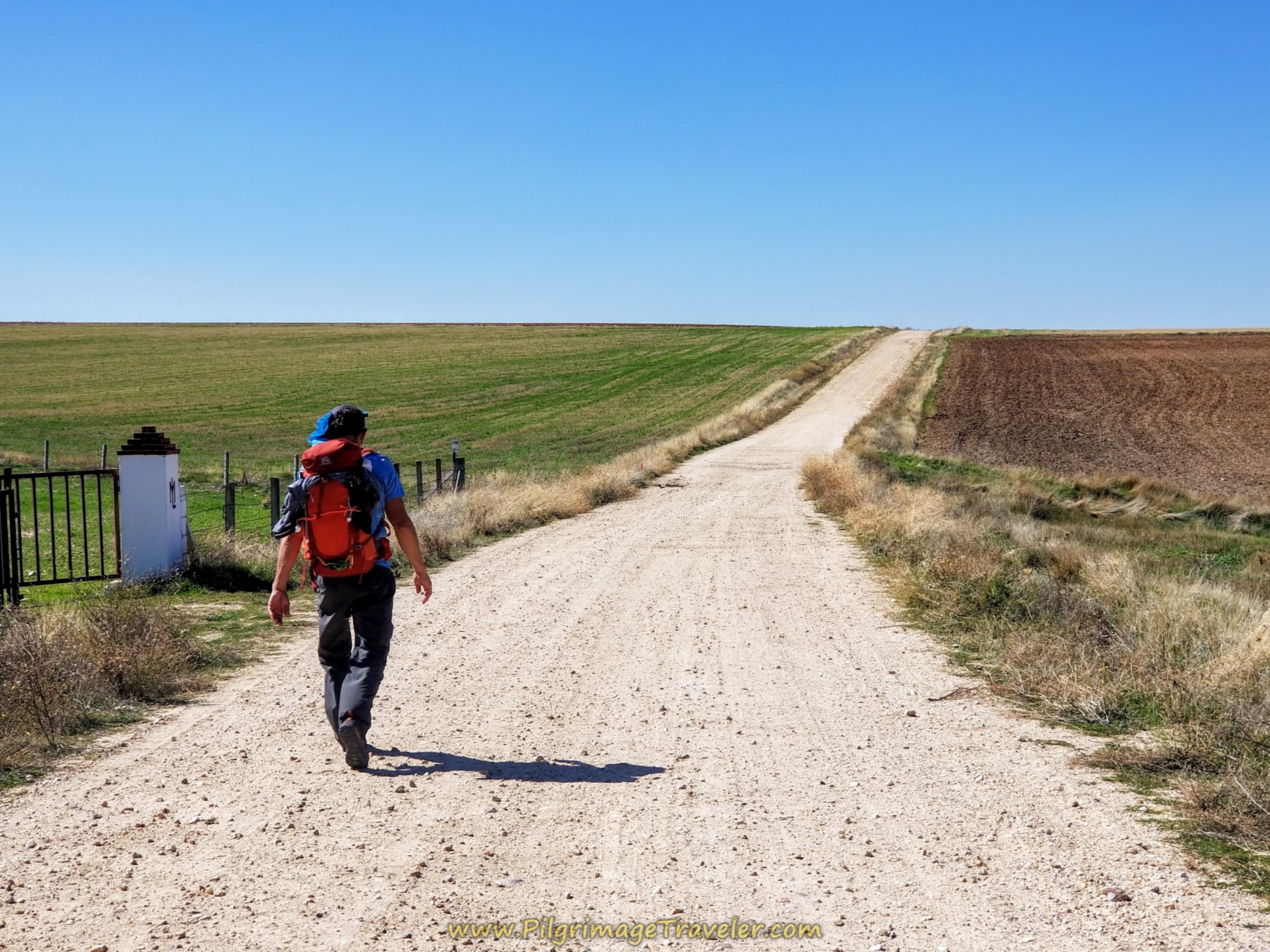
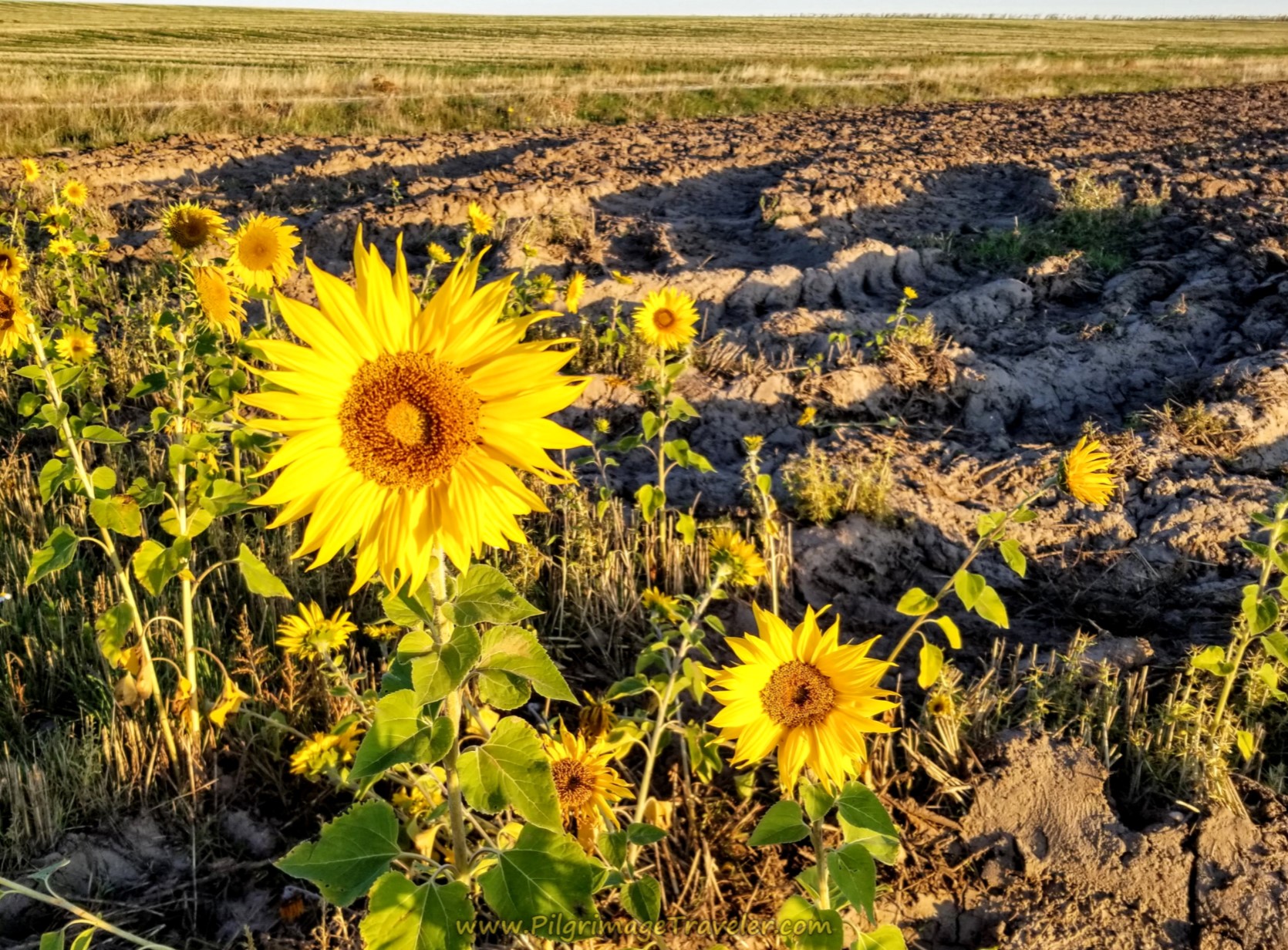
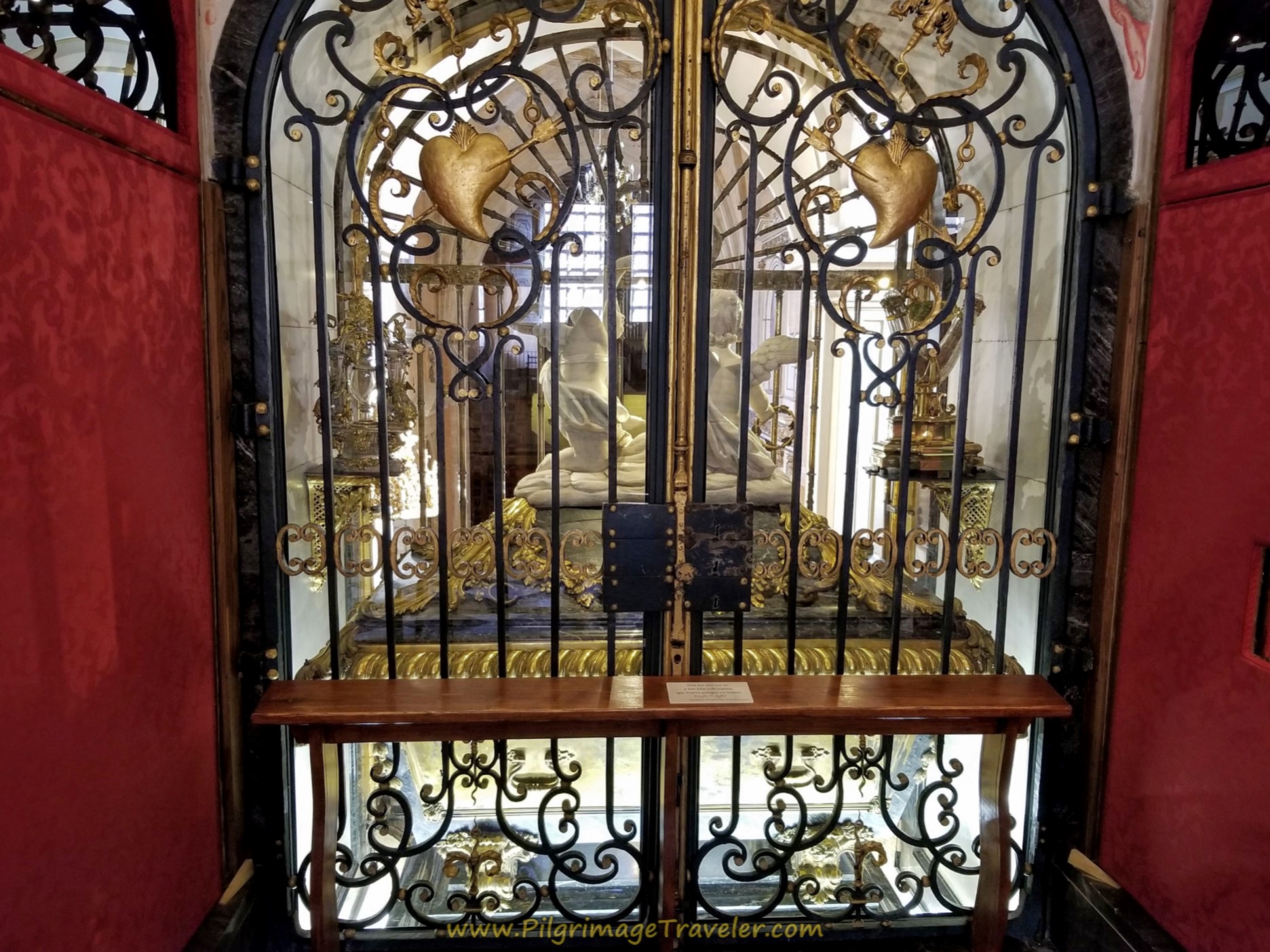
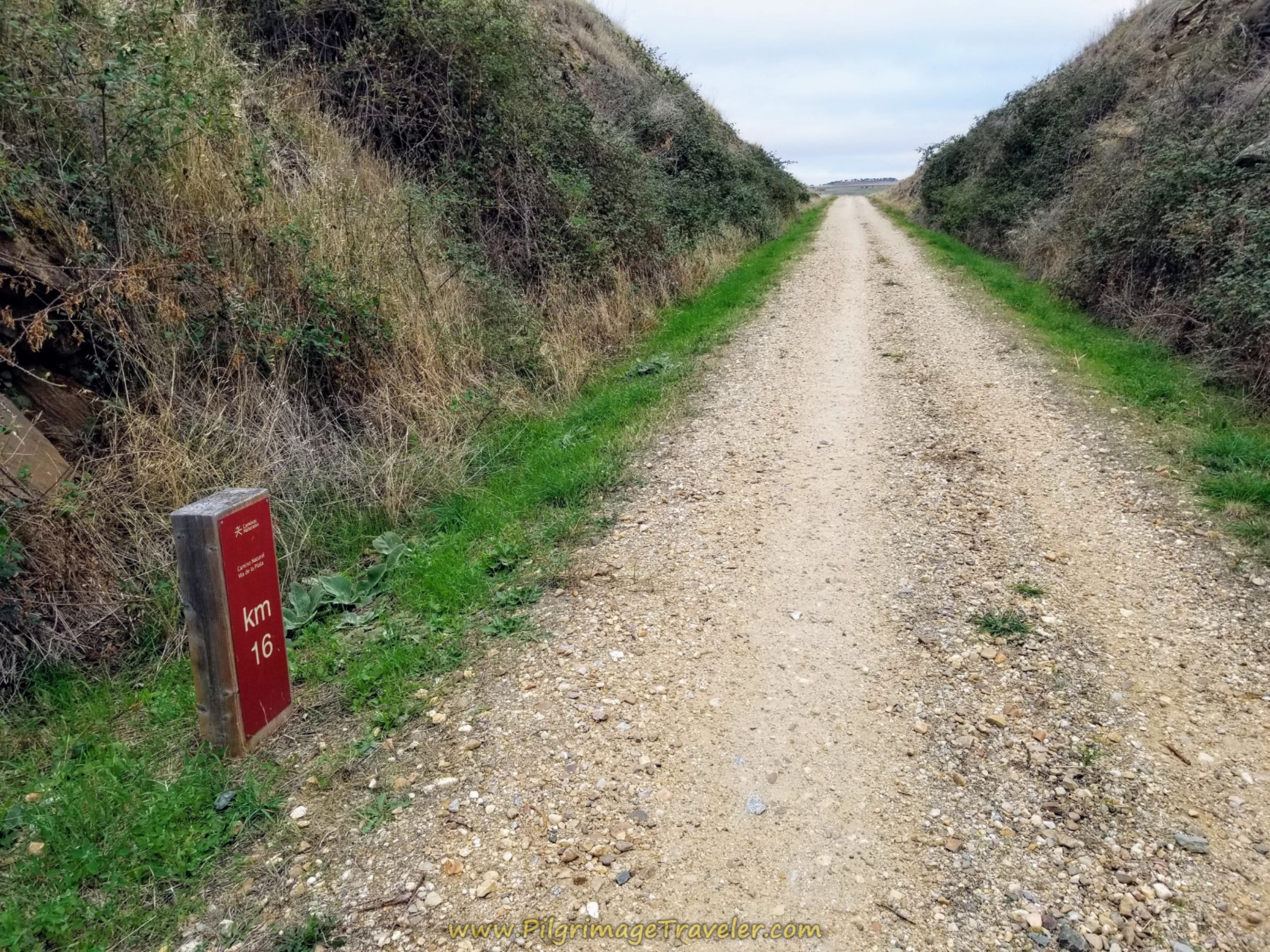
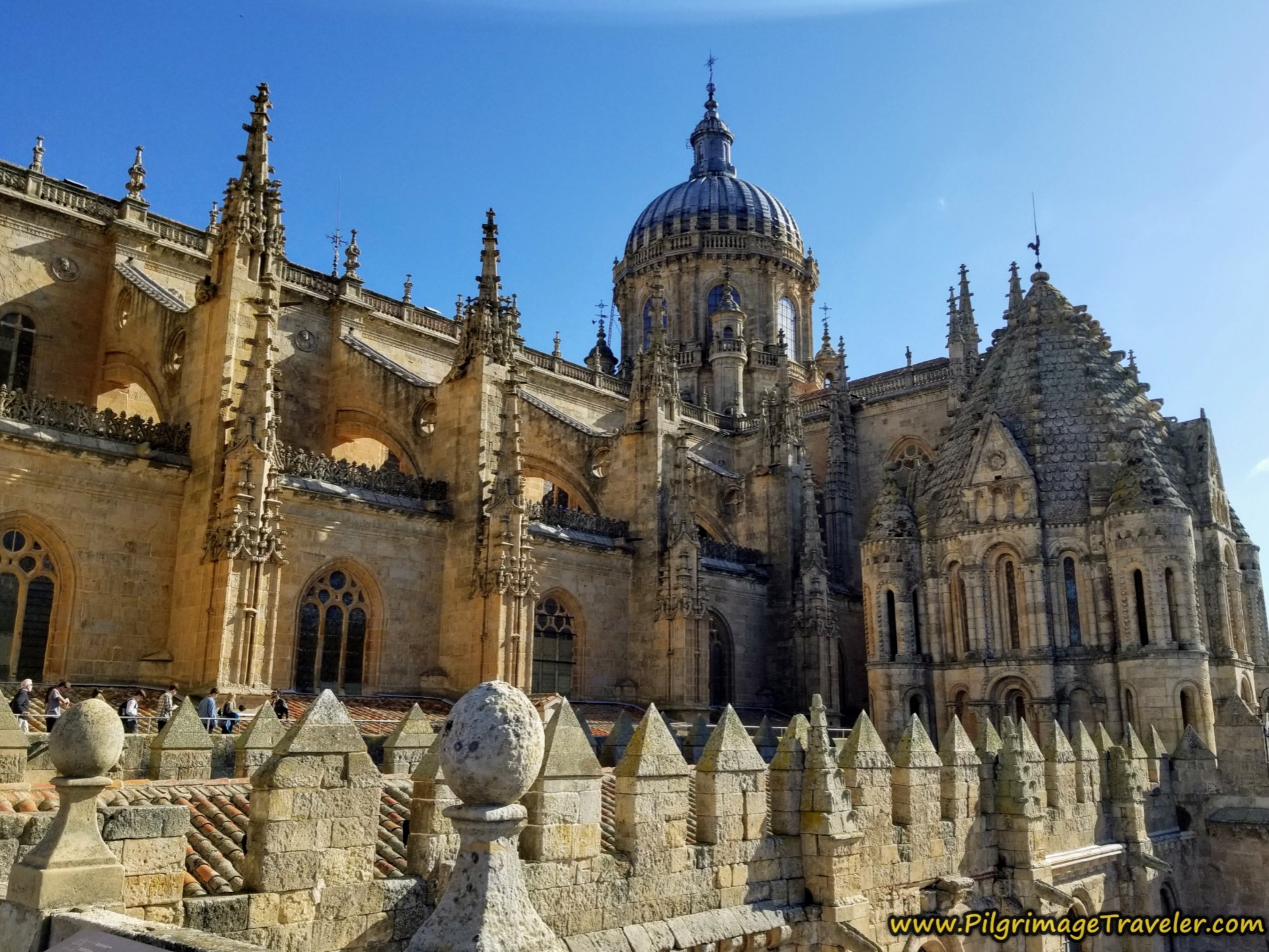











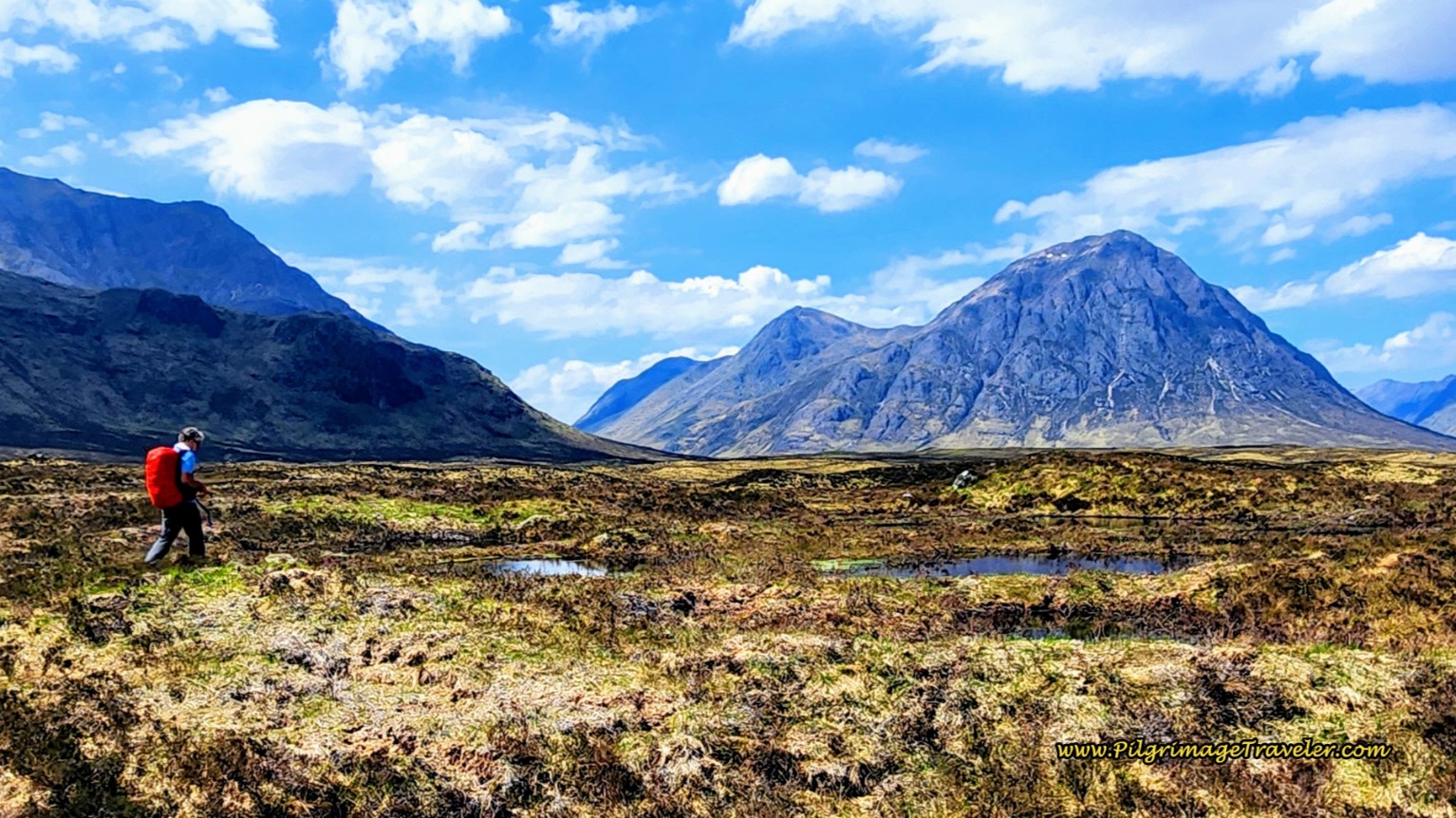
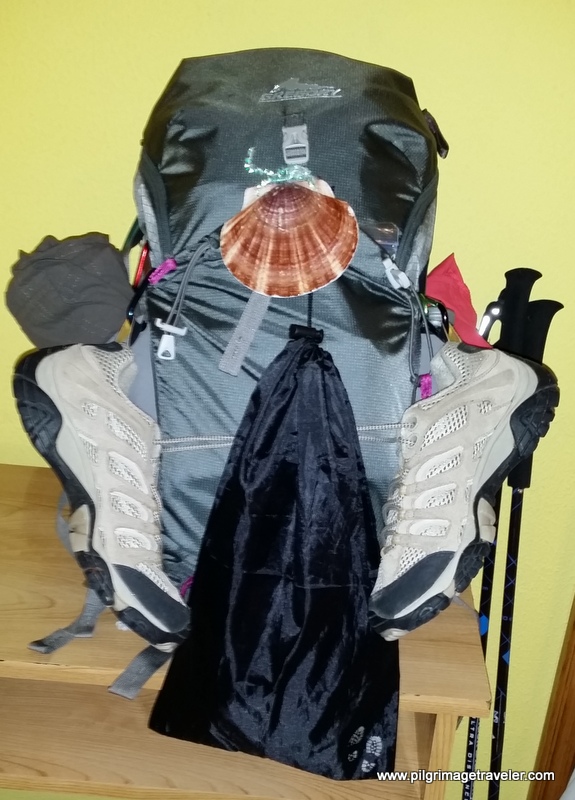

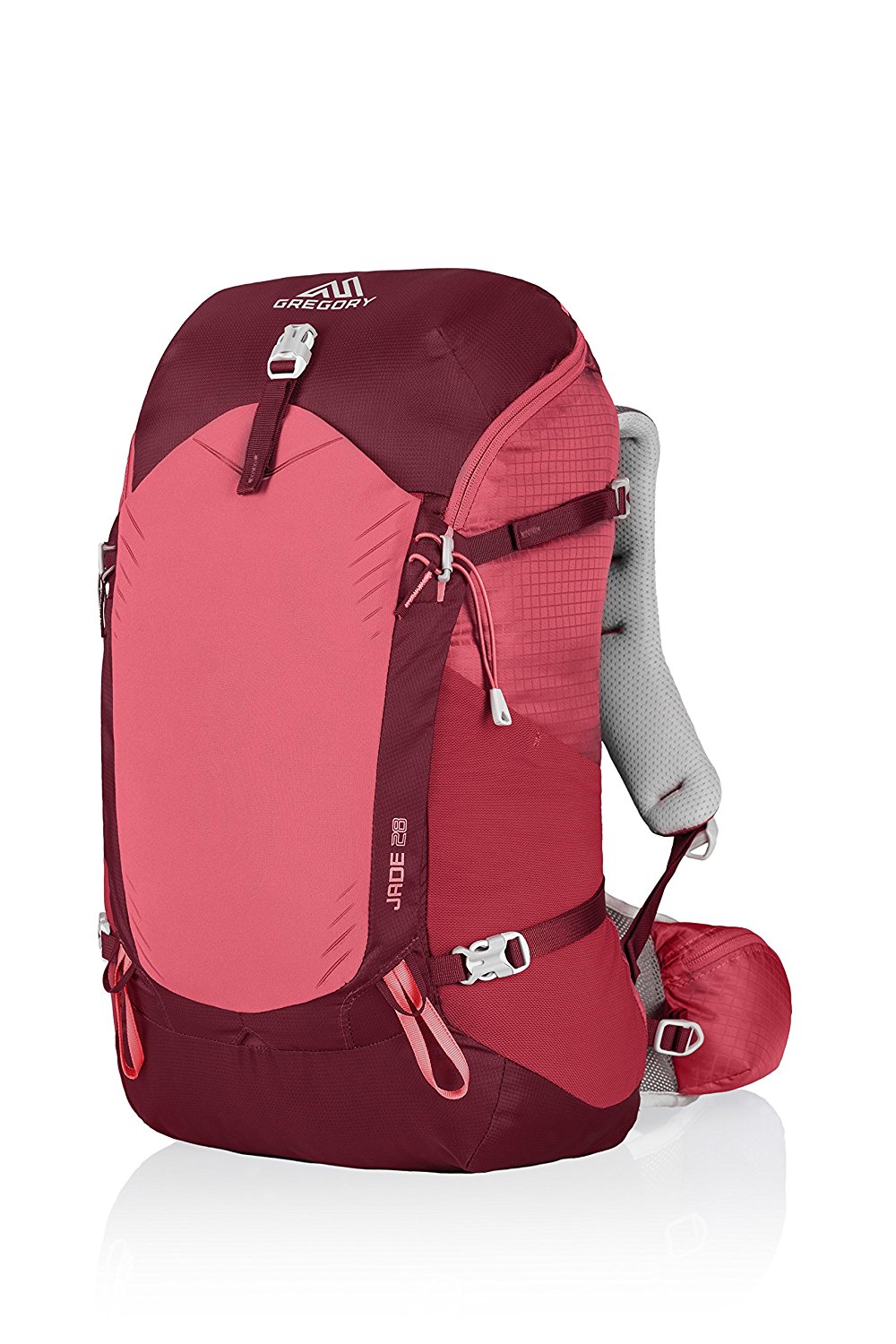

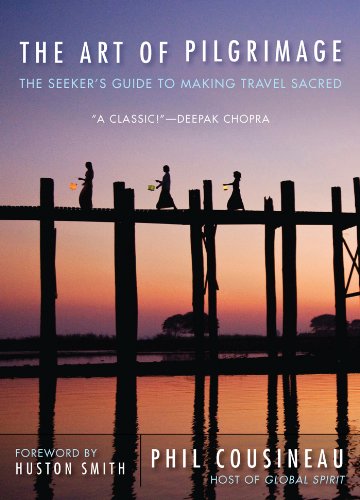


Your Opinion Matters! Comments
Have you had a similar experience, have some advice to give, or have something else you'd like to share? We would love to hear from you! Please leave us a comment in the box below.